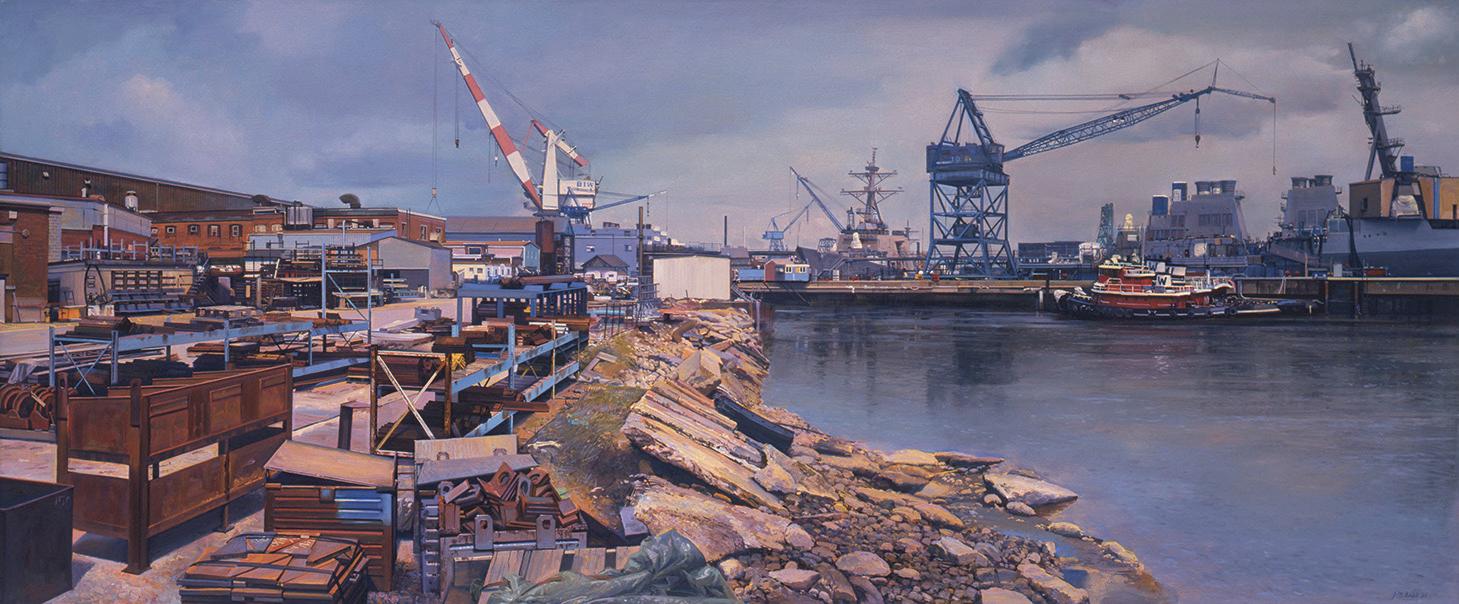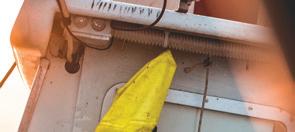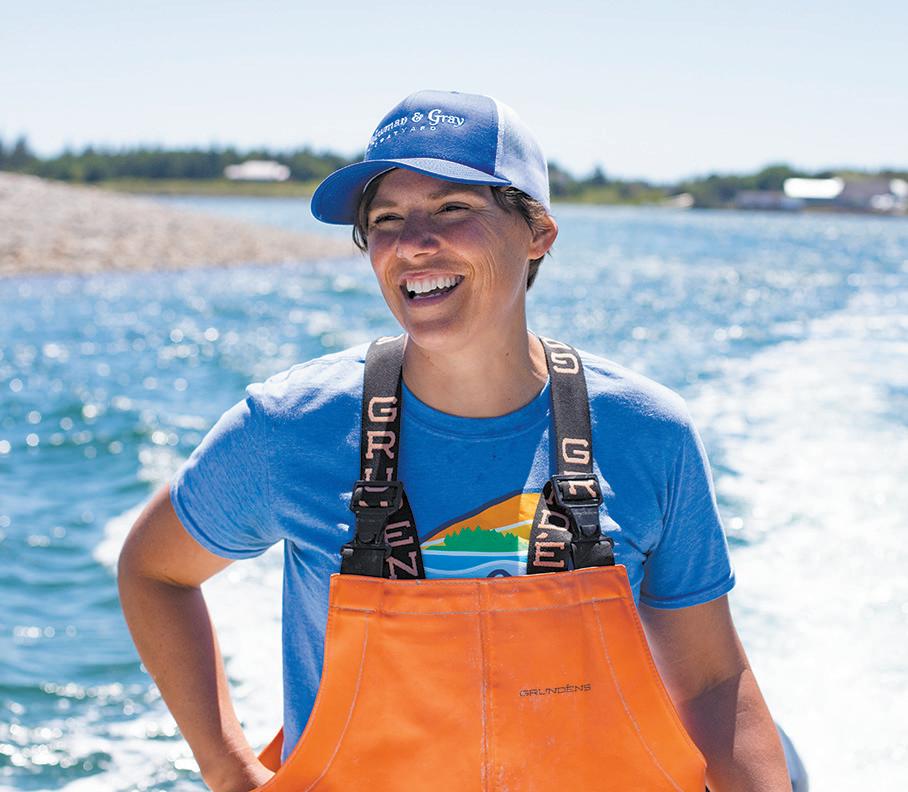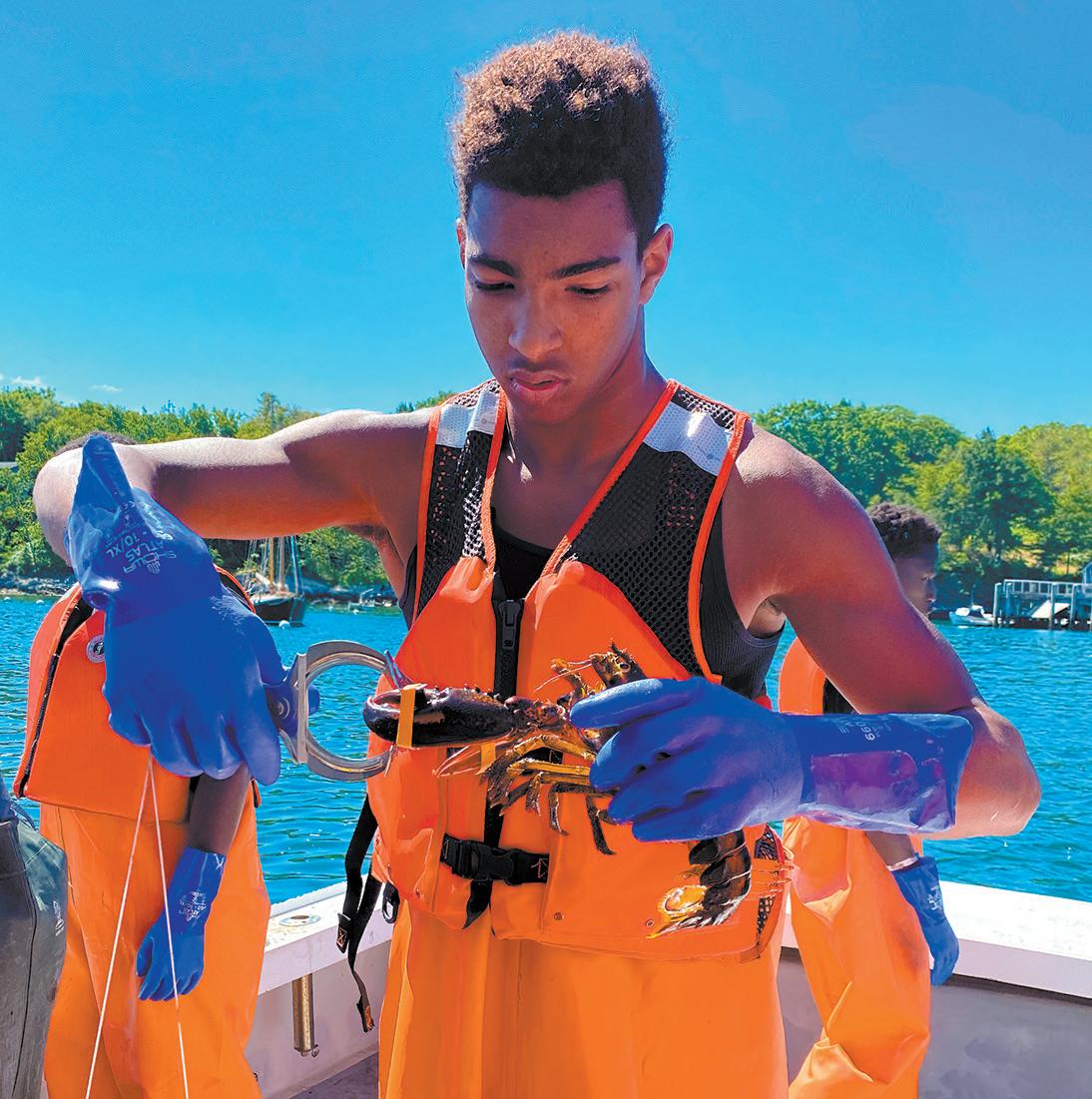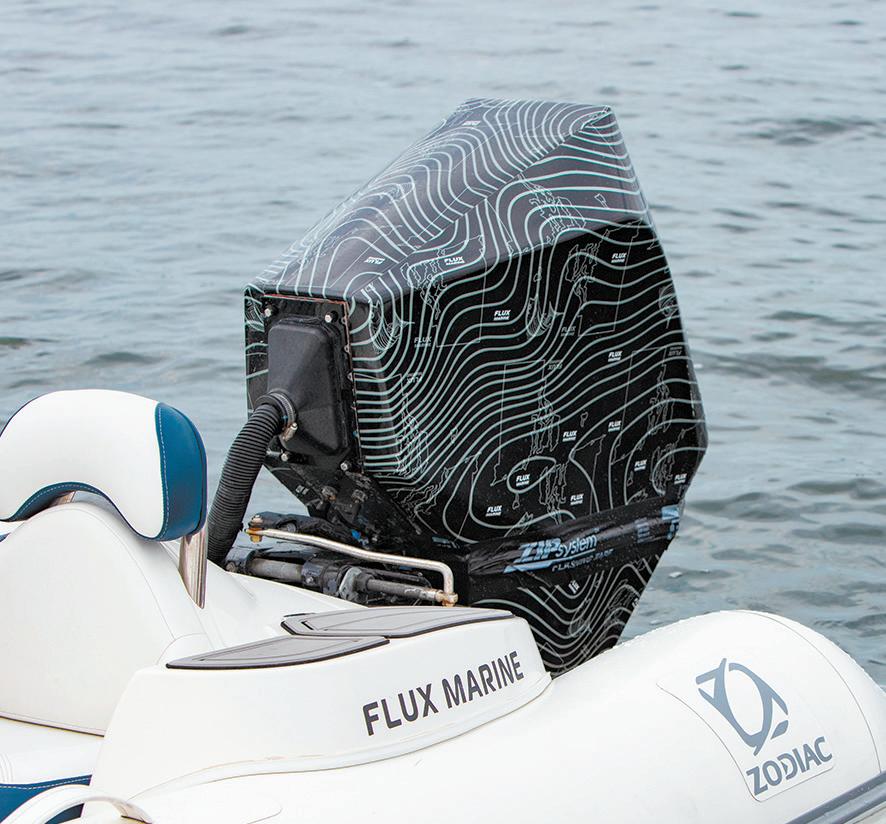his native island
By Tom Groening Photos by Michele StapletonCampbell “Buzz” Scott has a sunny demeanor and friendly smile for the old friends he runs into as we tour Matinicus, the island some 20plus miles off Rockland where he grew up. Now 62, he reminisces with women he attended school with on the island, and has a warm exchange with an older couple who provided a second home for him and other kids when things weren’t great with Mom and Dad.
But from my perspective, the moment that anchors this visit is when Scott stands outside the home he grew up in and casually gestures to a peapod on the lawn, hemmed in by weeds, its planking looking like it would give way to a hard kick.
“This was my first boat,” he says. “My mother bought it for me for $50. She said, ‘From now on, if you want something, you’ve got to earn it.’” Another islander gave him 25 traps, he remembers, and at age 12, Scott began his working life.
A few minutes later, he is a bit wistful, looking at his childhood home, now a seasonal rental.
“The lighthouse would shine in my window every night,” he said.
They say you can never go home, but of course you can. It’s just that when it’s Matinicus, you can’t easily make a daytrip by ferry, but you can if you visit by airplane.
And on Sept. 29, that’s what we did, flying on Penobscot Island Air on a cloudless autumn day. Along with photographer Michele Stapleton, we
joined Scott with the idea of seeing the community through his eyes.
I first met Scott at a conference earlier this year, where he had a table showing his work through the nonprofit he launched called OceansWide, dedicated to removing “ghost” traps from the ocean bottom.
Maine boatbuilding: Busy, but fraught Diversified industry faces labor, supply shortages
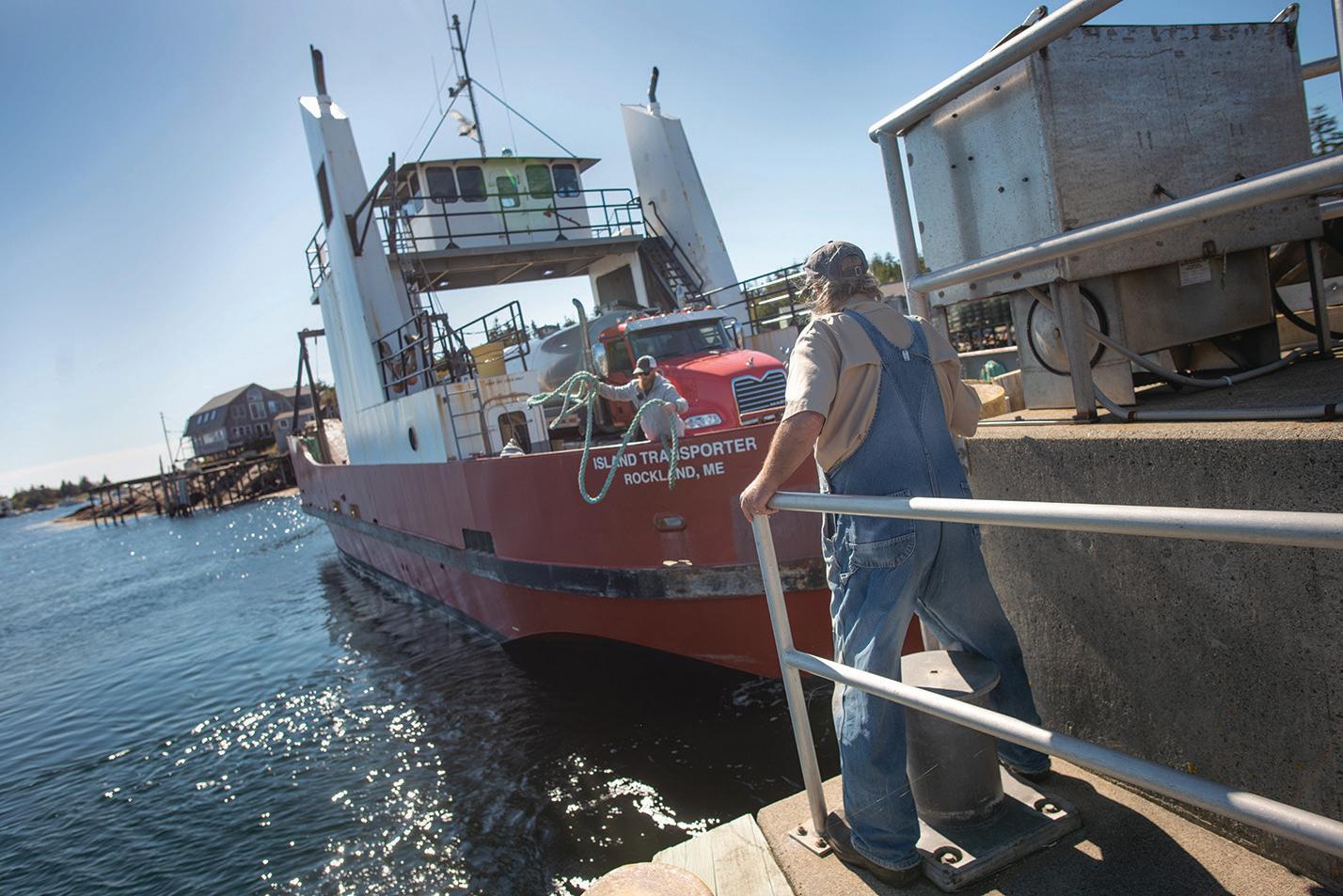 By Stephen Rappaport
By Stephen Rappaport
Think of Maine and some classic images come to mind. The North Woods. Blueberry barrens. A rockbound coastline dotted with tiny communities where fishermen land
their harvest of Maine’s iconic lobster. The image likely includes lobster boats moored in a placid harbor, often among handsome sailboats or sleek powerboats. Most of those boats, both the rugged fishing boats that bring millions of dollars of lobsters and other sea creatures
ashore each year and the elegant yachts, were likely built by Maine boatbuilders, continuing a tradition that dates back a century or more.
Maine though primarily used for recre ation by 21st century “rusticators.”
CAR-RT SORT POSTAL CUSTOMER
Historians name the 51-foot sailing vessel Virginia, launched by English settlers at the mouth of the Kennebec River in 1607, as the first ship built by Europeans in the New World, but even if one doesn’t look that far back Maine had a well-established boat building industry by the early 19th century. Shipyards along the coast built square-riggers and schooners that engaged in worldwide commerce—Bath Iron Works was founded in 1884—and countless boatyards built small fishing vessels, some, like the Friendship sloop and the peapod, still synonymous with
Boatbuilding
annual industrywide sales of more than $650 million and some 5,000 jobs.
According to the industry trade association Maine Built Boats, boat building in the state generates annual industrywide sales of more than $650 million and some 5,000 jobs. Many of those jobs are at the shipbuilder Bath Iron Works or larger yacht builders famous for their craftsmanship and technology, but there are also plenty of small boat shops where a few artisans—sometimes a single craftsman—hand build boats as elegant and technologically advanced as any.
Some builders craft boats that trace their lineage directly to the boats used a century or more ago for fishing in
in the state generates
“There’s 12 to 15 million traps in the ocean,” he says, most because their lines have been inadvertently cut by a boat’s propeller. To get an idea of the scope of the problem in Maine waters, Scott reports his group removed 3,000 from the inner region of Boothbay Harbor, all in 60-feet of water or less. Only about 20% were reusable, he said.
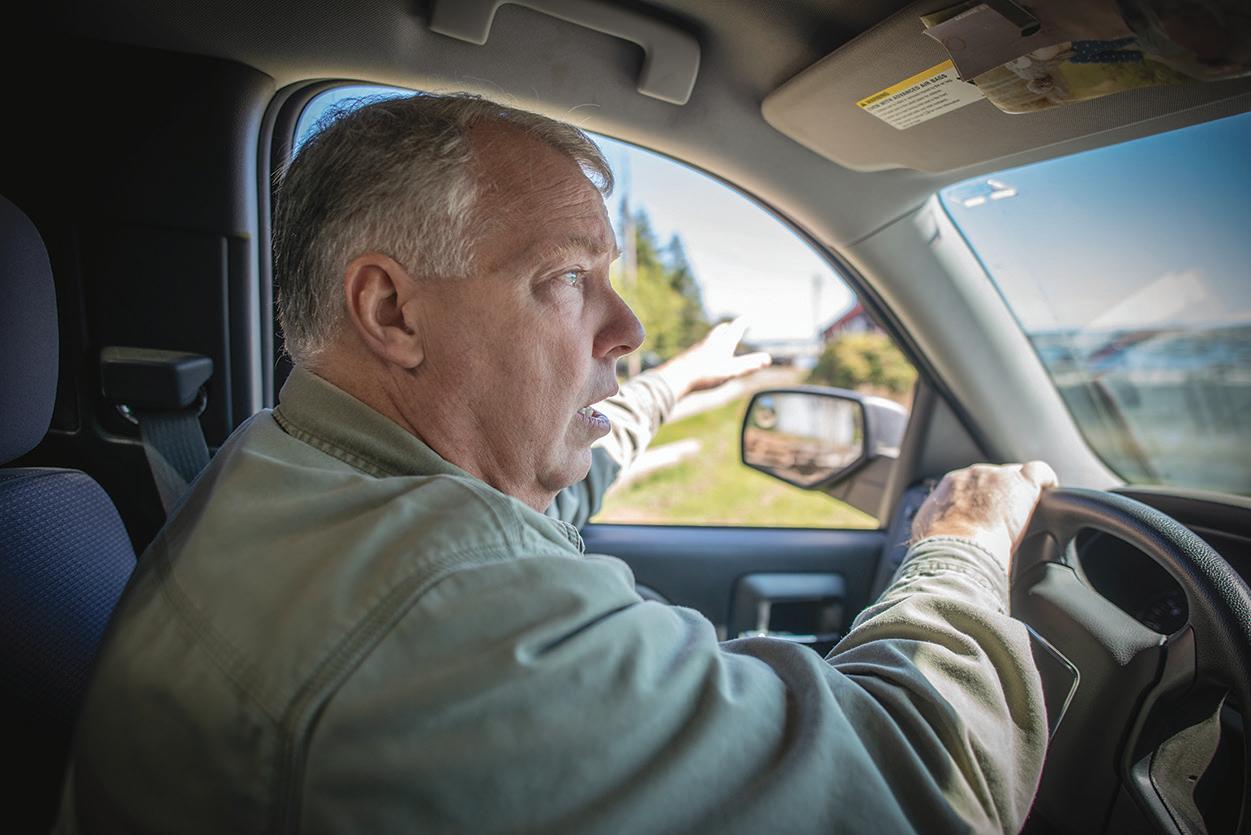
At one point during our visit, we stop and get out of a borrowed pickup near the harbor, and Scott gestures to a pile of traps—hundreds of them—tangled in a patch of what looks like wild raspberries.
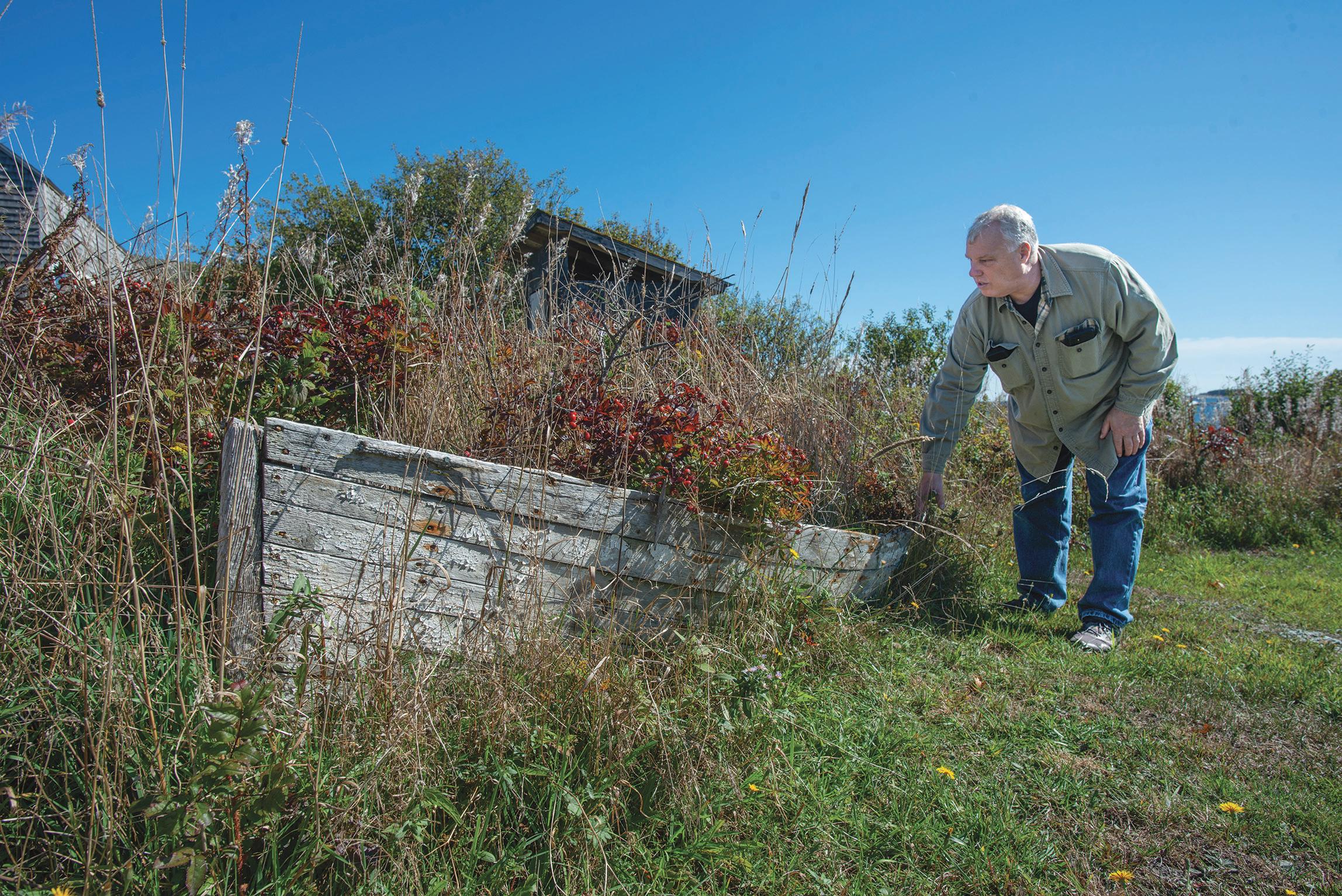
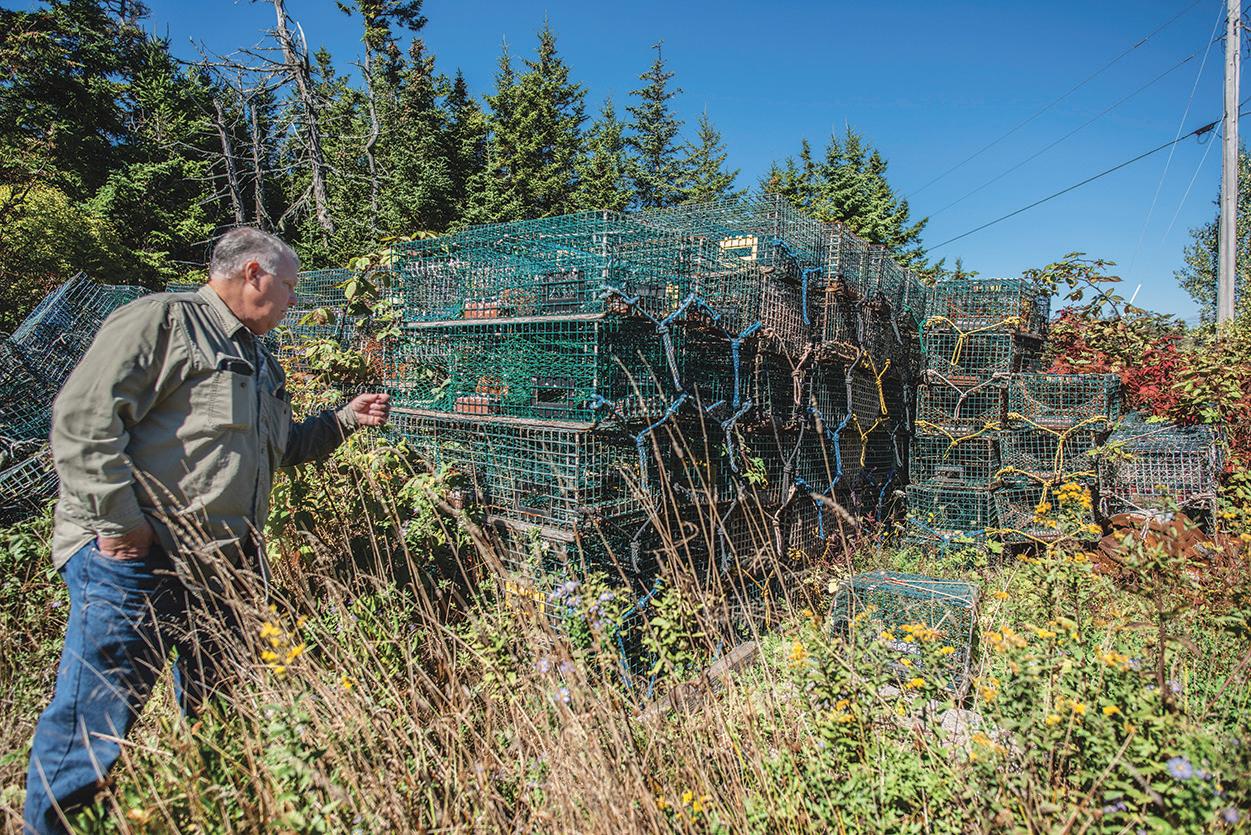
“This island has thousands of traps on it,” he says. “When I was a kid, the island was pristine.”
A few minutes later, we walk to the working part of the harbor and see a lobster boat tied to the pier, traps being lowered aboard. Scott calls out to the men at work and confirms that they are taking decrepit traps to the mainland where they will be disposed of at a municipal trash center.
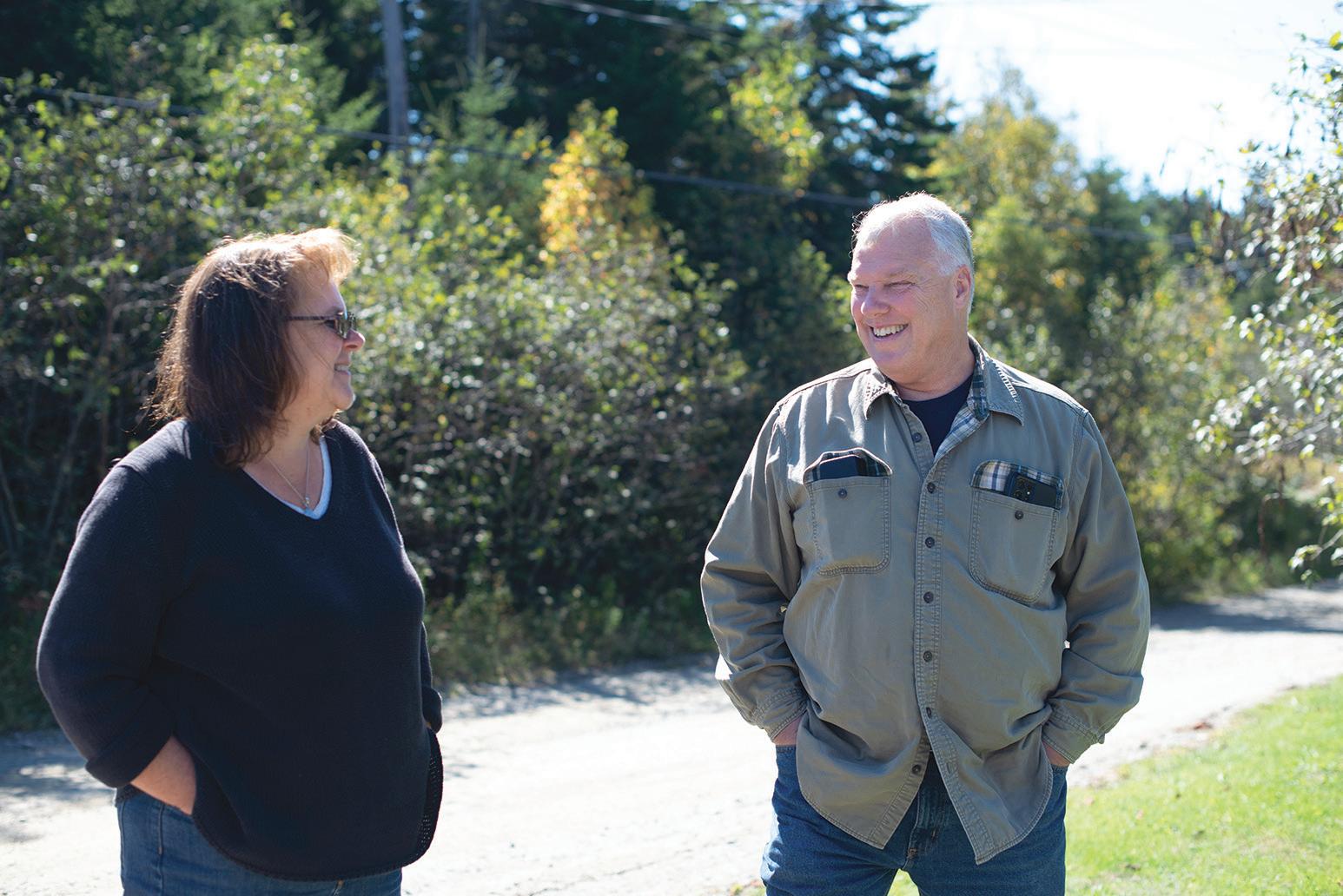
OceansWide has developed equipment to crush the traps, but recycling markets are elusive. The process begins with the wooden runners, hard plastic escape vents, and woven heads being removed.
“We’re working with Maine Sea Grant and Haystack,” the crafts school on Deer Isle, to find other uses for the escape vents, Scott said.
“They know they have a logistical issue that they haven’t dealt with in 30 years,” he said of Matinicus islanders, but now, the community agrees the gear must be removed, for which he is proud.
Scott is working with the owner of a pier on the harbor to purchase the property and set up a trap removal operation for OceansWide.
Not surprisingly, traps and boats and fishing have been a big part of Scott’s life, though that life took him far from the Gulf of Maine.
“My mother came out here when I was three,” then at about age ten, the family moved there perma nently. The house had no indoor plumbing and no electricity then.
“I basically learned to read like Abe Lincoln, with a candle burning,” he says with a smile.
“I fished with everybody out here and had boats of my own,” he said, and in his 20s, he flew a two-seater airplane, working as a spotter for an island herring fisherman.
But at age 27, an older man gave him some advice.
“I was good friends with Clayton Young, who owned the store,” Scott remem bers. Young took him aside and suggested he consider seeing the wider world.
The store burned to the ground in 2008. Scott remembers older men, World War II veterans, sitting around the stove in winter and telling stories about the island.
Despite the memories, Scott took Young’s advice and left, joining the Navy Seabees, a construction division, and served four years of active duty, including during Desert Storm in 1990-91.
“I’ve stood up and fallen into more things than I care to tell you about,” he jokes. He studied engineering, biology, and architecture at the University of Maine, then, “My first wife dragged me to Oklahoma.”
He met an old friend in Colorado who offered him the opportunity to work for a research project in Antarctica. That led to 34 trips over ten years to the region, working for Monterey Bay Aquarium’s research institute.
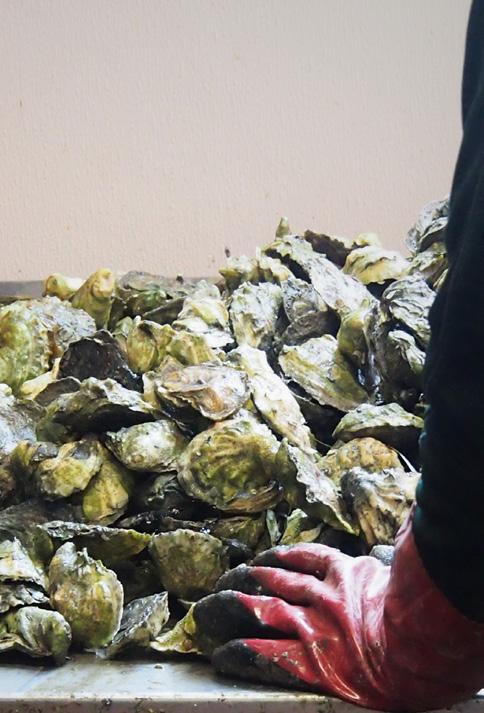
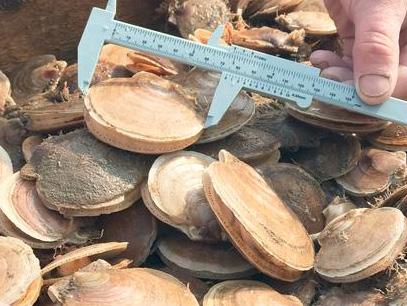
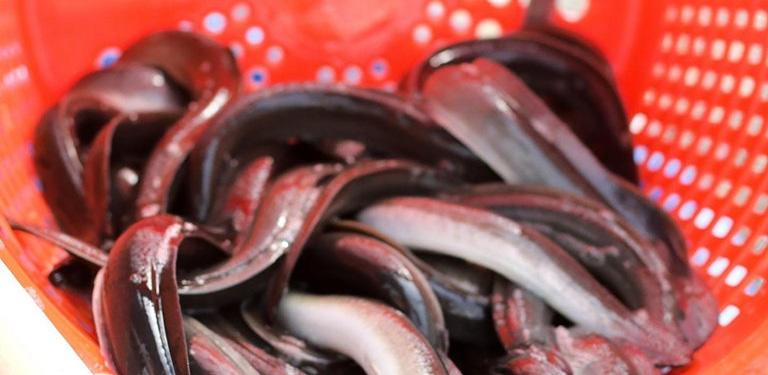

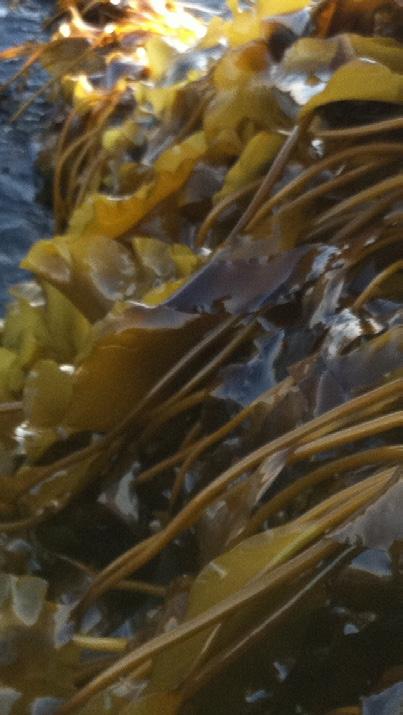
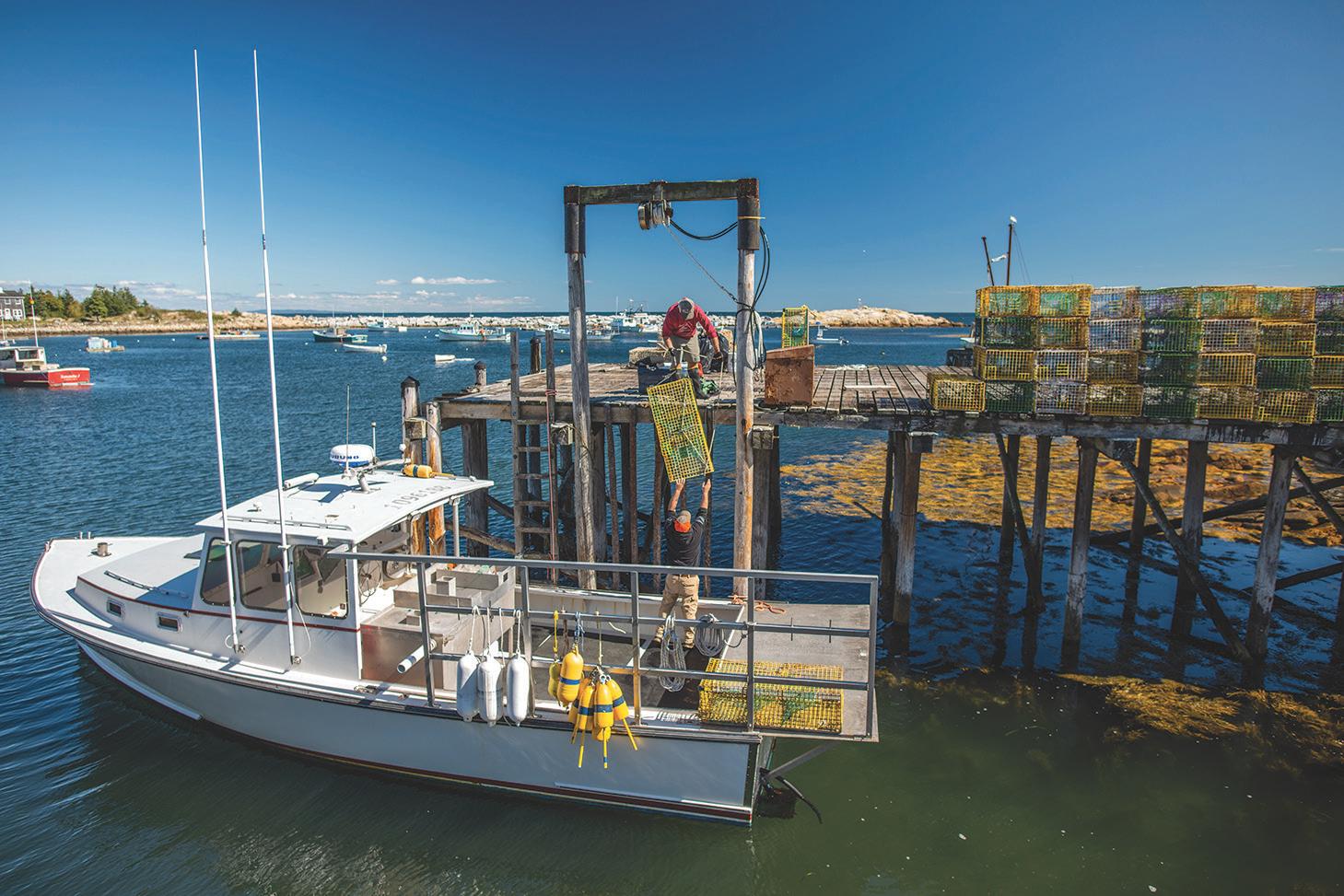
For a time, he worked for Bob Ballard, famed for having discovered the wreck of the Titanic, doing searches over other wrecks. He also worked on the Deepwater Horizon oil rig in the Gulf of Mexico, five years after the oil leak there.
Scott lives in Newcastle now, but finds himself visiting Matinicus often. Walking and driving around the island, that familiarity is evident in waves and shouts of “Hey, Buzz!”
Islander Laurie Webber greeted us at the unpaved island airstrip, and we pile into her truck, drive to her house, and then she loans it to Scott.
“Back when we were kids, we all knew each other, we shared all our property,” she says. After leaving for the mainland for years, Webber now lives on the island from April to November. Her husband has fixed up the family homestead.
“My kids are fifth-generation owners,” she says.

At the harbor, we see the Island Transporter, a private ferry service, arrive with a septic pumping truck coming onto the island. Paul Murray assists the driver.
“He keeps everything running,” including the island’s electric grid, Scott says of Murray.

On our tour, we stop at Donna Rogers’ house and sit in her kitchen. She lobsters here during the warm months. Recently, she says, there has been a lot of activity in the real estate market.
“We had a big influx of homebuyers,” she says, with five or six new owners, probably related to the pandemic.

Reminiscing with the older couple who were at times surrogate parents, Scott tells a story about working on a herring seine and having two friends throw him into the net as a sort of initiation. He also recounts the time a humpback whale crashed through the net, eliciting a laconic response from one man: “Huh!”
The easy conversations Scott shares with these old friends speaks of a rare bond, maybe even intimacy, imparted by growing up on an island. It’s clear he relishes being here.
Growing up here in the 1960s, it was even harder to get to and from the mainland.
“That’s the big change,” he says. “No one went ashore in those days.”
The peapod he fished from as a boy, hauling traps by hand, is returning to the island soil. Scott hopes his plans for cleaning up the island’s derelict traps is a way to continue working here, and a way to give back to the community that he loves.
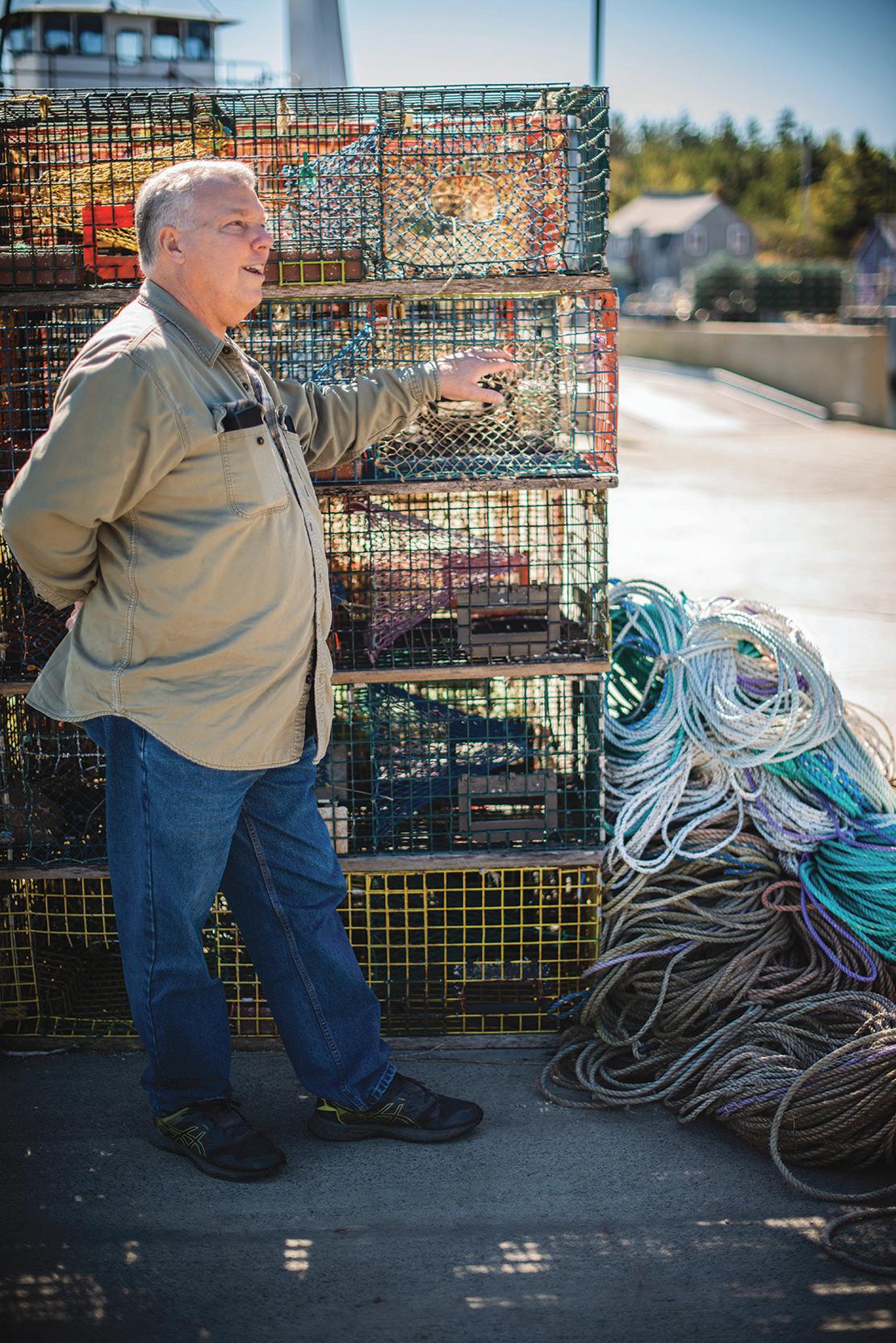
BOATBUILDING
continued from page 1
Casco Bay, around Vinalhaven, or Beals Island, with the modern lobster boat’s lines developed by designers such as Calvin Beal Jr., Ernest Libby, and the Lowell brothers—Royal and Carroll—among others. Some shops build sail or powerboats from the lines of such iconic yacht designers as Nathaniel Herreshoff or Maine’s own Joel White, or work with naval architects from around the world who draw boats at the leading edge of design.
Some boat shops are run by artisans who learned boatbuilding from their fathers or grandfathers. In Bass Harbor, Richard Stanley builds wooden lobster boats and sailboats using techniques he learned from his father, Ralph Stanley, famous for his Friendship sloops. In Yarmouth, the Lowell brothers are sixth-generation boatbuilders, descended from the legendary Will Frost, the “father” of the modern Maine lobster boat, who began building Maine’s first enginepowered fishing boats on Beals Island more than a century ago. And there are a great many small boat shops along the coast without the historical connec tions but still building classic wooden boats—sailing and power, working or recreational.
Some of Maine’s best-known yacht builders also have deep connections to Maine’s boatbuilding history.
Hodgdon Yachts, founded in 1816, is still family run and builds elegant custom sailing and power yachts, and high-speed tenders for megayachts, in East Boothbay. A few years ago, Hodgdon built an enormous oven at its boat yard to bake the carbonfiber hull and components for a record setting 100-foot sailing yacht.
Hinckley, synonymous with fine American yachts, builds its picnic boats, powerboats, and sailboats a few miles up the road from the Southwest Harbor boatyard where Henry R. Hinckley started the company in 1928 and built his first boat in 1933.
Lyman-Morse, a relative “newcomer” founded in 1978, builds custom yachts in Thomaston, continuing a tradition of boatbuilding in the former Morse family boatyard dating back more than a century.
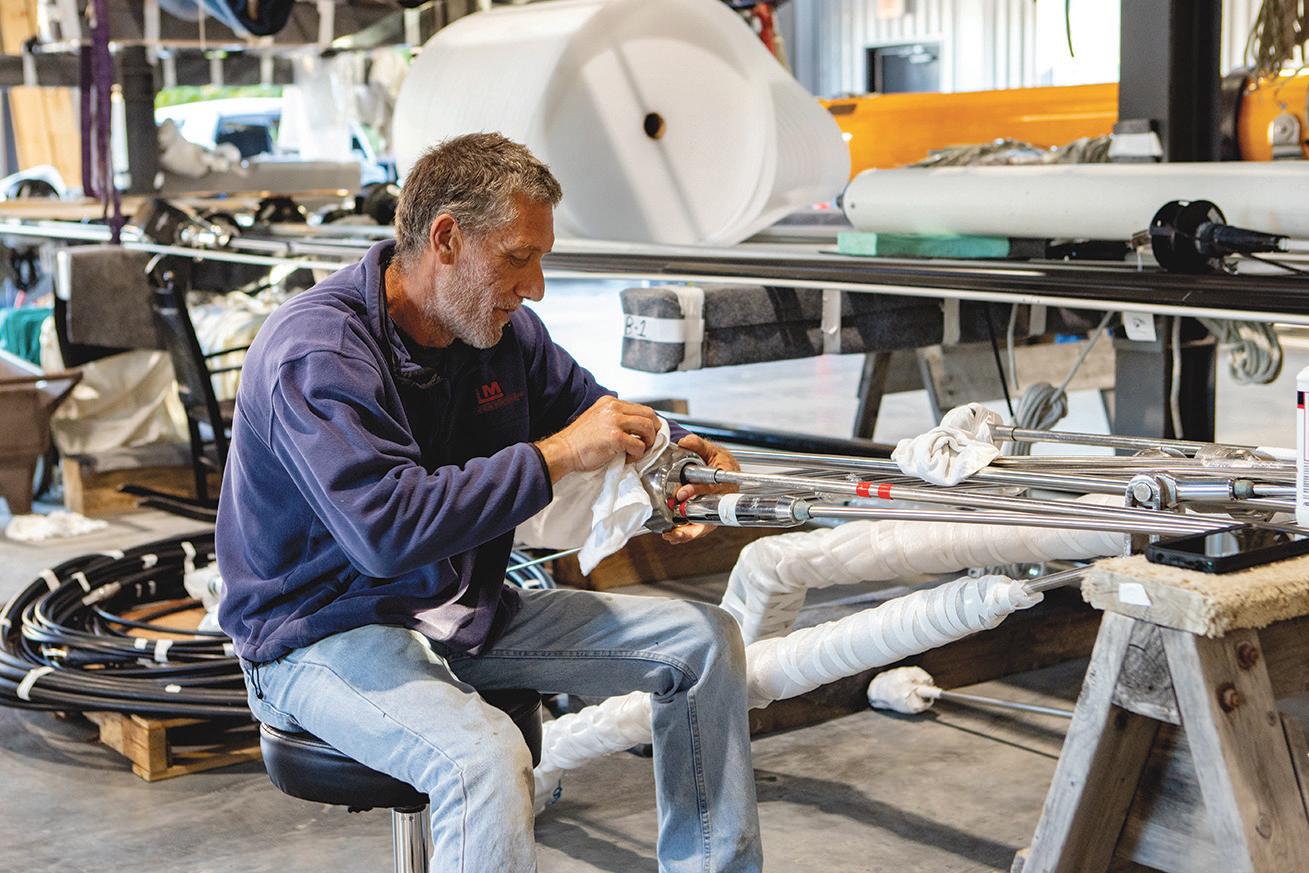
Sabre Yachts, founded in 1970, and the younger, related Back Cove Yachts, may lack history but not pedigree. Virtually unique in Maine, Sabre and Back Cove sell their motor yachts through dealers, not directly to individual customers. The boats themselves allow relatively limited customization, but all feature a Downeast look and modern production techniques coupled with traditional Maine craftsmanship.
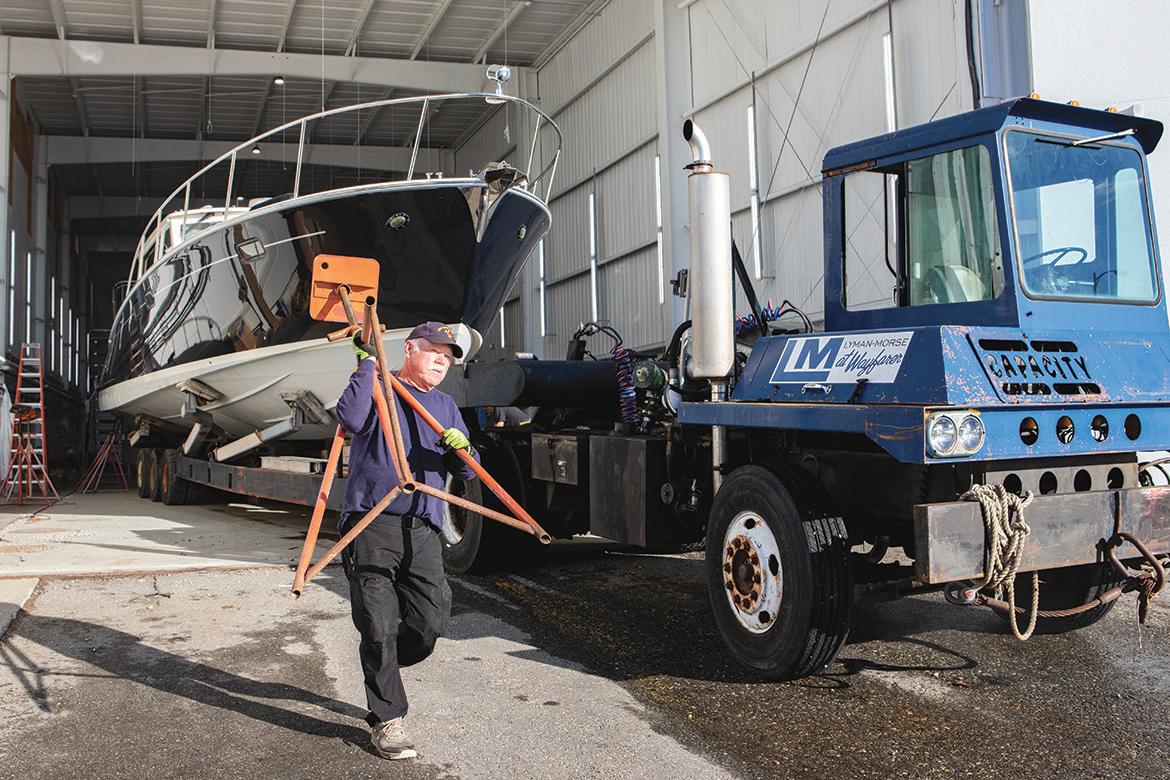
Large or small, Maine’s boat builders are a happy bunch, Phil Bennett, Hinckley’s longtime vice-president for sales and marketing and now a senior business advisor to the company, said recently.
“Stop in and ask for a cup of coffee in pretty much any boat shop and you’ll see smiling faces,” he said.
Because companies best known for their custom yachts—Hinkley, Lyman-Morse, Brooklin Boat Yard, Hodgdon, and a few others—“are not high-volume builders,” Bennett said, none of them has “a huge order book they have to build” to stay profitable. The compa nies he mentioned, and most smaller Maine boatbuilders too, build their boats, whether fiberglass lobster boats or custom wooden sailing yachts, to order rather than on spec. “Their order books are full,” Bennett said.
Wesmac Custom Boats builds large and expensive, fiberglass lobster boats, research and patrol boats
for state environmental and enforcement agencies, and “battlewagon” sportfishermen that venture far offshore hunting trophy-winning gamefish.
President Steve Wessel echoed Bennett’s take.
“Business is extremely strong, and it’s been strong for quite a while,” Wessel said recently. “We could build as many boats as we want.”
But Wesmac can’t really do that. Citing the wait time for a new boat of up to five years for potential customers, Wessel said “We’re turning a lot of work away.” The principal reason for the lengthy delay?
“We can’t get enough help.”
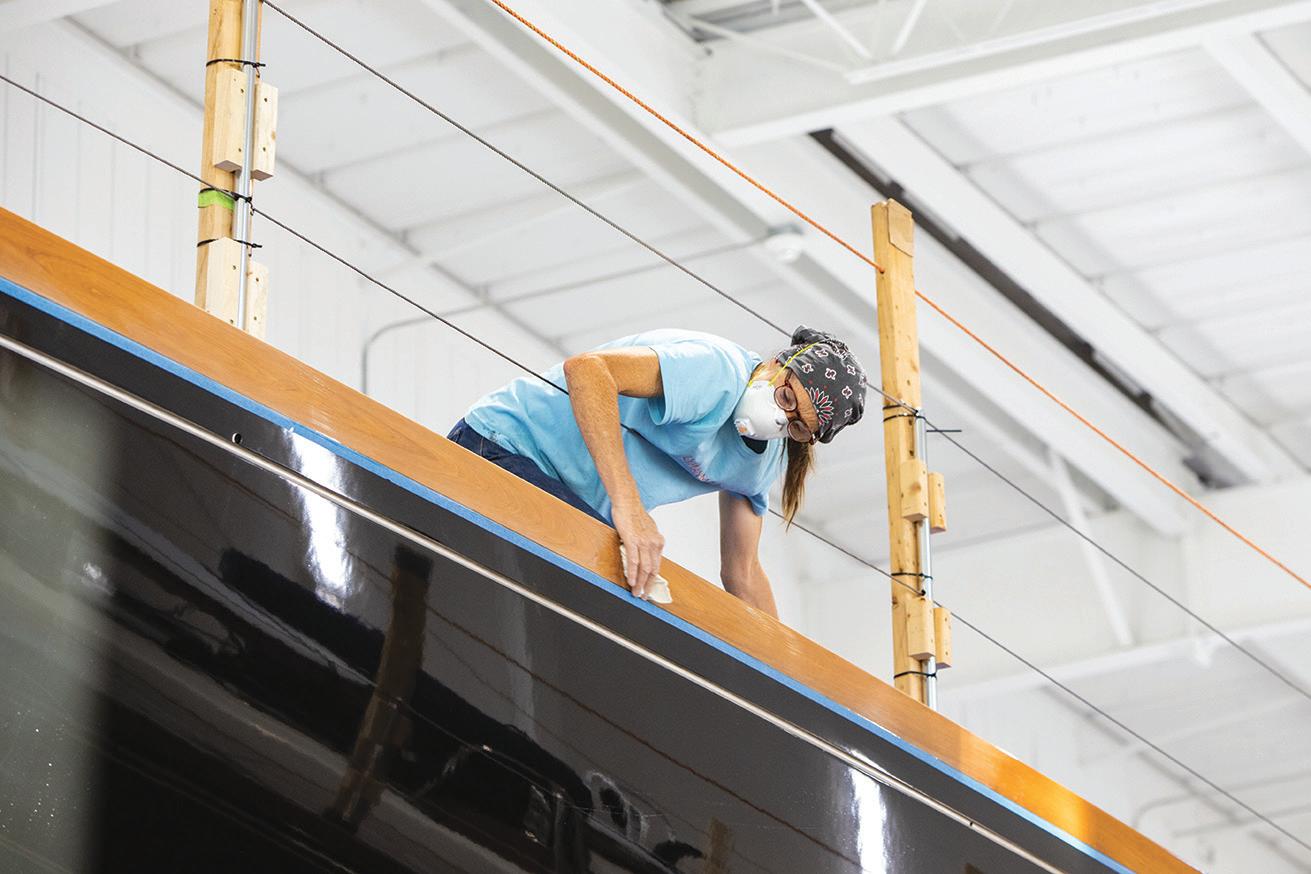
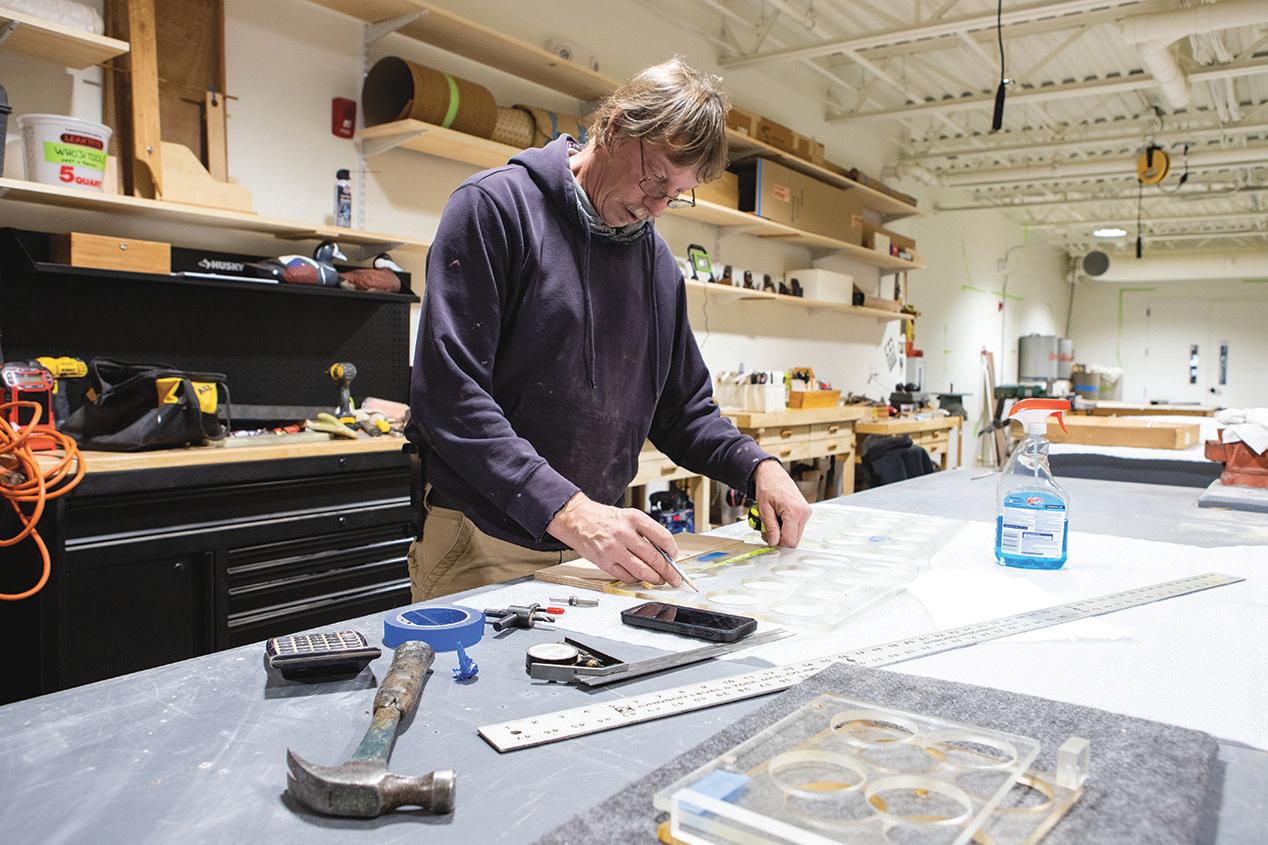
Wesmac is hardly the only Maine boatbuilder coping with a labor shortage. Hinckley, advertising jobs on Facebook recently, was offering a $2,000 sign-on bonus for experienced marine carpenters and was trying to fill several other production jobs.
Even Bath Iron Works is in a constant hunt for workers, currently advertising jobs ranging “from accounting to engineering to pipefitting to design and everything in between.”
“There’s not one boatbuilder that wouldn’t hire X number of people, if they could get them,” Bennett said.
Bennett attributed at least some of the labor shortage to the recent construction boom that sucked workers away from boatbuilding. And while he noted a recent shift by some young Mainers away from four-year colleges into technical education and traditional trades, he and Wessel both said there was some apparent reluctance among new workers to put in the long hours busy boatbuilders demand.
Assuming boatbuilders can find the help they need as construction slows, they still face plenty of issues. Wessel cited rapid and unpredictable increases in the cost of essential materials like fiberglass and resin. Bennett and other boatbuilders talked about supply chain problems that have rendered some parts and basic materials virtually unobtainable by manufac turers and suppliers Maine boatbuilders depend on.
Wesmac is hardly the only Maine boatbuilder coping with a labor shortage.Donnie Pierce of Lyman Morse stencils out custom carpentry for a customer’s yacht. PHOTO: JACK SULLIVAN A Lyman Morse employee hauls a boat stand as he prepares to remove a yacht from the facility. PHOTO: JACK SULLIVAN A Lyman Morse employee polishes a yacht’s trim while aloft in the boat yard’s largest storage shed. PHOTO: JACK SULLIVAN Darrin Low prepares a sail’s rod rigging for winter storage. PHOTO: JACK SULLIVAN
Also on the horizon, particularly for boat shops building lobster boats, is the uncertain impact of coming federal whale protection regulations on the lobster industry. That uncertainty is compounded by the extremely low boat price for lobster this summer coupled with the high costs—primarily for diesel fuel and bait—of fishing.
While the labor market always fluctuates and supply chain problems will abate eventually, Bennett said, boatbuilders, like fishermen, face diminishing access to the waterfront. As more people, many of them with substantial assets, move to Maine, boatyards and other shorefront owners are facing increased pressure to sell their property. Another concern: the cost of compliance with stricter environmental and workplace safety regulations, most acute for smaller boat shops.
Still, the outlook for Maine boatbuilders is hardly bleak. The industry has survived wars, depressions, a punitive luxury tax and is still going strong. The best evidence: several boatyards launched substan tial new projects—commercial and recreational—in recent months and have more big projects under construction or on order.
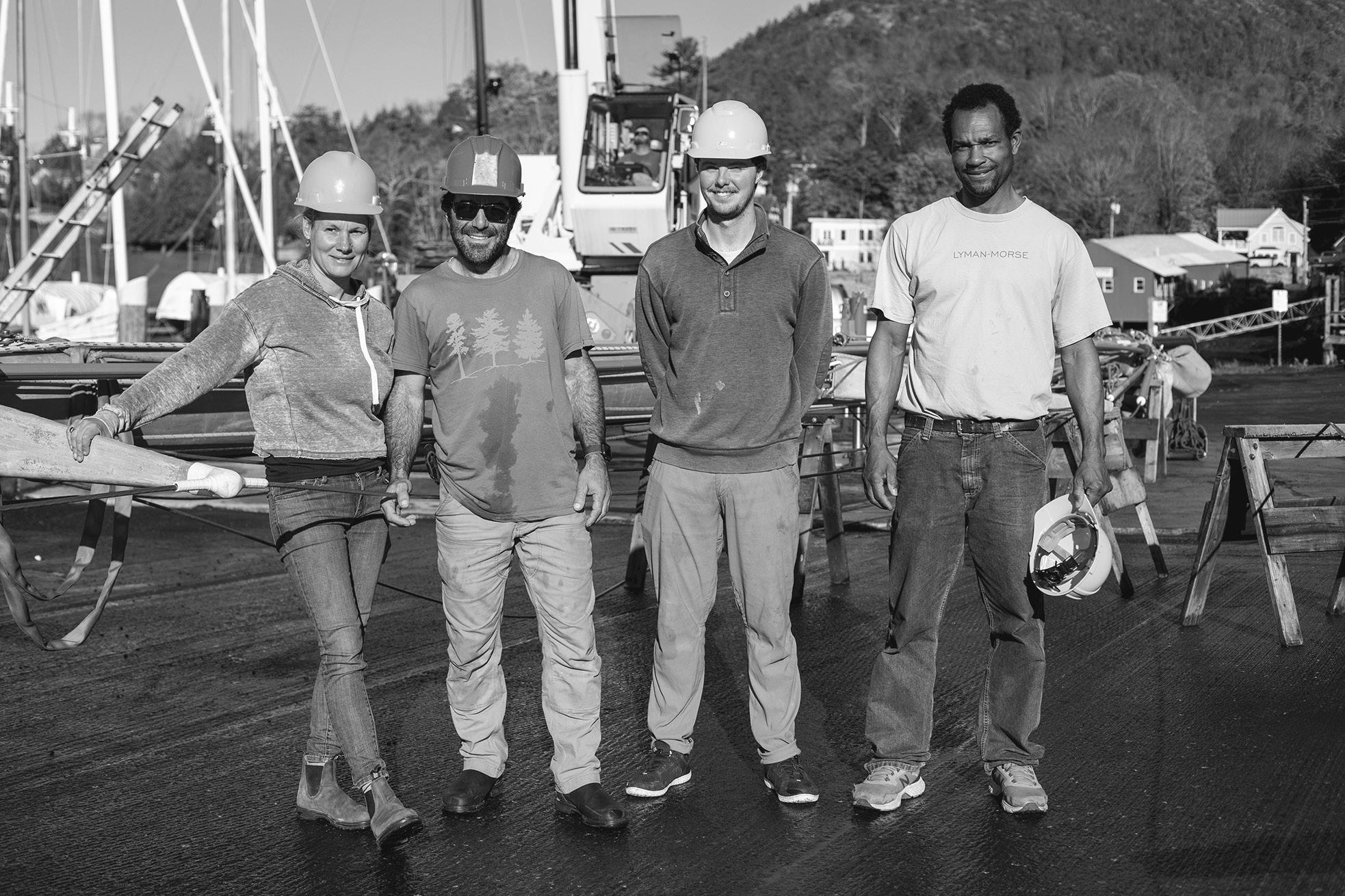
“I’m very optimistic,” Bennett said, “because we are different and people are starting to recognize that.”
Blue Hill’s wastewater blues
Nine towns depend on plant’s sea level rise fix
By Laurie SchreiberAtask force in Blue Hill is developing strategies to mitigate the impact of sea level rise on the town’s infrastructure and other resources. And it’s determined that the greatest risk is to the town’s wastewater treatment facility.
“It will be an expensive task to upgrade the current facility as well as to plan for a final disposition no later than the end of the century,” according to the task force’s 2020 report.
The task force is recommending that Blue Hill prepare for sea levels to rise 3 feet by 2050 and 8.8 feet by 2100. The situation impacts not only Blue Hill residents, but those of all nine towns on the Blue Hill peninsula.
“I would say the towns have an interest in being prepared and dealing with an issue before it becomes a real problem,” said Allen Kratz, convener of Peninsula Tomorrow, an ad hoc group that includes Blue Hill, Brooklin, Brooksville, Castine, Deer Isle, Penobscot, Sedgwick, Stonington, and Surry and tackles a variety of issues the towns have in common. Kratz credited the Island Institute as instrumental in getting the coalition started.
While the plant directly serves Blue Hill, there would be an impact to all nine towns if it were to shut down. That’s because Blue Hill is a regional service hub that includes a hospital, pharma cies, supermarkets, building supply stores, and other retailers and service providers—essentially, commu nity lifelines—used by residents of surrounding towns and would be affected by problems with the treatment plant.
it’s not just the hospital. It’s physicians and special ists. That’s why we were able to generate letters of support even though they’re not served by the plant directly.”
The plant dates back to 1975.
“After nearly a half century of wear-and-tear from the waters of the Blue Hill Harbor, Blue Hill’s waste water treatment facility is in need of upgrades and repairs to improve reliability for families and busi nesses in the area,” Rep. Jared Golden said in a press release. Golden noted the additional $1 million in federal funds would go toward repairs to the plant and upgrades that prevent further degradation from the rising water levels.
The Infrastructure Adaptation Fund grant was awarded by the Maine Department of Transportation. The $1 million was part of a total of $19.9 million awarded to 13 communities across Maine for municipal investments to protect vital infrastructure from effects of climate change such as flooding, rising sea levels, and extreme storms.
Other infrastructure likely to be impacted by sea level rise, storm surges, and flooding included the local fire department, town wharf, cemetery, town park…
Statewide, recipients will use the funds for projects to address flooding along ocean and river fronts, protect stormwater and wastewater systems, install culverts to reduce flooding, and ensure energy availability during extreme storms.
“The effects of climate change present significant challenges for our vulnerable infrastructure,” DOT Commissioner Bruce Van Note said in a press release.
According to the task force, the wastewater treat ment facility, at 48 Water St., is one of Blue Hill’s most vulnerable assets. It’s located less than one foot above the highest annual tide and has experienced trouble with outflow as pressure builds during high tides, necessitating the use of temporary measures.
“Rising sea levels and storm surge events have the potential to cause increasing harm,” the task force said.
The task force was convened in 2020 specifically to study the potential impacts of sea level rise, storm surges, and increased freshwater runoff from major rainstorm events on the town’s infrastructure, and to recommend adaptive strategies, a prioritization schedule, potential funding sources, and profes sional assistance.
In addition to the wastewater treatment plan, the task force determined that other infrastructure likely to be impacted by sea level rise, storm surges, and flooding included the local fire department, town wharf, cemetery, town park, and a variety of state and town roads.
Due to their low-lying locations, the fire station and town landing, like the treatment plant, have already experienced flooding as a result of high tides and storm surge events.
Northern Light Blue Hill Hospital and the Blue Hill Fire Department, both located near the waters of Mount Desert Narrows, cited a flood that was caused by an unusually high tide, which caused the outflow of a culvert, located behind the hospital, to back up.
Other areas, such as a cemetery and park, are on shoreline bluffs of soft gravel and dirt and are consid ered susceptible to sea level rise and storm surge.
Kratz helped coordinate support for a successful Infrastructure Adaptation Fund grant of $1 million, along with a request for an earmark for another $1 million federal grant pending before the Congressional appropriations committee.
“People come from Stonington to Blue Hill for medical care,” Kratz said by way of example. “The hospital has next to it a suite of medical offices, so
Most recently, the town was also approved for U.S. Department of Agriculture grant of $1.25 million and a loan for $2.75 million, with a 2.65 percent interest rate over 28 years, said Blue Hill Administrator Nicholas Nadeau.
The situation is growing urgent, he said.
“The sea level is rising, making it difficult for the current equipment to treat and pump out the treated material,” Nadeau said. “Additionally, the equip ment is outdated and on the smaller side for capacity compared to other municipalities with comparable size and influent.”
The task force identified potential strategies to mitigate the situation, including the placement of rip rap, a living shoreline, sea walls, breakwaters, and a lock—a dam-like structure that controls the amount of sea level allowed into a harbor.
Other coastal communities winning funding:
• Bath—$4 million
• Berwick—$1.425 million
• Boothbay Harbor—$4.15 million
• Eastport—$165,750
• Kennebunkport—$2.585 million
• Ogunquit—$2.85 million
• Rockland —$75,000
• Scarborough—$60,000
B ook R eviews
A well-deserved poetic tribute Women as lightkeepers inspired collection
Tending a lighthouse was usually a hardship posting, with deprivation of various sorts, social isolation, and serious occupational hazards. But might that life provide rewards as well as risks?
A Fixed White Light: Poems of Women Lighthouse Keepers
 By Suellen Wedmore Down East Books, 2022
Review by Tina Cohen
By Suellen Wedmore Down East Books, 2022
Review by Tina Cohen
LIGHTHOUSES are often repurposed, becoming private residences, museums, or centerpieces of a park. There may be a historical charm to them, but their role in protecting and saving lives is often forgotten.
They’re a kind of benign relic now, maybe even disconnected from their raison d’etre, that sailors’ survival at sea could be completely dependent on their light, supplied by the hard work of that beacon’s keeper. And the keepers—those jobs are mostly rele gated to history, too.
Poet Suellen Wedmore, author of A Fixed White Light and poet laureate emeritus for the town of Rockport, Mass., has researched the lives of six East Coast female lightkeepers from the 19th century. She has taken their experiences and given them words in poems, as if written by them. The poems carry individualized voices, and yet themes are shared, shaped by common circumstances—where they lived and what they did.
Wedmore tells us in her introduction, “In the last half of the 19th century, more than one hundred women worked as primary keepers of our country’s lighthouses. Twice as many were assis tant keepers and many more worked without pay or recognition in their husband’s or in their father’s names...”
She reminds us that a “woman’s place” was seen as keeper of the hearth rather than keeper of a lighthouse, with its phys ical and emotional challenges of isolation and strenuous physical work. And she asks, “Were these women exceptional in their strength and endurance, or were they average women thrust into situa tions which nurtured heroism?”
The women she pays tribute to worked in places from Matinicus to Key West. Wedmore brings these women alive with vivid descrptions of their experi ences and their emotional underpin ning. Barbara Mabrity, who in 1832 succeeded her husband as keeper after his death from yellow fever, remem bers him—as Wedmore pictures it in this excerpt from the poem, “My Husband, Now I Climb”: “some clear day, will you approach and call my name? Nights, you know me: a fixed white light, keeper of the harbor.”
Catherine Moore, who took over in her adolescence after her father was injured as the keeper in Black Rock Harbor, Conn., describes her duties in “April 1820”: “I stumble toward the tower’s spiral stairs, to kindle the wicks, a signal to those uneasy in this uncaring sea.”
Abbie Burgess was 14 when she began to help her father at the Matinicus Rock Light Station off the coast of Rockland in 1853. Wedmore writes of her reality, in “Needle and Black Thread”: “...isn’t a lighthouse’s promise of smooth sailing presumptuous, when the sea prefers havoc over calm?”
Of Kate Walker, stationed with her husband off Staten Island, Wedmore imagines her disappointment with life on a sliver of rocky ledge: “The room reeks of coal and kerosene. I won’t unpack, I
think—what I want is geraniums, holly hocks, croquet on a plush lawn.”
Ida Lewis lived at Lime Rock Light off Newport, R.I., helping her mother tend the light after her father had a stroke. Then, with her mother ill after her father’s death, she maintained it alone.
Wedmore sees her keenly aware of gender discrimination. In “After Twenty Years Working Without a Contract, Ida Considers Addressing the Superintendent of Lighthouses,” she writes, “...A man would have a stipend and a contract, I serve, and yet, please do not confuse a sense of duty with weakness.”
With Maria Bray, who tended the Cape Ann Light Station off Rockport, Mass. with her spouse, Wedmore considers the Fresnel lens, a vast improvement in intensifying and focusing the light, installed there in 1864. In “Polishing the Fresnel Lens,” she pictures a mundane job maybe slightly enhanced: “Chamois in hand, I stretch toward the lens, a shimmering glass beehive taller than a man, melange of diamonds and stars, swirl away night’s soot...”.
Despite often marking frustration, fear, disappointment, longing, and sadness, the overall effect of these poems is oddly soothing. Perhaps it is because we can also feel something else those women likely felt—a sense of accomplishment. This book is a well-deserved tribute.
Girl from the hill country makes good An
originally and what she’d done in her early years. Intimidation aside, I was immediately fond of her, as were some of my newspaper colleagues. She had a calm confidence, a warm smile, and a natural beauty.

And so I eagerly read her recent memoir, Mountain Girl: From Barefoot to Boardroom. The assumptions I’d made about her name couldn’t have been more wrong. And that’s what makes her story so entertaining.
Rockefeller’s writing style is the right match for the sweep of the decades she covers. No flowery prose, no long contemplations, just a brisk account, lingering over moments that loom large, then and later, and teasing out their meaning in honest self-examination.
Review by Tom GroeningI HAVE A habit of “interviewing” people when I first meet them. Occupational quirk, I suppose. I find myself, in situations in which I am not reporting, asking people a lot of personal questions.
I met Marilyn Moss Rockefeller in the mid-1990s when she moved her busi ness, Moss Inc., to Belfast. I was editor of the weekly Republican Journal, and I remember being a little intimidated, probably because of her last name, and also because of her business success.
So, for once, I didn’t pepper her with questions about where she was from
Rockefeller (the surname came late, by marrying into the family) began life in rural West Virginia in the 1940s, living mostly with her grandparents in a setting that sounds like she could have been neighbors with TV’s The Waltons. Lots of family time, lots of gathering around food, and lots of love. Just not from her mother and father.
Her mother was an educator, and an ambitious one whose career gradually took her away from young MarilynRae (her father insisted on adding “Rae”) for longer and longer periods, coin ciding with a northerly migration from job to job.
Her father, whom she credits with teaching her to ignore gender limita tions and with embracing a tenacity to succeed, was a drinker and a wayward husband. He died while she was a child.
One of those moments came in landing a job while in college in Michigan, working for Bill Moss. Moss was a fabric artist, designer, inventor, and a reluctant and unskilled entre preneur. He also was handsome, char ismatic, charming, and almost two decades older than Rockefeller. And a drinker and philanderer, she writes.
The 1960s in Ann Arbor is depicted as a fertile environment for creativity and experimentation—she writes about a night that the band Velvet Underground and Andy Warhol crashed in the couple’s house—but not without a dark side, as freedoms created relationship casualties.
Though Rockefeller’s life had ranged from West Virginia to Connecticut, where he mother had remarried, and then to Michigan, a twist brought her to Maine. At one point, her mother purchased a place on North Haven, and in the late 1960s, Rockefeller and Moss built an experimental house—a curvy dome, covered in a specially treated paper—on the island.
Though her husband’s innovations in the tent business matched a growing trend in hiking and camping, his busi ness sense kept Moss Tents perennially broke. The couple and the company set up shop in Rockport in 1970. It was there, after countless infidelities and selfish behavior, that Rockefeller ended her marriage to Moss.
One especially interesting section of her story is when a retired businessman offers to help Rockefeller rethink the company. Lots of tough love, delivered with a smile, changed the company from losing to making money. Good lessons here for any entrepreneurs.
And yes, she finds love with James “Pebble” Rockefeller, who is everything Moss was not—kind, attentive, loyal.
She confesses to having, for a time, to share his heart with his late fiancé, the writer Margaret Wise Brown, whose Vinalhaven cottage Pebble inherited and which served as a writing retreat for penning this memoir.
If I ever meet Rockefeller again, I think I still will have a question or two. But as with any good memoir, I now feel like we’re old friends.
Tom Groening is editor of The Working Waterfront.
unlikely life has a happy ending
B ook R eview
A mammoth in Maine
Swan’s Island’s Gary Hoyle tells story of ‘Hairy-it’
clay in a muddy pool in Scarborough. A major news story of the day, the find would not be confirmed until the early 1990s when Hoyle and a team of experts, assisted by dedicated volun teers used modern methods, including radiocarbon dating and exhumed addi tional body parts—a mandible, a molar, some bones—to verify its origins.
Thought to be a female, the mammoth became known as Hairy-it, the author’s affectionate nickname.
Cameos by the likes of historian and journalist Herb Adams, meteorologist Lou McNally, and famed Natural History Museum diorama designer Fred Scherer (1915-2013) add to the storyline. The last-named mentored Hoyle when he joined the Maine State Museum staff as a research associate in 1973.
Mystery Tusk: Searching for Elephants in the Maine Woods
 By Gart Hoyle North Country Press, 2022
Review by Carl Little
By Gart Hoyle North Country Press, 2022
Review by Carl Little
If you’re planning to start digging for Paleolithic remains in Maine, for heaven’s sake, first read Gary Hoyle’s Mystery Tusk: Searching for Elephants in the Maine Woods. With the enthusiasm and skill of a committed storyteller, Hoyle offers a step-by-step account of the “largest paleontological excavation in Maine history.”
The mammoth—its tusk—first appeared in August 1959 encased in
Hoyle takes us through the high and low points of the project, the bureau cratic hoops and funding barrels. His dedication to the project is perhaps exemplified by his volunteering for a dinosaur dig in Montana one summer in order to gain new sleuthing skills.
He also came up with an ingenious method for mapping out the excava tion site: an ice scriber, a tool once used by ice harvesters in Maine to mark off the frozen surface of ponds and lakes.
In the chapter titled “Goodbye, Hairy-it,” Hoyle imagines the course of the creature’s life. “Looking into deep time,” he writes, “is a bit like looking through a plate glass window at a shrub-studded meadow on a foggy day.” His account cuts through the fog in a loving manner.
A recent “Behind the Scenes” video from the museum relates the sad fate of some of their brilliant creations for the “Back to Nature” exhibit, which after 50 years is being dismantled due to deterioration.
About a third of the way through the book, Hoyle begins to inter weave a second story of research and revelation: the fate of “Old Bet,” said to be the first elephant to set foot in America (it arrived in New York City from India in 1796).
At the time of the initial tusk discovery, a reporter, Waldo Pray, ventured to wonder if the appendage might have belonged to Old Bet, shot to death by a crazed farmer in Alfred in 1816. In seeking to set the record straight, Hoyle branched off from Hairy-it to follow the life and times of an elephant that would eventually set P. T. Barnum on a journey that led to the greatest show on Earth.
Casco Bay data shows rapid warming
Friends group reviews 30 years of temperatures
Casco Bay is warming rapidly, according to a 30-year data set collected by Friends of Casco Bay. Temperatures in the bay have warmed 3 degrees Fahrenheit on average since 1993. At a rate of 1 degree Fahrenheit per decade, the warming trend suggests the nearshore environment in Maine’s most populated region will continue to see dramatic changes in the coming years.
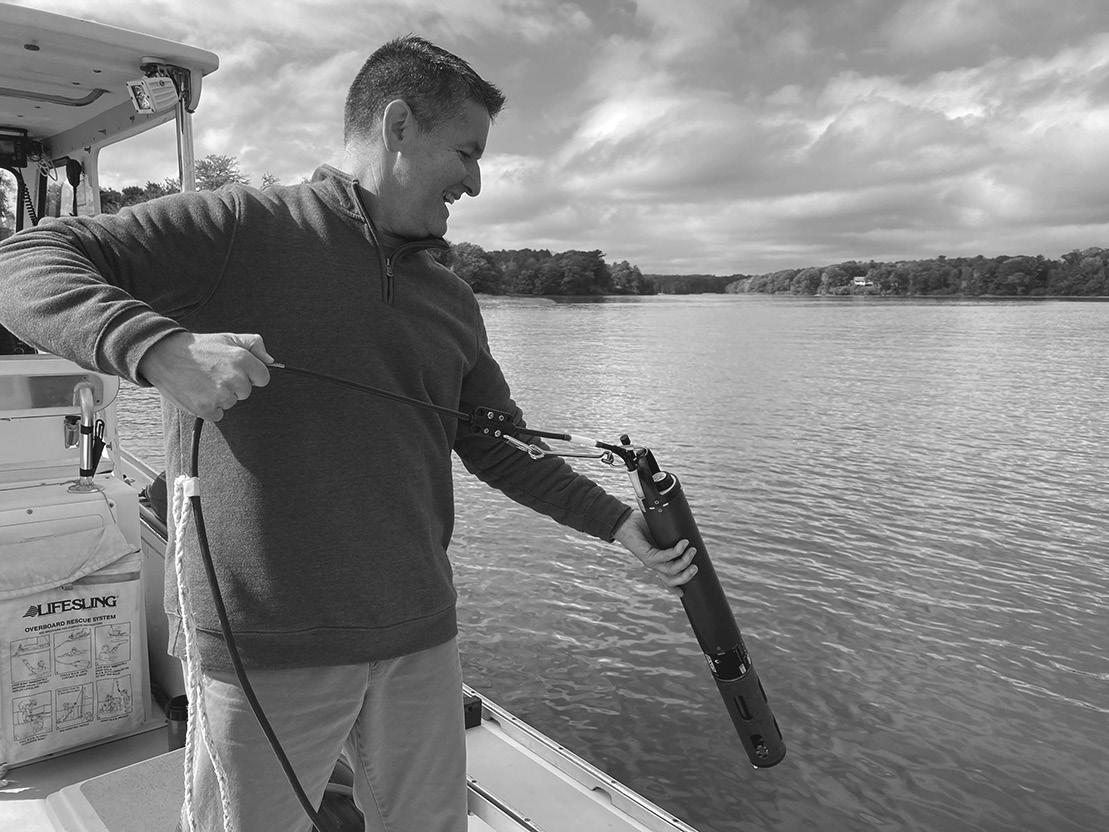
“This rise in water temperature marks an enormous shift,” reports Mike Doan, staff scientist with Friends of Casco Bay. “It’s a stark reminder that climate change is altering the bay in a fundamental way. And not only is the temper ature increasing, but the rate of increase has continued to rise, too.”
Friends of Casco Bay completed its 30th year of collecting seasonal water tempera ture data in October. The full 30-year data set shows the bay’s three warmest years on record have all occurred in the past five years, between 2018 and 2022. These data confirm that warming conditions in Casco Bay align with those observed in the Gulf of Maine and that the region’s waters are warming faster than global averages.
Scientists have linked rising marine temperatures to shifts in species distri bution. Valuable cold-water fisheries like lobster are migrating north. Green crabs, well-known for decimating soft shell clam populations and ecologi cally critical eelgrass meadows, have grown in number in Casco Bay as waters have warmed.
“Rising water temperatures cause so many impacts,” says Ivy Frignoca, Casco Baykeeper. “A significant rise in temperature can lower the amount of oxygen in the water, cause ill health for cold water plants and animals, and signal an end to a species’ ability to live here. How do we help the bay adapt to these changes?”
Slowing the rate that Casco Bay is warming will require accelerated regional and national efforts to reduce reliance on fossil fuels and turn to renewable energy. For many people living in the watershed however, changing energy policy to reduce carbon emissions can feel beyond their influence, says Will Everitt, Friends of
Casco Bay’s executive director.
“Locally, we have a limited ability to control carbon emissions across the nation or beyond our borders. But we can control the pollution we put into the Bay,” said Everitt. “Everything we do now to improve the health of marine ecosystems can help buy
Hoyle, who is a fine artist (see “’Creators in Arms’ on Swans Island,” Island Journal, 2019), provides most of the illustrations for the book, including drawings and paintings of the mammoth and Old Bet. His art reflects his dedication to natural science, but also our emotional attach ment to magnificent creatures.
Elephants are a constant source of fascination and empathy. Consider the case of Happy, the Bronx Zoo elephant whose right to selfhood was denied by the courts last June. The first-day ceremony for a new “Forever” elephant postage stamp designed by Rafael Lopez was held on Aug. 12, World Elephant Day, at the Elephant Discovery Center in Hohenwald, Tenn. The center is part of the Elephant Sanctuary, which provides refuge for elephants that have retired from zoos and circuses.
Hoyle’s stories reconfirm our deep feelings for all things pachydermic. Thanks to him, mammoth and elephant live on, in Maine and in our imagination.
Carl Little’s latest book is Mary Alice Treworgy: A Maine Painter.
us time in the face of the long-term impacts of climate change. Actions like limiting the use of pesticides and fertilizers, reducing stormwater pollu tion, and developing our towns in ways that do not harm water quality matter. Especially in highly populated areas like the shores of Casco Bay.”
The bay’s three warmest years on record have all occurred in the past five years…
Maine’s climate goals spur changes to grid
Utilities must now plan for new energy
Analysis by Stephen RappaportUntil recently, walking into a dark room and switching on a lamp rarely prompted thoughts about where the electricity energizing the light fixture came from or how it got to where it was needed. That’s changing.
Faced with threats that come with climate change, driven by green house gas emissions from fossil fuels burned to produce electricity, Maine is converting to cleaner, renewable energy sources such as wind and solar power. Part of that effort means restructuring the state’s electric power grid to accom modate those new sources.
In 2019, the legislature enacted three laws aimed at moving Maine onto a direct path to cleaner, greener energy. The legislation called for Maine to: • cut its greenhouse gas emissions by 45 percent by 2030 and 80 percent by 2050
• increase the state’s “Renewable Portfolio Standard”— which requires increased production of energy from renewable energy sources such as solar and wind—from the present 40 percent to 80 percent by 2030 and sets a goal of 100 renewable energy by 2050
• established new incentives for the installation of energy-efficient heating systems and created new incentives for solar power programs.
sources
Earlier this year, the legislature passed another comprehensive bill, LD 1959, dealing with the regulation of the state’s electric utilities. Among its complex provisions, LD 1959 requires both Central Maine Power and Versant Power to begin an “inte grated grid planning” process aimed at maxi mizing the reliability and functionality of their distribution systems at the lowest possible cost to customers as those investor-owned utilities deal with the mandated switch away from fossil fuels to clean energy over the next 28 years.
growth in the number of heat pumps installed in homes and businesses to replace gas- or oil-fueled furnaces, as well as the ever-growing number of electric vehicles in Maine.
Until now, CMP and Versant have been able to plan expansion and invest ment strategies to realize purely corporate interests without any meaningful input from customers and without taking Maine’s commit ment to clean, renewable energy into account.
The move from fossil fuels to renewables will certainly have an enormous impact on Maine’s electric utility companies.
The move from fossil fuels to renewables will certainly have an enor mous impact on Maine’s electric utility companies. They will have to reconfigure their distribution systems to receive power from new and less centralized generating facilities— called “distributed energy resources,” or DERs—including individual rooftop solar installations and multi-acre commercial solar farms, as well as land-based and eventually, offshore wind farms.
And the state’s “Maine Won’t Wait” climate action plan calls for an expo nential increase in the demand for electricity to power the anticipated
The only significant control on those activi ties comes through the rate-setting authority of the Maine Public Utilities Commission.
The new integrated grid plan ning process requires the utilities to consider the state’s commitment to reducing greenhouse gas emissions as they plan revisions to the electrical grid and to ensure that those revisions are consistent with Maine’s clean energy goals. Ideally, the process, which calls for substantial input from the public— technical and environment experts as well as customers—will make the utilities more accountable and save customers money through better use of the companies’ resources.
Southern Maine gets its own dredge
Gear will be used Kittery to Scarborough
By Clarke CanfieldCoastal communities in Southern Maine stand to benefit from a new dredge that will be used to improve navigational channels and replenish beaches from Kittery to Scarborough and possibly beyond.
The York County Commission has given the green light to purchase an 86-foot suction dredge using $1.54 million in federal funding made available through the American Rescue Plan Act. If all goes according to plan, the dredge should arrive in spring and be in operation for the 2024-25 dredging season, if not sooner.
The dredge would be managed through a newly created nonprofit organization called the Southern Maine Dredge Authority and would be rented on a “pay-as-you-go” system as dredging projects arise. In time, the goal is to have the dredge be self-sustaining from revenues generated from dredging projects for municipalities and possibly boatyards and other privately owned properties, said Al Sicard, chairman of the York County Commission.
“This is a once-in-a-lifetime opportunity,” Sicard said. “This is huge for communities up and down the coast.”
Ten federal navigational channels in the region have been dredged a total of 120 times between 1949 and 2018, generating nearly 3.5 million cubic yards of material, according to a 2018 study by the Southern Maine Planning and Development Commission that examined the feasibility of purchasing and operating hydraulic dredge equipment in southern Maine. Those navigational channels include places
such as York Harbor, Wells Harbor, the Josias River in Ogunquit, the Kennebunk River, and Pine Point Harbor in Scarborough.
But the driving force behind the initiative to buy a regional dredge was Save our Shores Saco Bay, an organization that has advocated for the need for ongoing beach replenishment at Camp Ellis, a small shoreside community in Saco whose beach has been decimated by shoreline erosion for more than a century.
A dredge is a critical tool for moving sand on a regular basis to reinforce the shoreline at Camp Ellis and other communities, much like places do in Cape Cod and Florida, said Kevin Roche, president of Save our Shores Saco Bay. Furthermore, he said, it’s also important to move beyond simply studying and discussing the impacts of climate change and take action in response to rising ocean waters.
“This is an important symbol that government is actually making an investment in infrastructure. I think it’s important that the county made the deci sion to get something physically here to help with that,” he said.
York County commissioners approved the purchase in October by a 3-2 vote. The dredge will be manufac tured by Ellicott Dredges LLC, of Baltimore, Md., and be equipped with a rotating cutter head that loosens and lifts sand and other materials from shallow chan nels to increase navigational depths and transfer the material to restore nearby shorelines.
The Southern Maine Dredge Authority will need to appoint an executive director, figure out who will serve as captain and crew of the dredge, and line up
The Natural Resource Council of Maine praises the laws requiring grid planning because it, for the first time, “holds utilities accountable for their responsibility to help Maine transi tion to a clean, affordable, and reli able electric grid quickly and cost effectively.”
Specifically, LD 1959 requires the utilities to develop plans every five years that incorporate a range of options for investments in expansion and reconfiguration of the grid. The process will, in theory, be transparent and, ultimately, will form the basis for the PUC’s work in rate cases and other regulatory matters.
Exactly how that process will work or how and to what extent the public will be able to participate are yet to be determined, but the PUC is charged with developing new rules and procedures.
Speaking at a recent seminar explaining some of the coming changes to Maine’s energy system, Jack Shapiro, NRCM’s climate and clean energy director, said the transition “requires a once in a century reimagining of the electric grid.”
The hope, and the governor’s and legislature’s expectation, is that the new integrated grid planning process will provide the framework for that reimagining.
Novel thought: time will tell.
orders for dredging jobs. Realistically, the dredge probably won’t be operating for another two years, beginning with the dredge season that runs from November 2024 through April 2025, Roche said.
State Sen. Donna Bailey of Saco has submitted legis lation to create the Southern Maine Coastal Waters Commission to oversee the Southern Maine Dredge Authority. Membership on the commission would be open to representatives from each coastal commu nity from Kittery to South Portland, and would also include representatives from the state departments of Environmental Protection, Transportation, and Agriculture, Conservation and Forestry, and the Maine Geological Survey.
With rising ocean waters and climate change, coastal communities should have more control over their shorelines and not be at the mercy of the Army Corps of Engineers for dredging, Bailey said.
“Camp Ellis is a canary in the coal mine as to what can happen on the Maine coast,” Bailey said. “Although the Army Corps of Engineers periodically dredges the Saco River and dumps the sand on Camp Ellis Beach, local communities currently do not have control over the schedule or timing of the dredging. What happens when the Corps of Engineers isn’t available? What happens when there is a severe storm and a strong current that impacts not just Camp Ellis Beach, but any of the beaches along the coast of Southern Maine?
“Climate change has been increasing the severity of the storms which increases erosion and threatens the beaches. That’s why we need to have a dredge that we can call upon when it’s necessary.”
The Deer Isle causeway’s curvy history


Water flow should be part
By William A. HavilandTHE EXCELLENT ARTICLE on the vulnerability of the Deer Isle causeway (The Working Waterfront, November issue) prompts me to add some history, as well as some things to consider when planning future modifications.
Before the causeway was built, passage between Deer Isle and Little Deer, unless by boat, was at low tide across what was known as Scott’s Bar. This was not a true sand bar, but rather a sinewy line of hard clay that was slightly higher than the surrounding clam flats. Its snakelike pattern, retained by the present causeway, was the product of winds, waves, and currents.
As early as 1873, and again in 1875 and 1880, the town appropri ated the sums of $50 to fill a low spot in the bar near Little Deer. Not until the 1920s, however, was serious thought given to construc tion of a causeway. The thinking was that if ever a bridge was to connect Deer Isle to the mainland, it would have to be from Little Deer across the narrowest part of Eggemoggin Reach. But without an all-tide connection to Deer Isle across Scot’s Bar, raising money for a bridge would be difficult.

George E. Snowman of Little Deer, who was in the legislature, was able to get $15,000 from the state to begin construction of the causeway in 1927. Over the next ten years, further appropriations enabled work to continue. At first, stones were placed along the edges of the hard clay bar. As the years wore on, its height was built up until, in 1938, one could cross it at any tide. Because it followed the natural course of the hard clay, rather than crossing soft mud, it was based on a firm foundation
The causeway remained a town road until 1946, when the state was persuaded to take over full responsibility for its upkeep. At that time, the Little Deer approach was straightened and Pine Hill (on Little Deer) was quarried for stone to widen and raise the road’s height. This was perfectly adequate until the current era of over powered, bloated cars, SUVs, and monster trucks (not to mention increased traffic).
Up until the 1930s, the gap between Deer Isle and Little Deer was an important fish passage, which attracted the interest of Wabanaki Indians. Here, they built fish weirs, speared flounders, and dug clams. Interestingly, when the first colonial settlers arrived (in 1762), they did the same thing: built fish weirs, dug clams, and speared flounders. The importance of the place for the Wabanakis was reflected in two names for it: “Where the Fish Weirs Are” (the word Eggemoggin is a corruption of the Indian word) and “At the Great Fish Weir.” Also indicative is a concentration of ten known Wabanaki campsites nearby, some including
material as many as 3,000 years old to as recent as the early years of colonial activity.
A final reflection of the importance of this place is that it was chosen in 1626 for a meeting between Penobscots and colonists in an attempt to end one of several conflicts as Wabanakis defended their homeland from European incur sions. In exchange for the Penobscots laying down their arms, the colonists sent a sloop filled with trade goods as well as Indian captives for repatriation.
The gap where the causeway runs today was also an important trans portation route. An Indian canoe route ran through here, from the small cove in Brooksville known as the Punch Bowl, across the Reach and along the Deer Isle shore to a portage to Long Cove. From the Punch Bowl, a portage led to Walker’s Pond and the Bagaduce River and ultimately the Penobscot River. This canoe route remained in use from 3,000 years ago well into the 20th century. Once white settlers arrived, they also used this gap on the high water as a shortcut from the western bay to the Reach. One craft attempting this passage, in April 1859, was a whaleboat rigged as a sloop called bowcat (bow rhymes with oh). Enroute from Northwest Harbor to the Benjamin River loaded with hoop poles, it was crossing Scott’s Bar when the wind shifted, driving it on to the Little Deer Isle shore. From this inci dent, came the transfer of the vessel’s name to the body of water between Little Deer, the Causeway, Carney Island, and the facing shore of Deer Isle.
Given the historical and ecological importance of the causeway’s location, any alteration of this structure should restore the free flow of water between the Reach and Western Bay. When the causeway was completed, it blocked not only passage of watercraft, but of fish as well. Within a few years, the flounders were gone, and the last fish weir was built in 1950.
At the Sept. 20 meeting on the causeway, reported on by The Working Waterfront, Marsden Brewer of Stonington spoke of the potential benefit of restoring the flow of water for the scallop fishery. We know scallops were present on the bay side in the past, as there was a midden of scallop shells (now eroded away) on Carney Island.
And I recall in the 1950s someone hooking up significant numbers of scallops on the Reach side.


Clearly, something has to be done about the causeway in the face of climate change. We should take the opportunity to do it right!


William A. Haviland is a retired anthropologist and past president of the Deer Isle-Stonington Historical Society. He lives on Deer Isle not far from the causeway.
Advertise in The Working Waterfront, which circulates 45,000 copies from Kittery to Eastport ten times a year.
Contact Dave Jackson: djackson@islandinstitute.org
Up until the 1930s, the gap between Deer Isle and Little Deer was an important fish passage…
of any repair
Be sure to feed the watchdogs
A robust press is a pillar of democracy
By Tom GroeningTHE IRONY wasn’t lost on the audience. Especially this audience.
I attended the Maine Press Association’s fall conference in Bar Harbor in late October—for the first time in over 20 years—and came away charged up and proud.
One of the presentations was by Steve Waldman, co-founder of Report For America, a nonprofit that places and helps pay for reporters across the country. Its mission is “to strengthen our communities and our democ racy through local journalism that is truthful, fearless, fair, and smart.”
At one point, Waldman was sharing his ongoing quest for donations and grants, and said one funding source told him, “We’re not going to fund reporters this year. We’re going to focus on democracy.”
With a slight raise of an eyebrow, the irony of that response was clear— because journalism is an essential part of keeping democracy functioning.
Nonprofit journalism—like that of The Working Waterfront—has been an anomaly for most of the last hundred years. But government has taken action to support newspapers, understanding its role.
Waldman said until the 1850s, news papers received a postal subsidy to allow them to mail their product. Later, political parties paid to distribute them, and then the “penny press” emerged, an affordable way for the masses to get news, with most papers at that time costing 6 cents.
Finally, advertising and reader purchases created the model we know today.
In the late 1990s, the rise of the internet changed everything, and newspapers failed to put a price on the content they shared online. And adver tising for real estate and cars, the staple of many papers, migrated online.
“I think it can go in a horrible direc tion,” Waldman said of the web, “or it can go in direction that’s better than ever.” One example of the horrible is the proliferation of what are known as “pink slime” websites which masquerade as new outlets by offering up the many press releases and calendar items that are readily available, while also including favorable content about a particular candidate or elected offi cial. Waldman asked if there were any operating in Maine, and journalists said there were at least two. Across the country, there are about 1,500, he said.
One of the most compelling arguments Waldman made for the importance of local journalism was that in small cities where papers had disappeared, bond ratings were lowered on those municipalities. In other words, without watchdogs, even bankers see how corruption can creep into government.
Since 2004, some 50,000 reporter positions have disappeared, Waldman said, which is why Report For America exists, though he admitted the 540 reporters it’s funded in the last five years are a drop in the bucket.
In the absence of local news, people turn to national TV news and social media, often skewed toward one polit ical view. From good information, to no information, to bad information is the sad progression, he said.
The Philadelphia Inquirer is now a nonprofit, Waldman said. Here in Maine, we have the Maine Monitor, a nonprofit news site.
In the evening, the press associa tion gave out awards and honored a few long-time journalists by inducting them into its hall of fame. Each had a moving story of dedication to what is a public service, just like being a teacher, nurse, and police officer.
The association’s incoming president, Courtney Spencer, an advertising vicepresident for the Portland Press Herald, succinctly captured our mission in her brief remarks:
“We are here tonight because we believe in the power of words. To inform. To illuminate. To provoke curiosity.
“We believe in the power of a photo graph. To tap emotion. To show the world as it is. To stimulate a memory.
“We believe in the power of an edit. To clarify. To deepen understanding. To expand perspective.”
This, the December-January issue, is our last of the calendar year. Please consider supporting the kind of community journalism we do by becoming a member of the Island Institute—which gets you a subscrip tion to The Working Waterfront. See: IslandInstitute.org/support.
Tom Groening is editor of The Working Waterfront. He may be reached at tgroening@islandinstitute.org.

R efle C tions
Transitions and transformation on MDI
Reflections is written by Island Fellows, recent college grads who do community service work on Maine islands and in coastal communities through the Island Institute, publisher of The Working Waterfront.
By Brianna Cunliffe
THE TIDE laps at the narrow road that joins Mount Desert Island to the mainland. Traffic jostles in the mist. All my life, I have lived in places heartbreakingly vulnerable to climate change.My new home in Tremont, on the island’s “quiet side,” is no different. Like my hometown of Wilmington, N.C., MDI’s coast is its lifeblood—a coast already battered by rising seas, worsening storms, and crumbling infrastructure. But as an Island Fellow working with A Climate to Thrive, I see this community rising to the call for transformation.
A Climate to Thrive (ACTT) came to be because neighbors at a potluck started talking about climate change. That gath ering gave rise to a nonprofit that has increased the island’s solar by seven times, pursuing energy independence for MDI
by 2030. But community-driven climate action is about more than just watts on the grid: ACTT also knows that how we transition off fossil fuels matters—tran sition can be an opportunity to build empowered, equitable, collaborative, and resilient communities. When neighbors talk to neighbors, focused on solutions, we build momentum by connecting based on what we value.
That idea is the heart of our Climate Ambassadors program, where on Wednesday evenings in the library, retirees, teenagers, business owners, church leaders, and others gather around a table, exploring their contri butions to climate action. We talk about the powerful spark of impact at the intersection of the climate’s needs, your skills, and your sources of joy. Climate Ambassadors shake off despair by cultivating and empowering that spark. The MDI pilot launched this fall, and starting Jan. 12th, we’ll take what we’ve learned statewide in a six-session training that’s free, virtual, and open to the public. Join us: www. aclimatetothrive.org/ambassadors.
This is our model: start at home,
then share as widely as possible. Our Local Leads the Way series exemplifies this. Launched in November 2021, the initiative brings together communitydriven climate action groups (and those interested in starting a group) from throughout Maine to build networks of collaboration and support, share resources, engage in trainings, and reduce duplication of effort.
Local Leads the Way meets virtually the first Monday of each month at 4 p.m.; anyone is welcome to join: www. aclimatetothrive.org/localleadstheway. Across Maine, we’re all grappling with different landfalls of the same big storm and we need all the help we can get.
The stakes are unspeakably high. But that’s never an excuse for steamrolling over our neighbors, or leaving the most vulnerable among us behind. It’s also never a reason to give in to despair.
It can be so tempting to try to reach people by talking about what will happen if we fail—the real but para lyzing realities of neighbors cut off from emergency services, lost jobs, a landscape of ecological loss. But that is not and cannot be the full story.
What does our island look like in 50 years, in a world where our choices have cut carbon emissions, re-centered equity, conservation, local food, and energy production? What precious things will we have saved, and what will we have created in the process? Thanks to my new neighbors, I live in hope of that possible future. I’m honored to work towards it every day.
Brianna Cunliffe works with ACTT on Mount Desert Island focusing on education and community-based climate action. She has worked with the National Parks Service, Appalachian Trail Conservancy, and Dogwood Alliance, and recently graduated from Bowdoin College with a degree in environmental studies and government.

STURGEON TALL—
This image from the collection of the Tides Institute & Arts Museum in Eastport shows a group of boys surrounding and holding up a sturgeon on the deck of a schooner docked at a wharf at Lubec. The photo dates to about 1910.
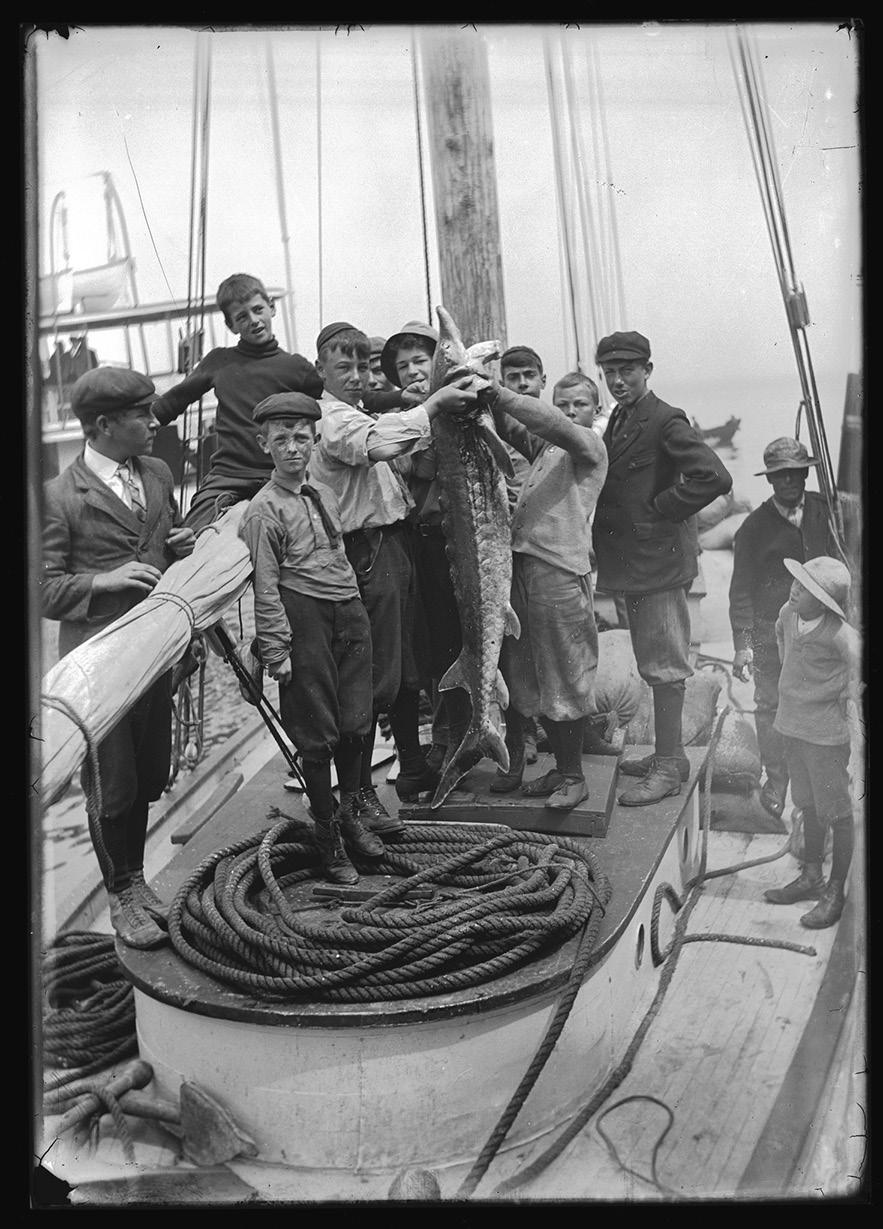
MDI housing crisis affects much more Community nonprofit focuses on Northeast Harbor
By Kathy MillerTHE TOWN of Mount Desert asserts in clear terms an underlying problem that radiates out into so many other issues.
“The high cost for housing is currently one of the primary driving forces behind many of the issues facing the town of Mount Desert,” the town’s comprehensive plan argues.
“An appropriate balance of housing should be sought after to support a healthy economy, and it should be kept affordable in order to avoid displacing community members to outlying areas,” the plan continues.
“Housing should be developed in a way that improves connections between and among community members to create vibrant year-round villages. It should not degrade or exhaust the natural resources that are integral to the success of this community, such as fragmenting or destroying important wildlife habitat, polluting or exhausting water supplies, or negatively impacting either natural or built scenic resources.”
These assertions are consistent with Mount Desert 365’s mission and purpose—to foster a sustainable
Island Institute Board of Trustees
Kr istin Howard, Chair
Douglas Henderson, Vice Chair
Charles Owen Verrill, Jr. Secretary
Kate Vogt, Treasurer, Finance Chair
Carol White, Programs Chair
Megan McGi nnis Dayton, Philanthropy & Communications Chair
Shey Conover, Governance Chair
Michael P. Boyd, Clerk
Sebastian Belle
David Cousens
Michael Felton
Nathan Johnson
Emily Lane
Bryan Lewis Michael Sant
Barbara Kinney Sweet
Donna Wiegle
John Bird (honorary)
year-round community while preserving its natural environment. Our approach to achieving our mission runs along parallel tracks: supporting local businesses and creating afford able year-round housing opportunities to restore the year-round population.
The lack of housing affordable to the year-round residents who are essential to keeping our communities intact— municipal and public safety workers, medical staff, teachers, bank tellers, restaurant staff, tradespeople, and so many more—is an emerging crisis.
There are three compelling reasons we are focusing our efforts on creating housing in the village of Northeast Harbor, part of the town of Mount Desert:
• proximity to local businesses
• access to utilities
• preservation of natural areas and undeveloped land
Northeast Harbor is the commercial and municipal center of the town with the greatest concentration of storefront businesses. Having more people living here will support existing businesses in the quiet season and may make the difference in keeping them open. It may also make the difference in attracting
othe businesses many people have told us they want.
Access to utilities is the second reason. It will save money in devel oping the properties where water, sewer, and power are already in place, and most importantly eliminate the environmental disruption of digging wells and installing septic systems.
These housing issues have been a concern for decades, and Island Housing Trust continues to make real headway. But the need is still great, and the pandemic and the high financial returns of short-term rentals have only exacerbated the problem.
We know that businesses and orga nizations are experiencing hiring issues due to the year-round housing shortage. While we may not have homeless people sleeping on the streets, we do know of individuals and families pushed out of their rentals in the spring, living in their cars to finish the school year or until their rental becomes available in mid-fall.
We also know that MDI is not the only place experiencing these dire housing issues. A recent New York Times story, headlined “Whatever
THE WORKING WATERFRONT
Published by the Island Institute, a non-profit organization that works to sustain Maine's island and coastal communities, and exchanges ideas and experiences to further the sustainability of communities here and elsewhere.
All members of the Island Institute and residents of Maine island communities receive monthly mail delivery of The Working Waterfront.
For home delivery: Join the Island Institute by calling our office at (207) 594-9209
E-mail us: membership@islandinstitute.org • Visit us online: giving.islandinstitute.org
386 Main Street / P.O. Box 648 • Rockland, ME 04841
The Working Waterfront is printed on recycled paper by Masthead Media. Customer Service: (207) 594-9209
Happened to the Starter Home?,” iden tified communities across the country with similar issues. It included this: “The starter home has always done a lot of work. It builds equity, creates stability, gives shelter from landlords and inflation. It has been an incubator of small businesses and community institutions like day care centers.”
What we are working to create may be starter homes or forever homes, but the outcomes of equity, stability, shelter, and incubation still apply.
Market forces will not fix our housing problem, which is reaching a crisis level. It needs an intervention and a commit ment to move forward with plans that will relieve the stress for the long haul while maintaining the character of the town we all love.
Kathy Miller is executive director of Mount Desert 365, a nonprofit, community-based organization dedicated to promoting long-term economic vitality of the town of Mount Desert, through expansion of year-round residential communities and economic revitalization of commercial districts.
Editor: Tom Groening tgroening@islandinstitute.org
Our advertisers reach 50,000+ readers who care about the coast of Maine.
Free distribution from Kittery to Lubec and mailed directly to islanders and members of the Island Institute, and distributed monthly to Portland Press Herald and Bangor Daily News subscribers.
To Advertise Contact: Dave Jackson djackson@islandinstitute.org 542-5801
www.WorkingWaterfront.com
JUST DUCKY—


Those people driving over Belfast’s Route 1 bridge or walking along the harbor on Saturday, Oct. 22 saw the Duck of Joy emerge from the fog. The duck had appeared on the waterfront last summer, then seemed to migrate south to Islesboro. Several days later, winds kicked up and the duck was again bound for Islesboro, with Belfast’s harbormaster boat in pursuit. The duck’s ownership remains in the fog.
A close working relationship with your insurance agent is worth a lot, too.
We’re talking about the long-term value that comes from a personalized approach to insurance coverage offering strategic risk reduction and potential premium savings.
Generations of Maine families have looked to Allen Insurance and Financial for a personal approach that brings peace of mind and the very best fit for their unique needs.
We do our best to take care of everything, including staying in touch and being there for you, no matter what. That’s the Allen Advantage.
Call today.
(800) 439-4311 | AllenIF.com

This holiday season, give the gift of comfort and hope with a donation to the American Red Cross. You can give a meaningful gift that helps people through some of life’s toughest moments.

Donate today at redcross.org
We are an independent, employee-owned
company with offices in Rockland, Camden, Belfast, Southwest Harbor and Waterville.
Owning a home or business on the coast of Maine has many rewards.PHOTOS: JOSH POVEC
UMaine study finds ‘tick clusters’ in Acadia Deciduous,
Acadia National Park is one of the most beautiful and popular places to visit in Maine, for tourists and residents alike. With so many visitors, Acadia is a hotspot for exposure to tick borne diseases, which are on the rise in the state. A new study from the University of Maine has found clusters of tick populations in the park, which could help inform prevention strategies for tick-borne illnesses like Lyme disease.
Former UMaine master’s student Sara McBride, now a medical entomologist for the Indiana Department of Health, and Allison Gardner, associate professor of arthropod vector biology at the University of Maine School of Biology and Ecology, led a team of researchers from UMaine, Cornell University, and the National Park Service in overlaying tick surveys with ecological habitat feature data to model the risk of exposure to tick-borne disease in Acadia.
The researchers collected black legged ticks at 114 sites across the park over two years and mapped that data

out on the park’s landscape features. The results showed that tick density varies significantly across the park, but is particularly high in areas with deciduous forest cover and relatively low elevation, especially the northeast area of Mount Desert Island.
“Understanding the spatial distribu tion of tick exposure risk in the park may ultimately inform practical environ mental and public health management strate gies,” says Gardner. “For example, the National Park Service could post informational signage in areas that have high tick densities, or build boardwalks in known tick habitat.”
The researchers then chose 19 of the sites and looked more deeply at the microclimate conditions, vegetation, and activity of tick host species like mice and deer to further explore the fine-scale patterns of tick distribution. They found significant differences in microclimate conditions and vegetation across the sites, but not in host activity. Mean temperature
SWANS ISLAND PRIME WATERFRONT
and mean humidity at the sites corre lated with tick nymph populations and may provide a link between landscape features and blacklegged tick densities.
“Sara [McBride]’s study is novel in her attempts to link broad associations between tick densities and landscape features with the fine-scale microhabitat conditions that are directly experienced by ticks and may influence their survival and host-seeking behavior,” says Gardner.
The researchers also tested ticks and
small mammals in the area for multiple tick-borne pathogens and found a variety of them, including the patho gens that cause Lyme disease, babesiosis and anaplasmosis. Therefore, the results could help inform the exposure risk for different areas of Acadia National Park.

The study was supported by Schoodic Institute at Acadia National Park through a Second Century Stewardship Fellowship. The study was published Oct. 22 in the Journal of Medical Entomology.

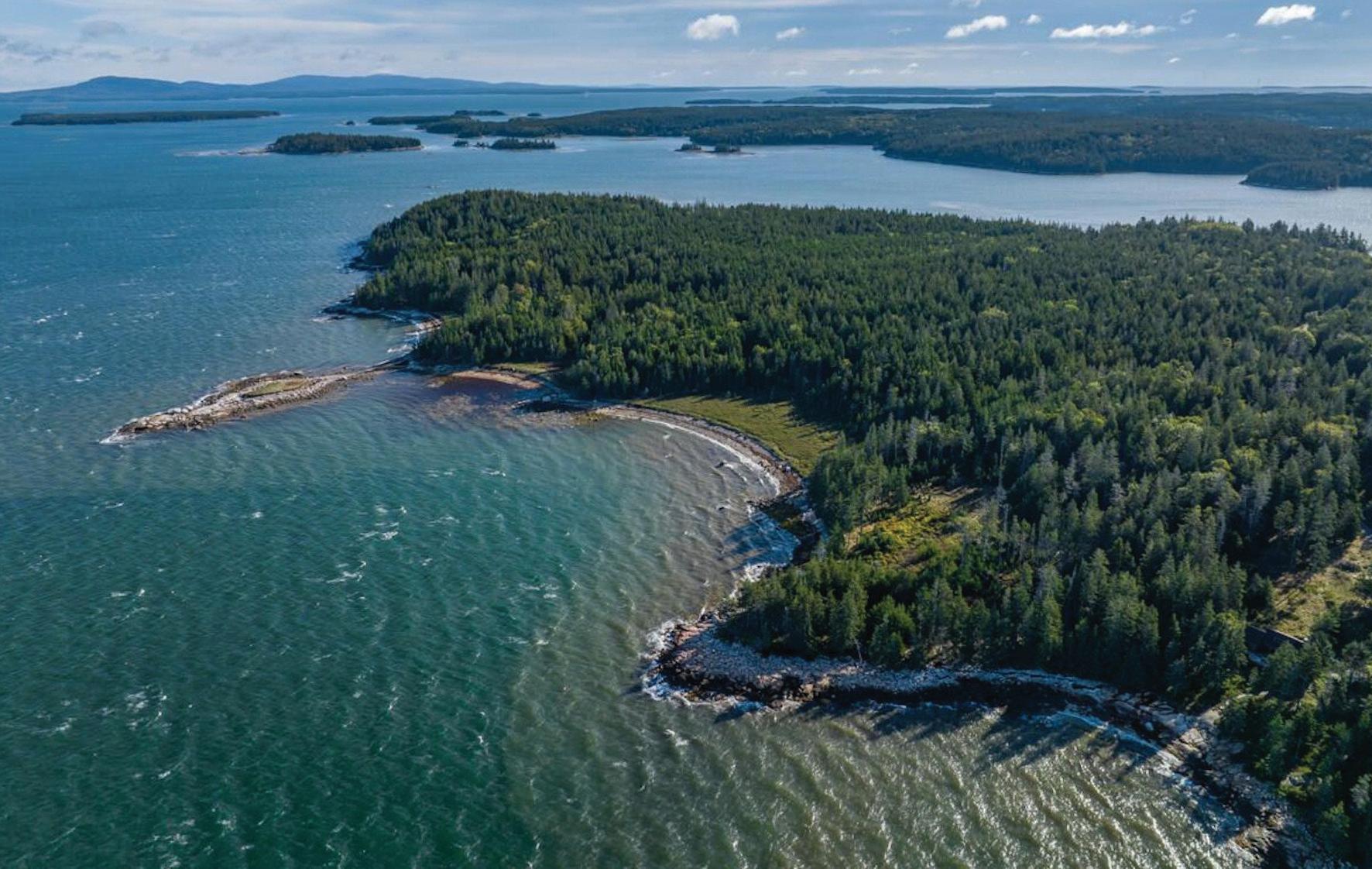
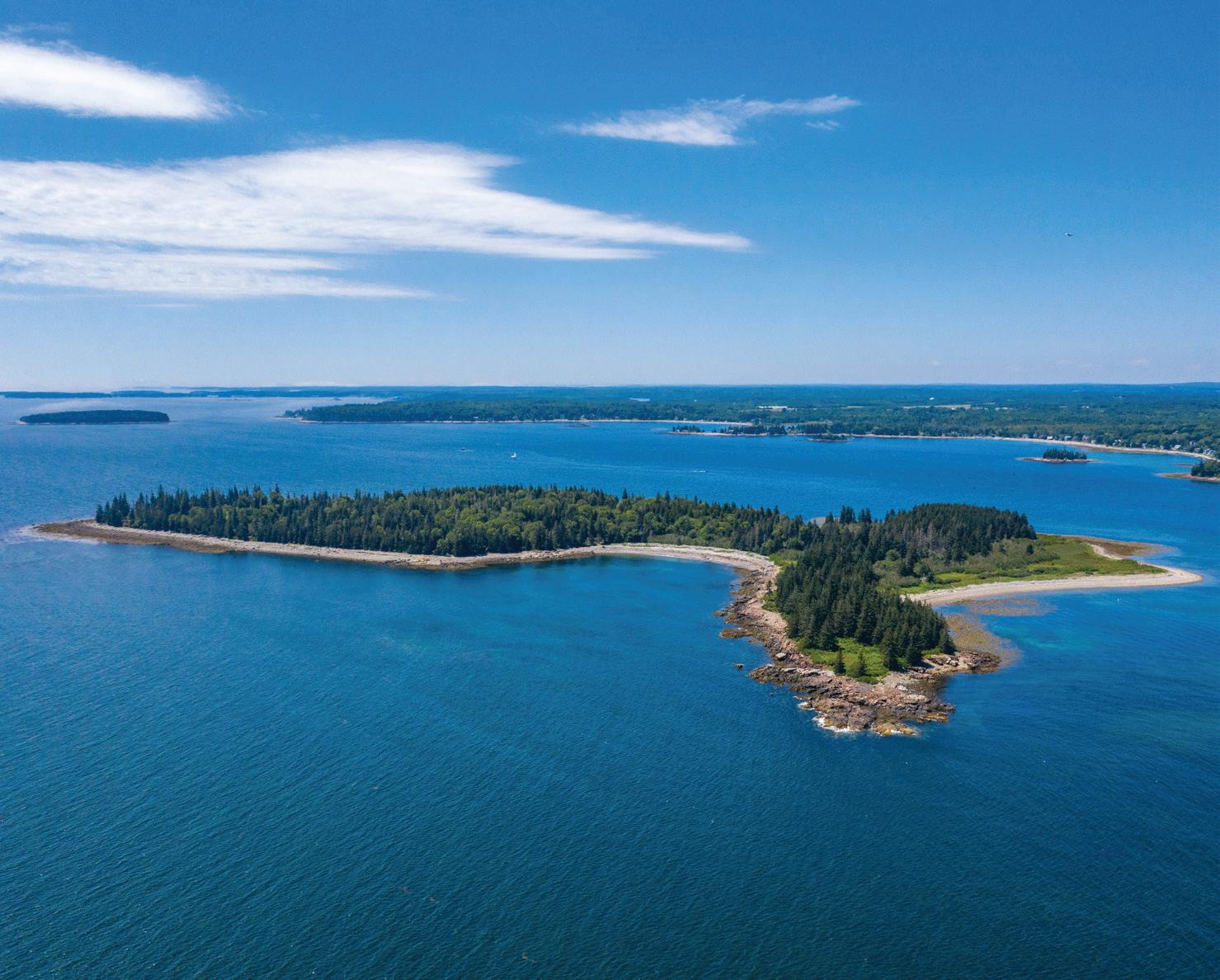
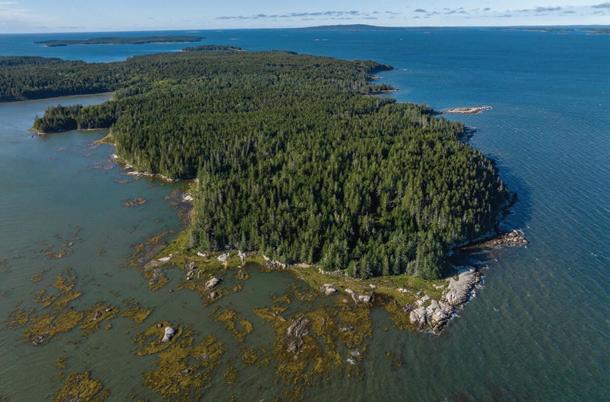
Panoramic ocean views at the Northwestern tip of Swans Island. Fabulous offering is one of the most unique & spectacular of its kind in the state. Incredible 151 +/- acre parcel with nearly two miles of ocean frontage. Covenants in place for a dock in Seal Cove. Seller has already acquired engineered plans and the dock itself. Privacy. Seclusion. Magnificent Views!
Offered at $1,200,000
The
Davis Agency Real Estate & Vacation Rentals 363 Main Street, SW Harbor 207-244-3891 www.DavisAgencyRealty.com Email: davco@daagy.com
The researchers collected blacklegged ticks at 114 sites across the park over two years…
low vegetation favored by arthropods
A rugged island outpost
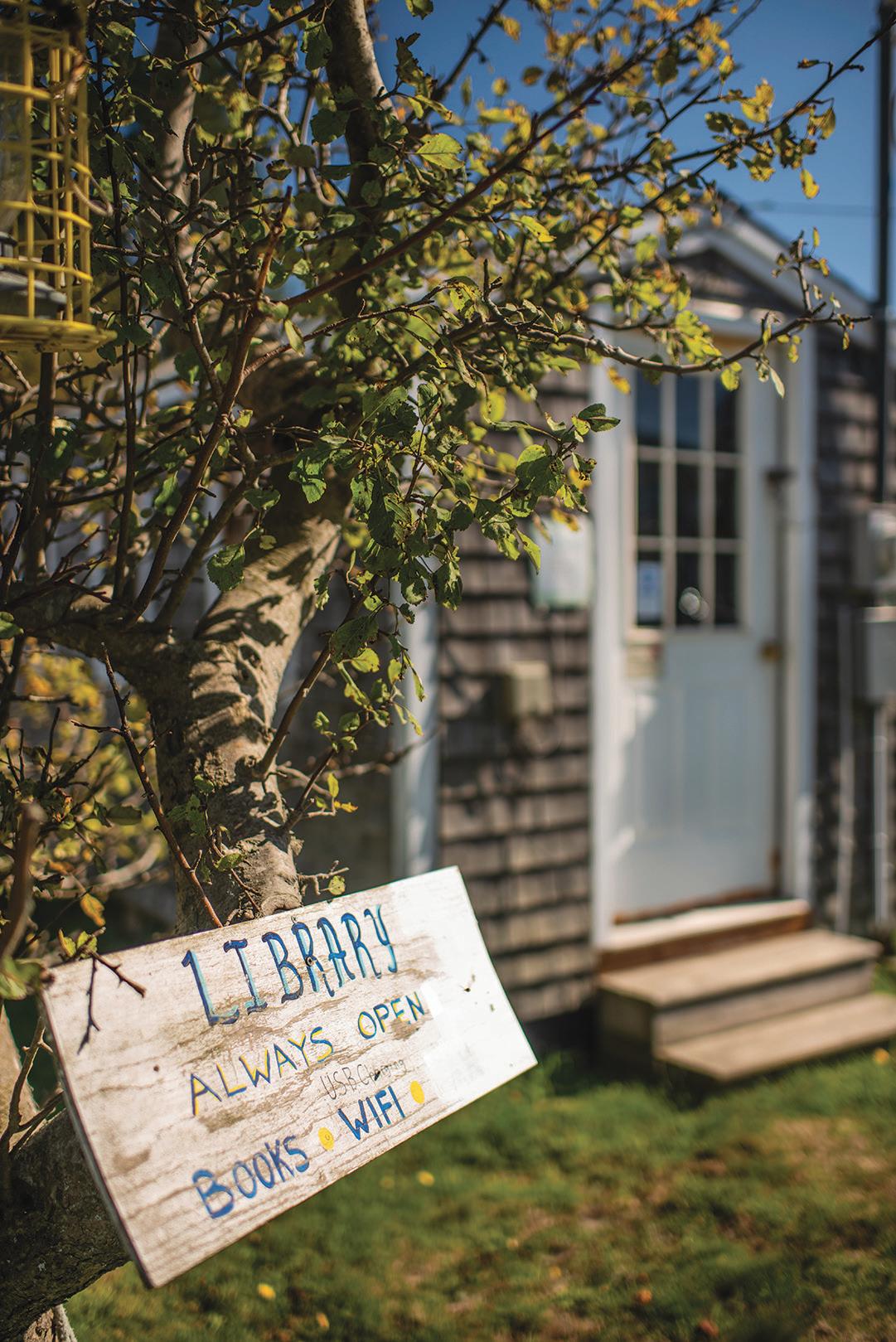
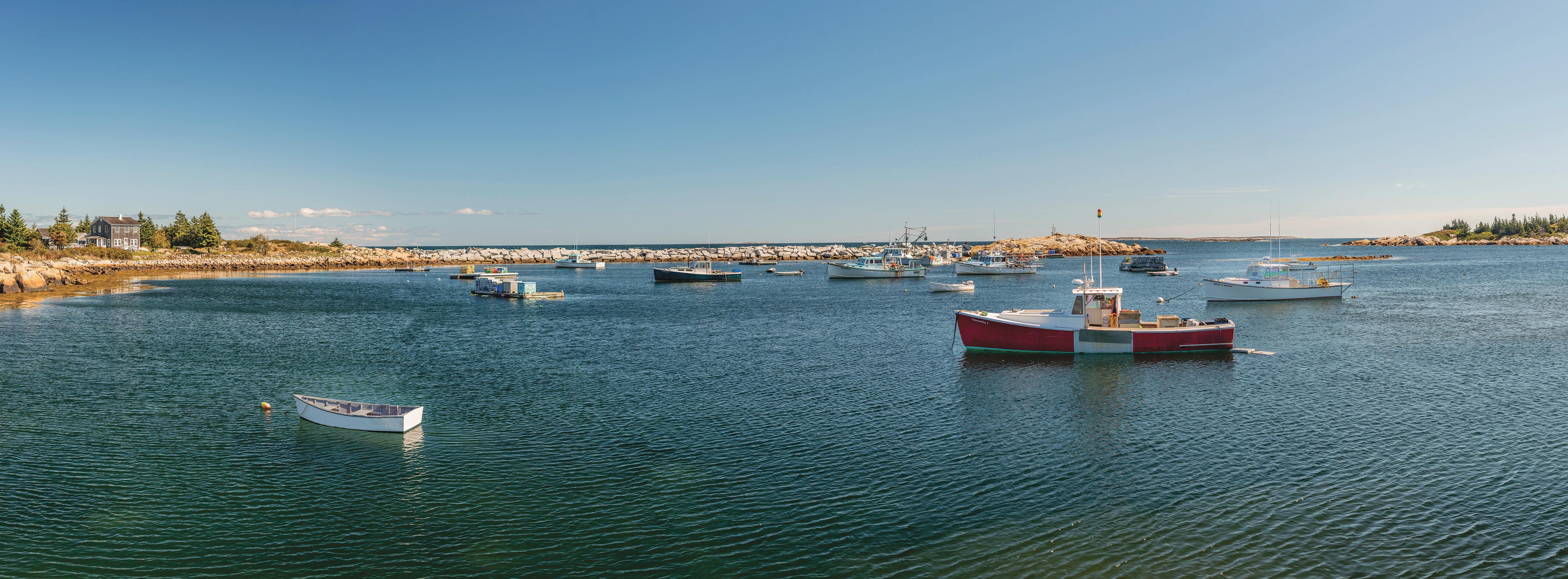
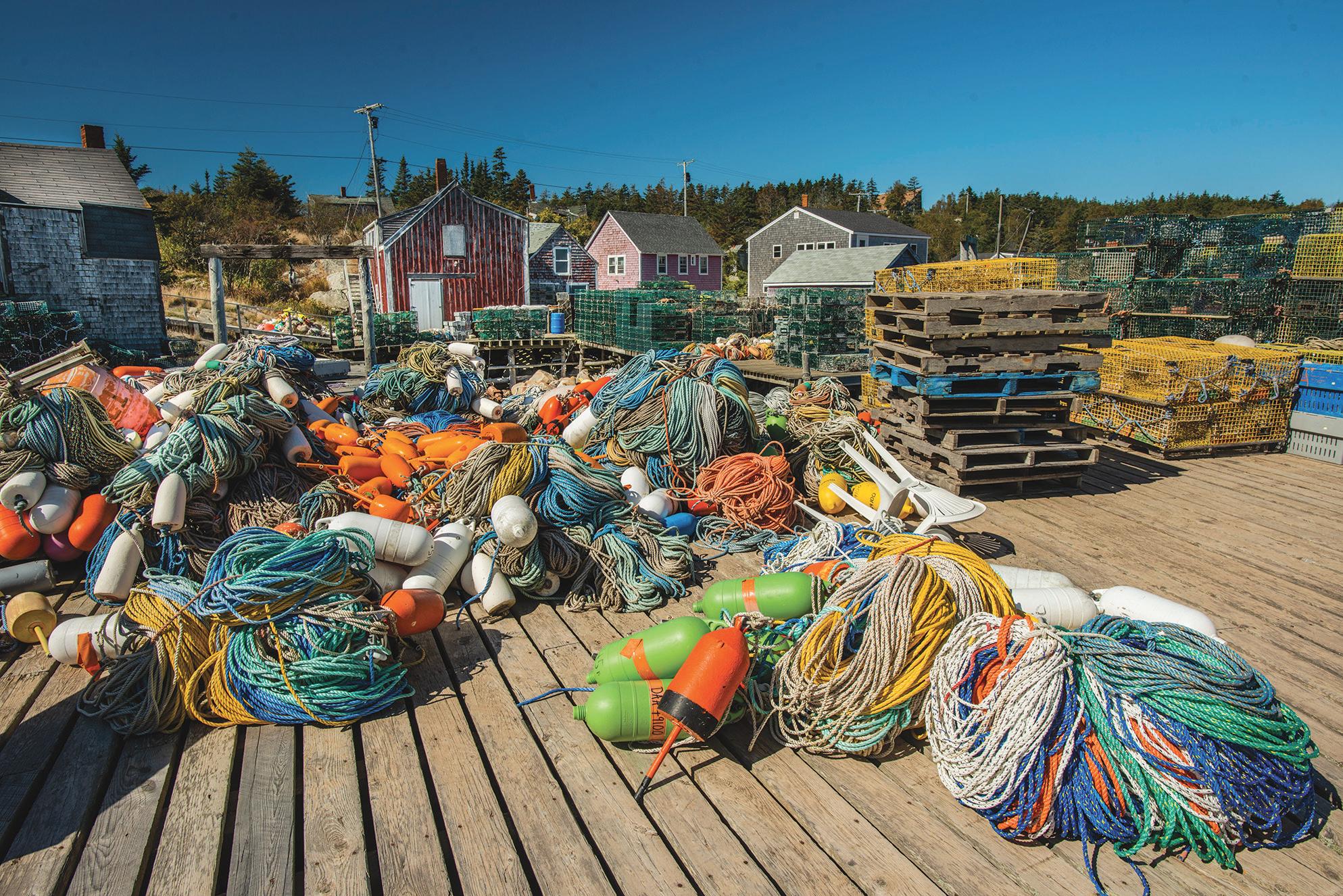
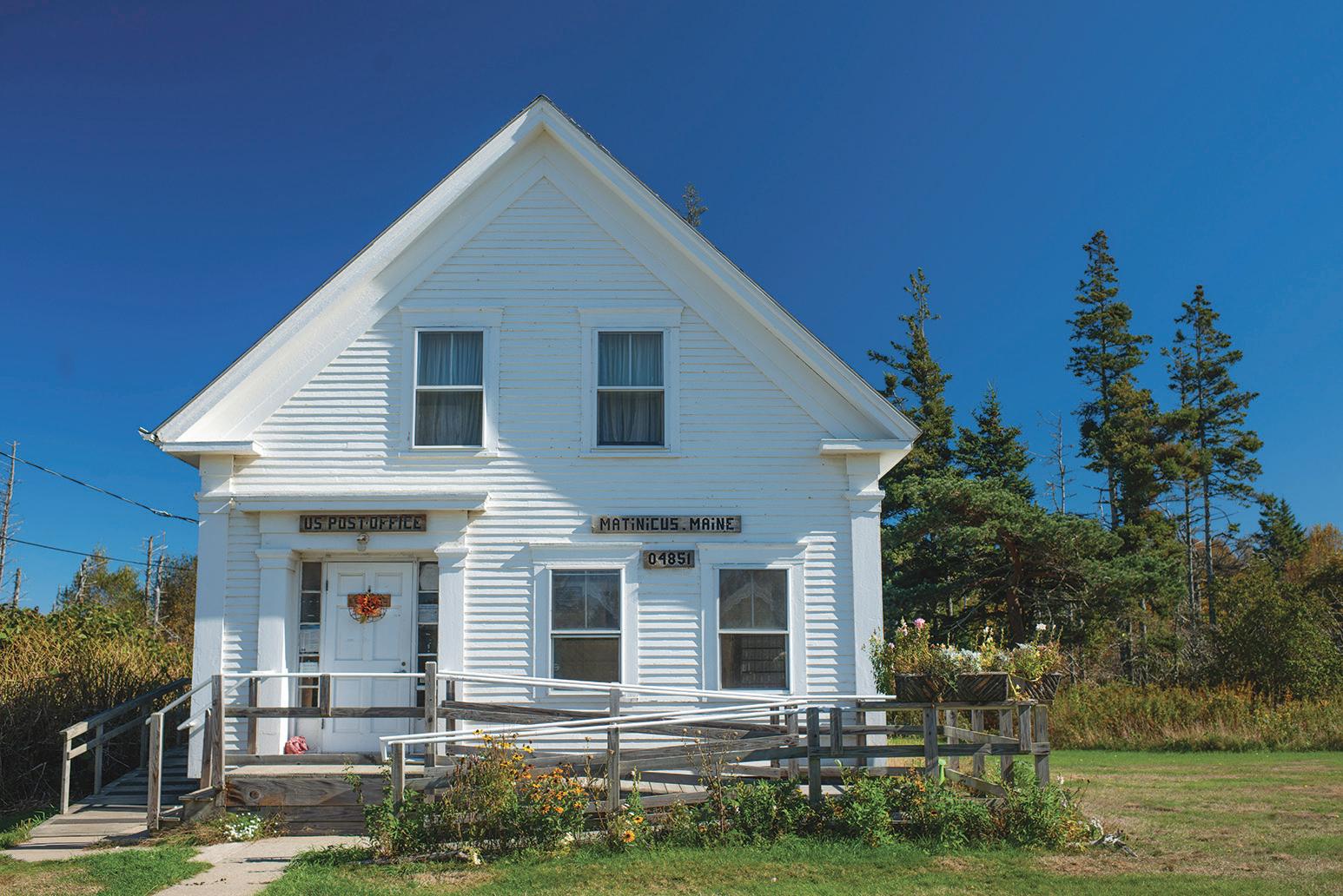
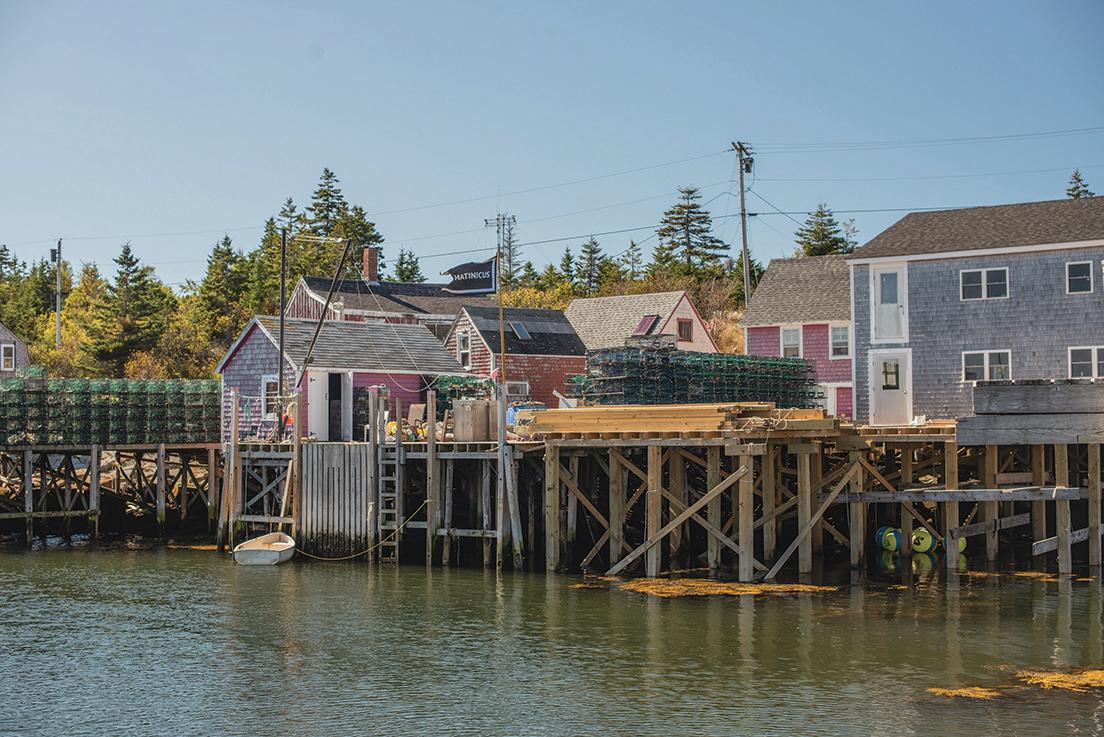 Photographer Michele Stapleton visited Matinicus in the outer reaches of Penobscot Bay in late September (see front page story) and captured the rugged beauty of this island outpost.
Photographer Michele Stapleton visited Matinicus in the outer reaches of Penobscot Bay in late September (see front page story) and captured the rugged beauty of this island outpost.

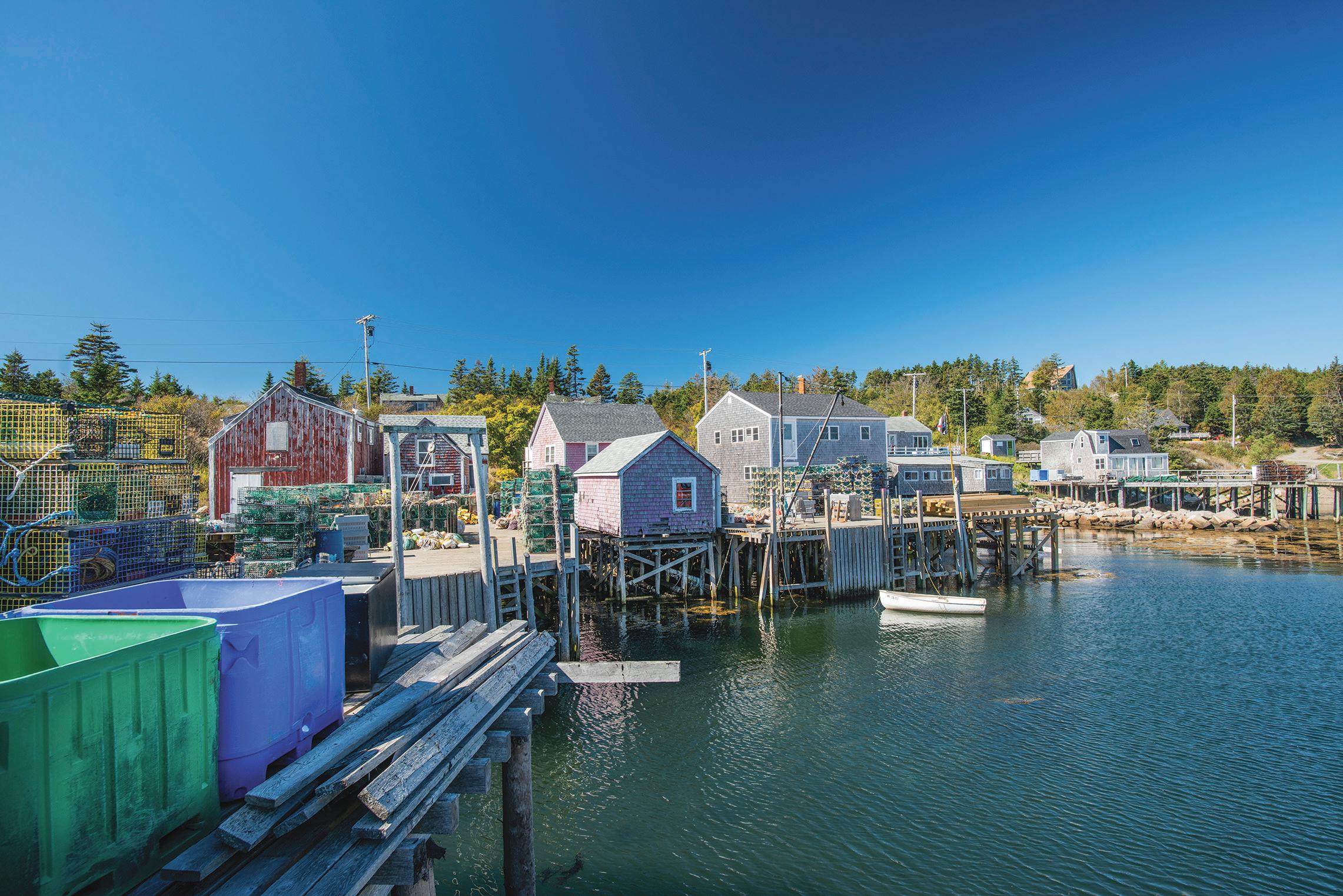
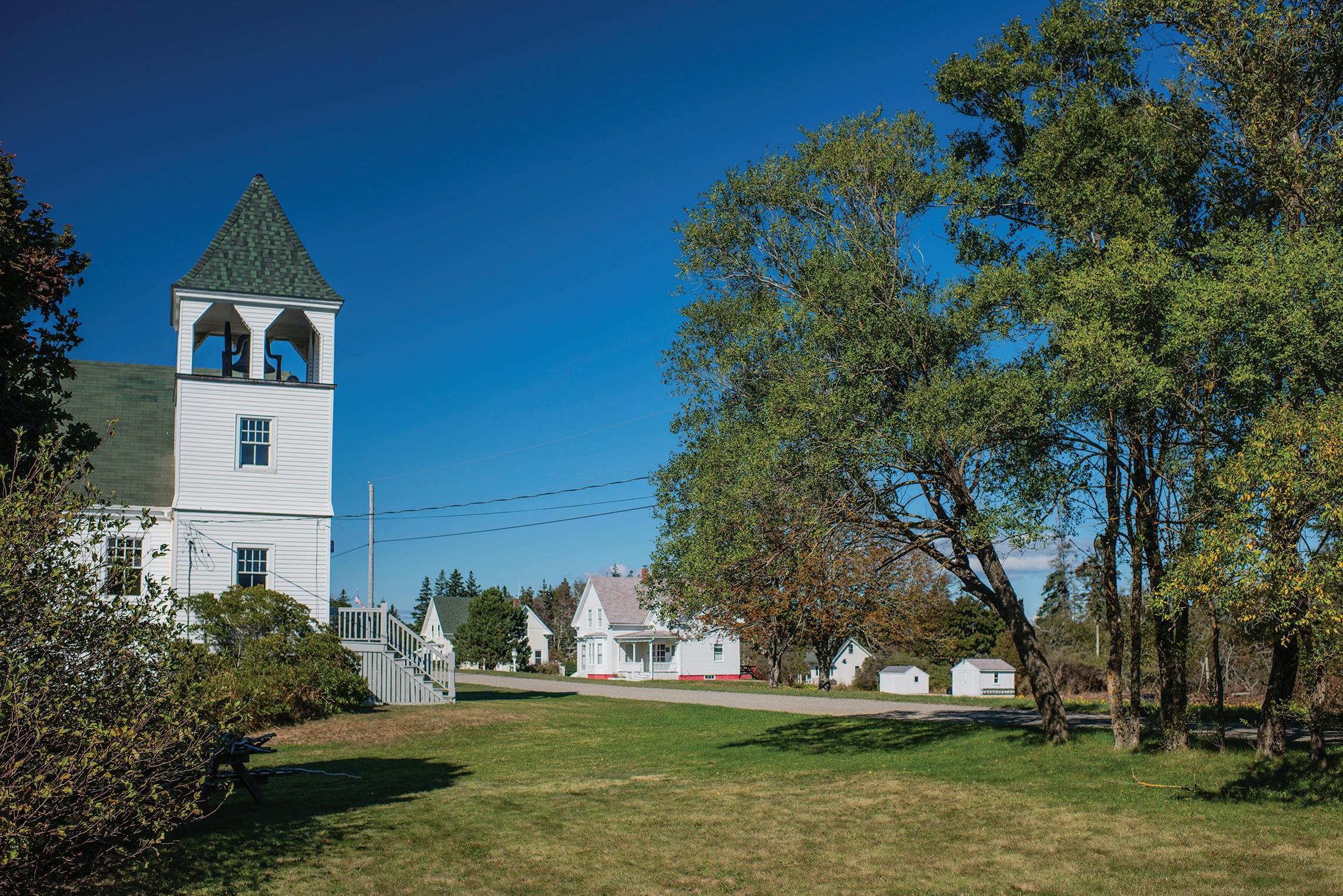
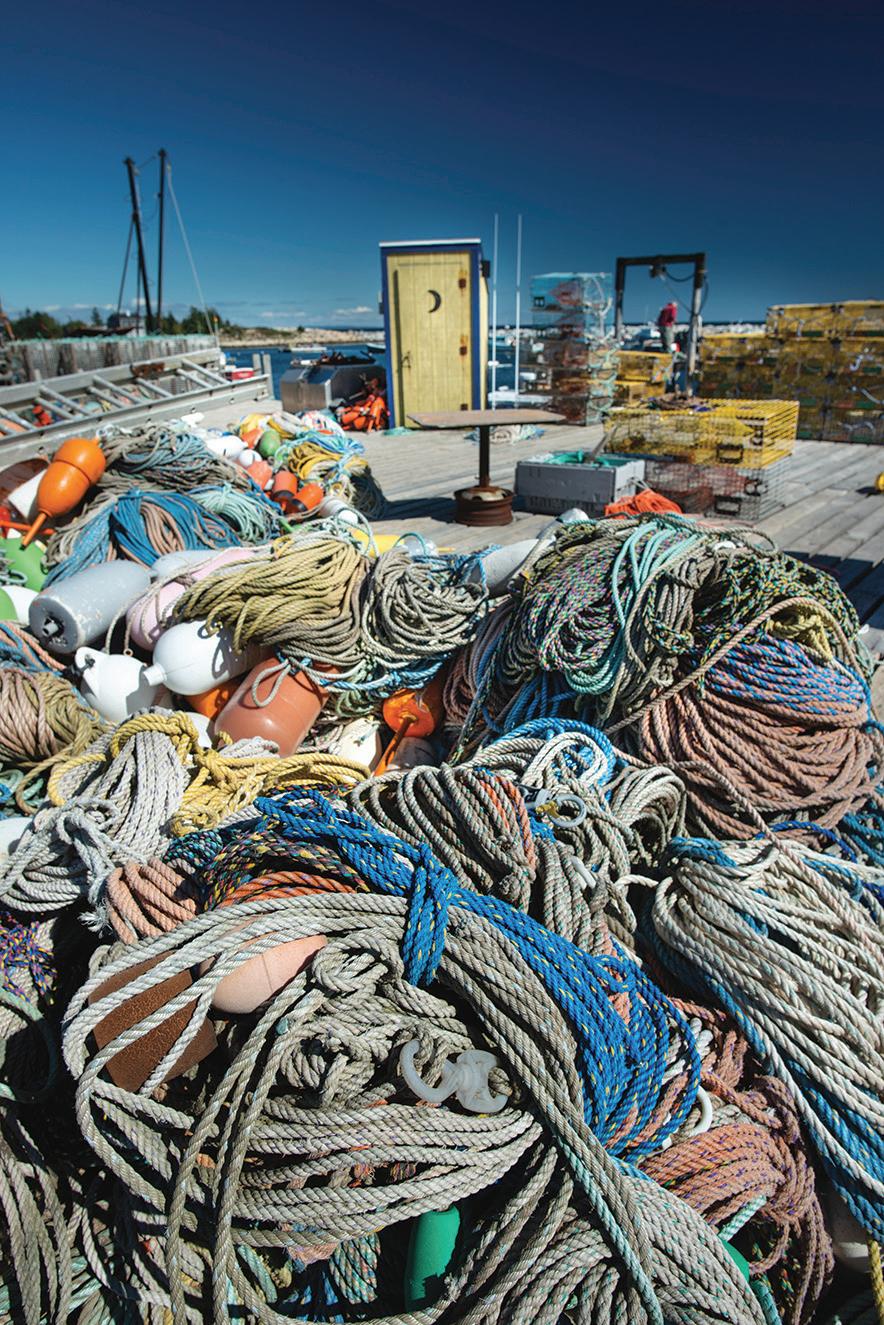
Our Island Communities
Housing is top need, survey finds North Haven narrows focus on town issues
By Sophie HansenTHE TOWN of North Haven is taking steps to address three issues affecting the year-round community:
• access to housing
• economic diversification and workforce development
• environmental sustainability and climate change impacts.
The limits imposed on human, natural, and housing resources on an island intensify these issues drastically.
According to Mia Colloredo-Mansfeld, an Island Institute Island Fellow working with the town on the community vision process that started in late August 2021, the priorities were determined after a commu nity survey and focus group conversations. A vision statement was created from this research.
“A vision statement and some clear priorities around that statement would help us focus and make good choices,” observed Town Administrator Rick Lattimer.
According to a findings report, 137 out of 387 people who participated selected access to housing as their highest priority.
Rex Crockett, 84, who was born on North Haven and has lived here for the last 60 years, said the hot real estate interest is changing the island.
Calling island artists, writers, creative spirits The Island Reader seeks submissions for 2023

The Island Reader, a creative arts anthology published annually by the Island Outreach program of Maine Seacoast Mission, is accepting submissions for its 2023 edition. The theme for this, the 17th edition, is “Island Families.” Creative works can relate to the theme or express the unique and beautiful experience of living on one of Maine’s outer islands.

Submissions are open to everyone who lives or spends time on our islands. Please submit work to The Island Reader through Maine Seacoast Mission’s website via this link: https:// seacoastmission.org/sunbeam/island-outreach/ the-island-reader/
Submission guidelines are available on the website. The deadline for submitting is Dec. 31. Express your creative side and island experi ence in The Island Reader. We would love to include you!
“These houses that come up for sale are just bought by the summer people which takes a home out of the year-round community,” he said.
Davidson Realty currently lists just two available homes on the island, selling for $500,000 and $6.4 million.
Lattimer explained that along with price increases, it is a lot more lucrative to make one’s house available for short-term rentals than longer term year-round rentals. Colloredo-Mansfeld added that on the island there is very limited housing stock, and the housing options that do exist are often not winterized.
To combat the housing crisis, the town is trying to shrink minimum lot size requirements and is applying for state money to support the creation of up to 12 rentable living spaces.
“There needs to be more places to live, especially for young people,” Crockett said.
Economic diversification and workforce develop ment were rated as the second highest priority.
Workforce development priority involves trying to get people, especially young people, trained in the trades, such as plumbing and electrical work. Colloredo-Mansfeld said they are “recognizing that there is a lot of demand for different services that aren’t being met on the island.”
Environmental sustainability and climate change impacts were rated as the third highest priority.
According to Lattimer, the island is particularly vulnerable to climate change, especially the village which has buildings just feet from the water. The town hopes to receive state money to fund building improvements to help mitigate the effects of climate change.
One of their first action steps is to make townowned facilities more sustainable and eco-friendly as well as engaging young people in raising aware ness about climate change and helping to reduce its impacts.
Maddie Hallowell, 24, who grew up on the island said, “This work is really important because it shows that the town cares about the North Haven commu nity and wants to move forward, not fall behind the rest of the world.”
Lattimer explained that no one cares who solves these problems or who gets the credit; it is just impor tant that these issues start getting addressed.
Sophie Hansen is a student at North Haven Community School.
A belfry, a rope, and a Leatherman
Island church celebration saved by women
On Aug. 15, 1957, an article appeared in Stonington’s Island Ad-Vantages newspaper reporting on the Isle au Haut church centennial: “Sunday was a great day down on the Gem of the Penobscot. The occasion was the centennial of the Isle au Haut Congregational Church. As the entire community walked up the long boardwalk to the church, the codfish weather vane pointed proudly to the westerly as it has done so many times during the course of the century, for this church and its steeple has not only been a spiritual guide to the bay for the past 100 years, it has also been a landmark for many a mariner in time of doubt.”

On Aug. 2 of this year, the Isle au Haut church celebrated its 165th birthday with a community bell ringing extravaganza: 165 rings on the old (1890) church bell. Young and old came to put their hand to pulling the rope that rings the bell, but after only 25 pulls, it wouldn’t budge. It was the Ladies Sewing Circle who resolved to build the church in 1857, and in 2022 it was two fearless women who volunteered to go up in the belfry tower to fix the bell.
Liz Wilke, a rock climber, and Kendra Chubbuck, a great grandmother, climbed up into the belfry. Neither were afraid of heights and thought they would be able to fix the bell.
Into the church and up the ladder to the attic they went, up another ladder, and another ladder, with a cell phone light and all was fine until they reached the ladder into the belfry itself.
At the second ladder there was a problem. Chubbuck wore a long skirt and could not safely climb any ladders. There was nothing to do but remove her skirt leaving her in a slip short enough to scramble up the ladders without issue.
She got up into the space with the bell and realized she did not have the right tool to cut away and reat tach the rope. Wilke climbed back down to ask the assem bled crowd and a Leatherman multitool was pulled out of a pocket and offered into service. Back up she went, the rope fixed, Chubbuck’s skirt redonned, and the bell commenced to ring.
Congregational Church.
After the event, Chubbuck went home and promptly bought a multi-tool Leatherman of her own to have on hand just in case as she has always been borrowing her husband’s Leatherman through the years and thought it was time to have her own.
Outside, the crowd ate cake and listened to chil dren play handbells and sing “Happy Birthday” to the church. Once the bell was repaired, everyone set their hands to pulling the rope to ring out 165 years.
Later, a smaller crowd went inside to hear brief summaries of the past 165 years interspersed with favorite old hymns, to the gentle light of the oil lamp chandelier.
The final words of the centennial benediction were, “The work of the Union Congregational Church of Isle au Haut is just begun!”
W.R. Allen’s donates antique canning equipment

Wild
Blueberry Heritage Center to open in 2023
Downeast Maine’s Wild Blueberry Heritage Center now owns some of the equipment that helped move the industry into the 20th century.
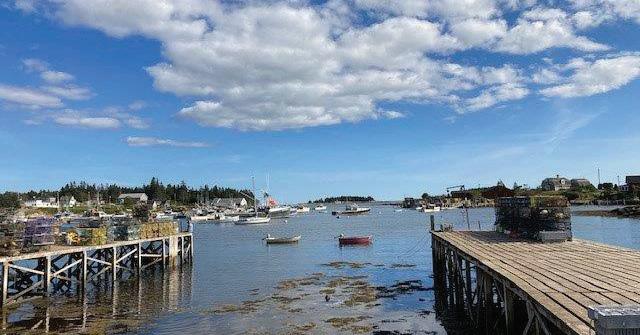
The Wild Blueberry Heritage Center will replace the iconic Wild Blueberry Land bakery and gift shop on Route 1 in Columbia Falls, transforming the giant blueberry dome into a museum and cultural center. The museum is set to open its doors to the public in June 2023.

Simeon Allen, vice-chairman of the Wild Blueberry Commission of Maine and co-owner of the family farm W.R. Allen’s, Inc., donated antique canning equipment to the heritage center.
Established in 1912, W.R. Allen’s has operated for five generations as a grower and processing facility of wild blueberries. In 1976, the processing plant transi tioned from a canning to a freezing operation.
Today, W.R. Allen’s grows and processes approxi mately 1.5 million pounds of wild blueberries each year. Other locally grown foods such as broccoli are also processed in its freezing facility in Orland.
The donated canning equipment included sealers from the Continental Canning Company for size #10 and #300 cans used in Allen’s canning operations. The canning conveyor line also was donated to the Wild Blueberry Heritage Center in addition to thousands of vintage W.R. Allen’s Wild Blueberry can labels.

The Continental Canning Company was founded in 1904 by Edwin Norton and T.G. Cranwell and operated in New York and Connecticut. The equip ment will help demonstrate the important history of canning in Maine’s agricultural industries.

The heritage center is volunteer based and is devel oping relationships with local schools and nonprofit organizations. Since the nonprofit’s founding in
2016, the center has slowly gained momentum while sharing the blueberry dome space with Wild Blueberry Land.
A team of volunteers including Island Institute Fellow Katie Liberman and AmeriCorps VISTA Member Kaysie Logan are working to expand the center’s museum offerings and educational programming.
Without committed industry members like W.R. Allen’s, the wild blueberry industry in Maine would not be where it is today. The Wild Blueberry Heritage Center aims to acknowledge and honor the work and legacy of wild blueberry growers and processors. The unique culture and way of life in Downeast Maine is something to be celebrated and shared with others.
Some topics featured in the museum include the history of canning, the ecology of wild blueberry barrens, and the oral histories from local community members. The museum aims to bring a sense of place to local community members and inspire future generations of wild blueberry growers
The WBHC is currently seeking support for both financial and in-kind donations. If you or a family member have a story about life in wild blueberry lands that you would like to share, or would like to make a financial donation, please contact the Wild Blueberry Heritage Center team at info@wildblueberryheritage center.org or visit wildblueberryheritagecenter.org/.
Simeon Allen and Katie Liberman, the Island Institute Fellow, pose in front of W.R. Allen’s wild blueberry processing plant holding some original canning labels from the company’s former canning operation.
 PHOTO: COURTESY KAYSIE LOGAN
PHOTO: COURTESY KAYSIE LOGAN
Warm wishes this holiday season to my buyers, sellers, and colleagues with many thanks to all for a great year. It has been gratifying to see buyers well matched to their new Maine properties and selling properties for my sellers to enable them to bring their future plans to fruition. Working with all of you has been a pleasure and I look forward to another great year.

Here’s to good health and a prosperous New Year to all!Deborah Jellison Magenta Sky with Bluebirds ERJ Studio Hearth and Harrow
Acadia is a dynamic science laboratory Schoodic Institute conference unveils change
By Tom GroeningNatural scientists couldn’t ask for a more accessible, varied, and dynamic subject to study than Acadia National Park. And, of course, it’s a beautiful place to work.
Some of the scientists examining this changing landscape presented their work at the Schoodic Institute’s Acadia National Park Science Symposium on Oct. 19, with work ranging from birds in spruce trees to a blocked-up cove.
“Rapid change in Acadia has not stopped during the pandemic,” said Nick Fisichelli, Schoodic Institute’s president and CEO, at the opening of the conference.
The park as living laboratory comes with substantial human interaction— some four million visit each year, reported park superintendent Kevin Schneider. One area where human impact is being studied and modified is on the trails at the summit of Cadillac Mountain.
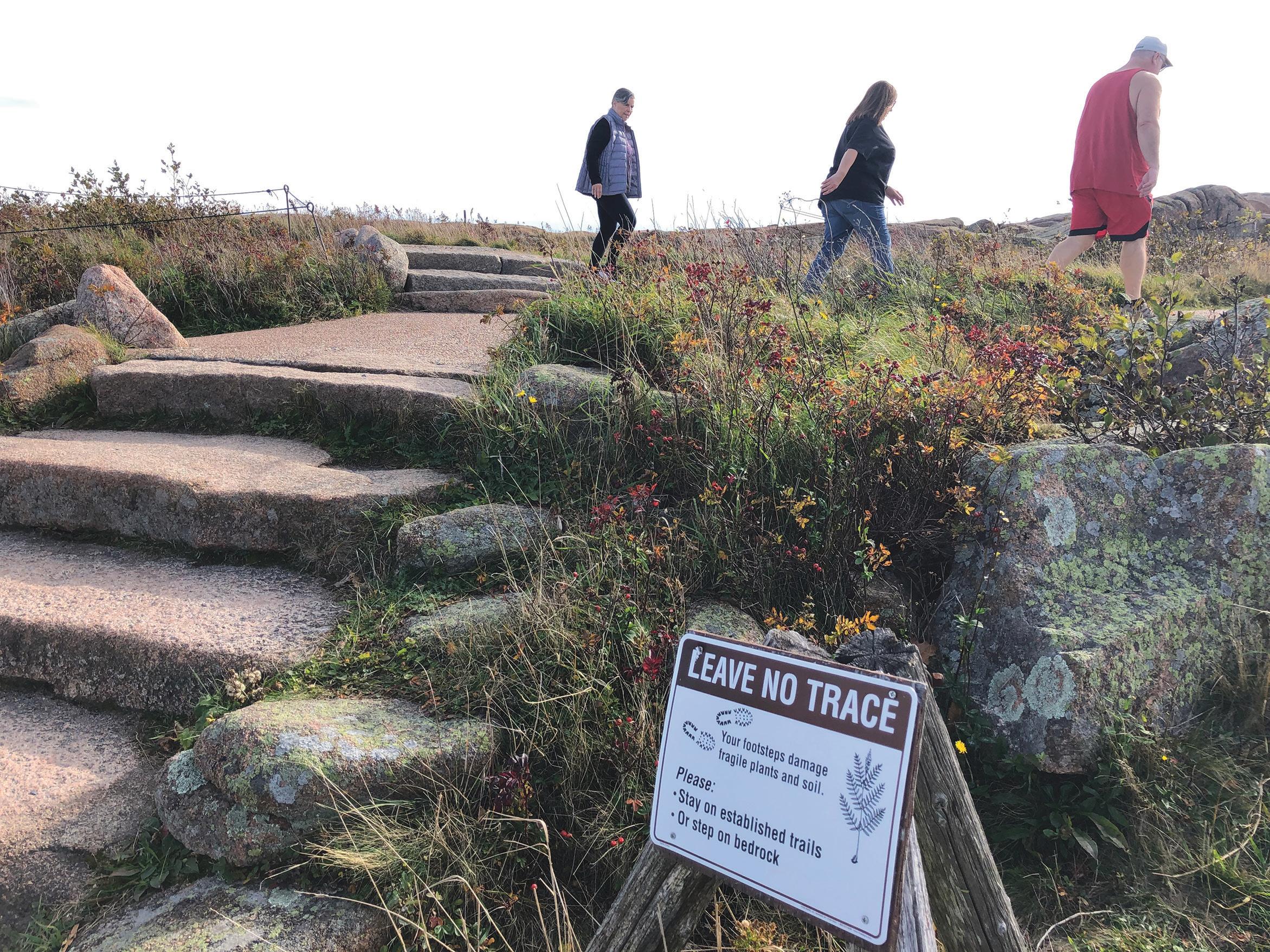
John Daigle, an associate professor at the University of Maine who works in its parks, recreation, and tourism program, said his study prompted the use of signs alerting the public to the sparse and vulnerable vegetation on the mountain. One sign included the phrase “Plants grow by the inch and die by the foot.”
While “Leave No Trace” signs with a line crossing through the image of a foot are effective, Daigle said the best
approach was to block access to vege tated areas with ropes and barriers.
One suggestion that emerged from the research was to reorient trails to face the sunrise and sunsets, because those events often drew visitors off existing trails.
A bit of Acadia’s history emerged in an ongoing environmental dilemma. Otter Cove, a landmark because the Park Loop Road is carried over it via a stone causeway, is suffering because of the lack of water flowing in and out.
Presenters said the causeway was built in 1939 in part to create a swim ming pool for locals to draw them away from areas enjoyed by the wealthy “rusticators.” The pool was never completed, and so today, three stone arches in the causeway allow tides to flow in and out—but not enough.
Another factor contributing to the poor environmental health of the cove is the legacy of a sewer treatment plant that operated upstream from 1976 to 1997. The outflow pipe was supposed to extend beyond the causeway but instead dumped into the intertidal zone, presenters said.
Clams have not been found in the cove, though invasive green crabs have been seen.
Locals continue to be engaged, with many hoping to redesign the causeway to allow more significant tidal flow.
Jay Wason of UMaine’s School of Forest Service told
the story of a spruce tree he named RD85. A photograph from 1940 depicted the subject tree, which he said died 50 years ago and now lies on the forest floor, covered in moss.
Though spruce dominated the coastal environment for the last 2,000 years, he said oak was the species most found here from 10,000 to 6,000 years ago. Spruce regeneration requires cool and moist conditions, Wason said, and those conditions held sway from 1850 to 2000. Spruce bud worm took a toll in the 1920s, and a general decline was noted from the 1940s through the 1970s.
The severe drought conditions this summer from Kittery to Rockland will slow spruce growth next year, he added.
The future does not look good, either, according to models. By 2060, “We will have no suitable habitat for red spruce,” Wason said, and accelerating warming will further impact the trees.
“We certainly have an uncertain future for our spruce trees,” he said. “I think we will have red spruce tree along the coast of Maine in a hundred years,” but where they will survive and thrive is not clear.
At the conference’s opening, Schoodic Institute’s Catherine Schmitt noted that “Acadia has this incredible legacy of science,” going back to before its founding, and that
a historical baseline for seascape and forestry is available.
Bik Wheeler of the National Park Service drew on that history in his work on bird behavior. In 1957, Robert MacArthur studied how different species of warblers would forage at different heights on spruce trees at Bass Harbor.
“They were actually partitioning the resources,” Wheeler said. Now, that behavior is less defined.
“Behavior is plastic,” Wheeler concluded.
Seth Benz, director of bird ecology at the Schoodic Institute, presented on diversity of species such as ants, spiders, and birds on the Schoodic Peninsula.
“It’s a transition zone,” he said, between southern deciduous and northern coniferous, creating a dynamic environment.
With phone-based apps like iNatu ralist, data is more readily available. Some 252 bird species have been documented on the peninsula, and in the period from Sept. 1 to Nov. 30, 105,000 migratory birds pass through, he said.
But the news isn’t all good. Since 1971, winter bird populations have declined on the peninsula by 43%.
line
Fewer cruise ship passengers in Bar Harbor
Airbnb,
tipped wages survive in Portland
Compiled by Tom GroeningALONG WITH voting in Maine’s gubernatorial and legislative races, residents of some coastal towns made choices on local issues. In Bar Harbor, an ordinance to more strictly regulate cruise ships passed, now limiting 1,000 passengers to come into town each day. Enforcement may remain elusive, though.
In the Boothbay area, residents rejected a referendum that would have mandated removing fluoride from the local water supply. Voters in 2004 approved the addition of the chemical. ~
PORTLAND VOTERS had a full ballot of local initiatives, including one on cruise ships that would have restricted the number of people getting off cruise ships at 1,000 per day beginning in 2025. It failed by a wide margin.
City residents also defeated measures to strengthen the mayor’s role while diminishing the city manager’s posi tion, and shot down a move that would have raised the minimum wage to $18 an hour and eliminated the tippedemployee wage.
Two referendums in the city that would have banned short-term rentals operated by corporations, required operators to live within 20 miles of the city, and required owners to live in the building, also failed.
Voters did approve a measure requiring landlords to give 90-day eviction notices, regardless of whether tenants hold leases or are at-will residents.
acre parcel of city-owned waterfront land. Dubbed “Belfast Yards,” one proposal from Mike Hurley, a city councilor, would encourage small lots to be divided so businesses, organi zations, and residents could develop buildings there.
Hurley argues that these smaller properties are absent from the downtown.
THE U.S. NAVY has found perfluoroalkyl and polyfluoroalkyl substances concentrated near the runway of the former Brunswick Naval Air Station, now Brunswick Landings, and “may be a primary source of PFAS” in local groundwater, the Harpswell Anchor reports.
The findings confirm what concerned residents believed, that chemicals used by the military are “migrating off the former base,” the paper reports.
AFTER RESIDENTS in Jonesport approved a referendum, restaurants are now able to serve alcohol for the first time. The vote was 431-160.
The measure was offered by a local dentist who opened a restaurant, the Bangor Daily News reports.
“I did not expect it to be that much of a landslide,” said Wayne Yee, who circulated a petition for the vote and owns a dental practice in the small fishing community.
In recent summers, that rocky island has not been able to produce enough water for Stonington’s public water system. The Stonington Water Company has had to have water trucked in from Bucksport—200,000 gallons a trip at a cost of about $25,000.
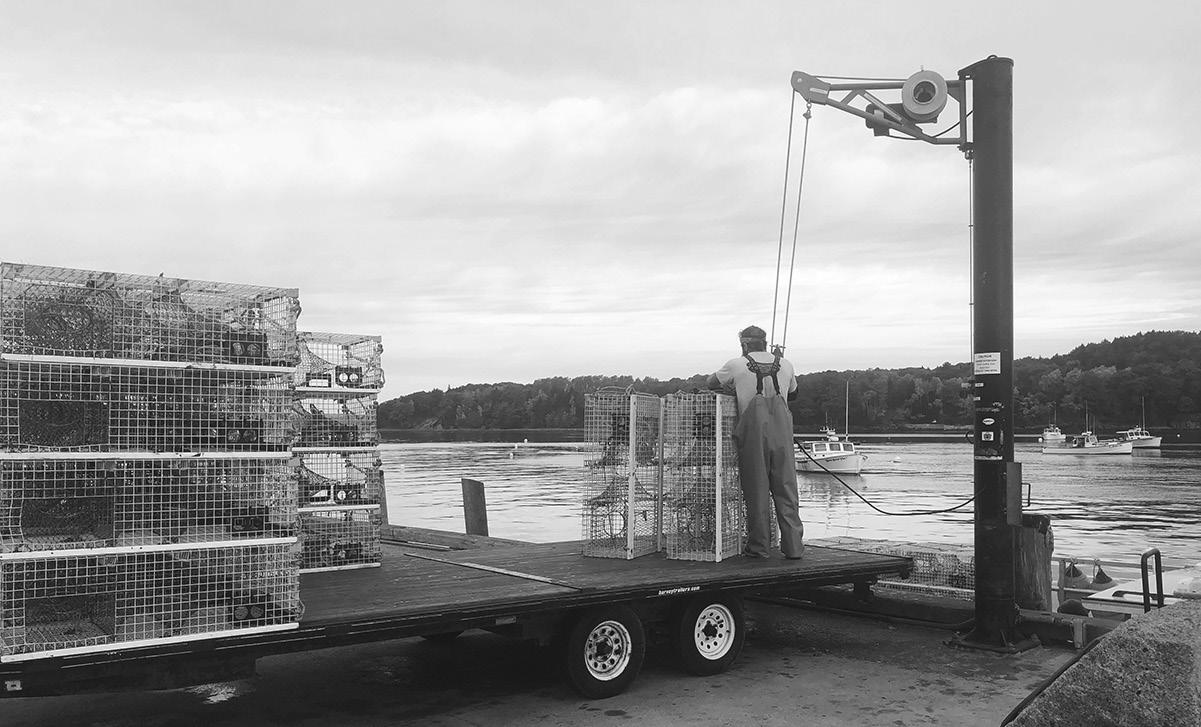
In February, an undetected burst pipe in a home closed for the season resulted in 103,000 gallons of water being wasted. The latest news is that a running toilet wasted about 130,000 gallons of water from mid-August to early October.
names. On Election Day in Castine, residents chose new potential names for islands in the Bagaduce River historically called Upper and Lower Negro islands.
Though the names’ history, which dates to the 1700s, is unclear, resi dents selected Esther Island and Emanuel Island, the names referencing two of the earliest enslaved African Americans living there. The names will be sent to a federal board that oversees such changes.
BELFAST’S CITY COUNCIL is again looking at ways to develop a one-plus
THE HEADLINE in the Deer IsleStonington newspaper Island AdVantages comes close to telling the whole story: “Not again: One toilet causes six-figure water loss.”
The toilet in question was in an apartment over a business. The owner of the building will have to pay for the overage, the water company reported. ~ ~ ~
FOR YEARS now, Maine has cleaned up part of the remnants of a racist past by replacing geographic
Aquaculture training offered in Belfast
Registration deadline is Dec. 1
A GROUP OF organizations in Maine are offering a training program designed for fishermen to learn how to farm seafood.
Maine’s vibrant working waterfront, including aquaculture, builds resil ience for generations of Maine’s fishing families who have long navigated the waters to feed our communities.
Hosted by Coastal Enterprises, Inc., Maine Aquaculture Association, Maine Aquaculture Innovation Center, and Maine Sea Grant, the Aquaculture in Shared Waters program focuses on the cultivation of commercially valu able species including oysters, mussels, scallops, and kelp. Students learn from leading industry, regulatory, and scien tific experts on fundamental topics like site selection, permitting, animal
husbandry, equipment, business planning, financing, marketing, and community relations.
“For the past ten years, the Aquaculture in Shared Waters course has served as a vital tool to help fish ermen learn to farm the sea, diver sify their income, and pioneer a new industry on Maine’s working water front,” said Sebastian Belle, executive director of the Maine Aquaculture Association. Since the program began in 2013, over 400 students have completed the course, 30 new aquacul ture businesses have been established, and 60 have been expanded.
“Having fished in Penobscot Bay and Southeast Alaska for many years, this training course was a great fit for me, and I’m now in the early stages of
starting a scallop farm,” said Michael Scott of Isle au Haut.
The Shared Waters program received national recognition in 2020 as the recipient of the Superior Outreach Programming Award from the National Sea Grant Program.
The 2023 course will begin on Jan. 3 and will be held Tuesday evenings from 6-8 p.m. each week for 14 sessions, concluding in early April with optional field trip opportunities in the spring.
The course will be offered in-person at the University of Maine Hutchinson Center in Belfast with an option to join virtually. The course is free of charge and applications are open to all based in Maine.
The 2023 course is made possible with funding from the Consolidated
A PROPOSAL by Worcester Holdings to construct a $1 billion Flagpole of Freedom Park in Columbia Falls—including a 1,776-foot tall pole (referencing the year 1776, of course)—has hit an early hurdle. The Quoddy Tides reports that developers “balked at a request by the town of Columbia Falls for $150,000 to be placed in escrow to cover the town’s costs related to the project.”
Appropriations Act, administered through the Maine Department of Marine Resources. Applications will be accepted at http://www.aquaculturein sharedwaters.org/ until Dec. 1.
According to the Maine Aquaculture Association, aquaculture in Maine is among the most diverse sea farming sectors in the nation, producing more than 25 diverse species of finfish, shell fish and sea vegetables, more than any other U.S. state.
Maine aquaculture has enjoyed responsible growth over the last 20 years at an average rate of 2 percent. Less than 1% of Maine’s coastal waters are used for aquaculture. More than 99% of Maine sea farms are family-owned. For more facts about Maine aquaculture, please visit https://maineaqua.org/.
Ruohomaa featured in Freeport
Photos show ‘fading, old New England’
Penobscot Marine Museum presents Kosti Ruohomaa: The Maine Assignments, an exhibit showcasing photographer Kosti Ruohomaa’s works featuring Maine scenes. Beginning Nov. 25, the exhibit will be on display at Freeport Antiques and Heirlooms Showcase at 31 Main Street in Freeport. Admission is free.
Town meeting, painting lines, eating doughnuts, and throwing rocks
By Barbara FernaldACTIVITY on the islands, at the end of February and into March, is like a mirror image of the action at the end of August into September. Just as the summer residents of the Cranberry Isles end their vacations right before fall, many year-round residents end their winter breaks just before the spring equinox.
Kosti Ruohomaa was a prominent mid-20th century photojournalist who grew up in Rockland. He was a first-generation Finnish American immi grant and a gifted artist who died young.
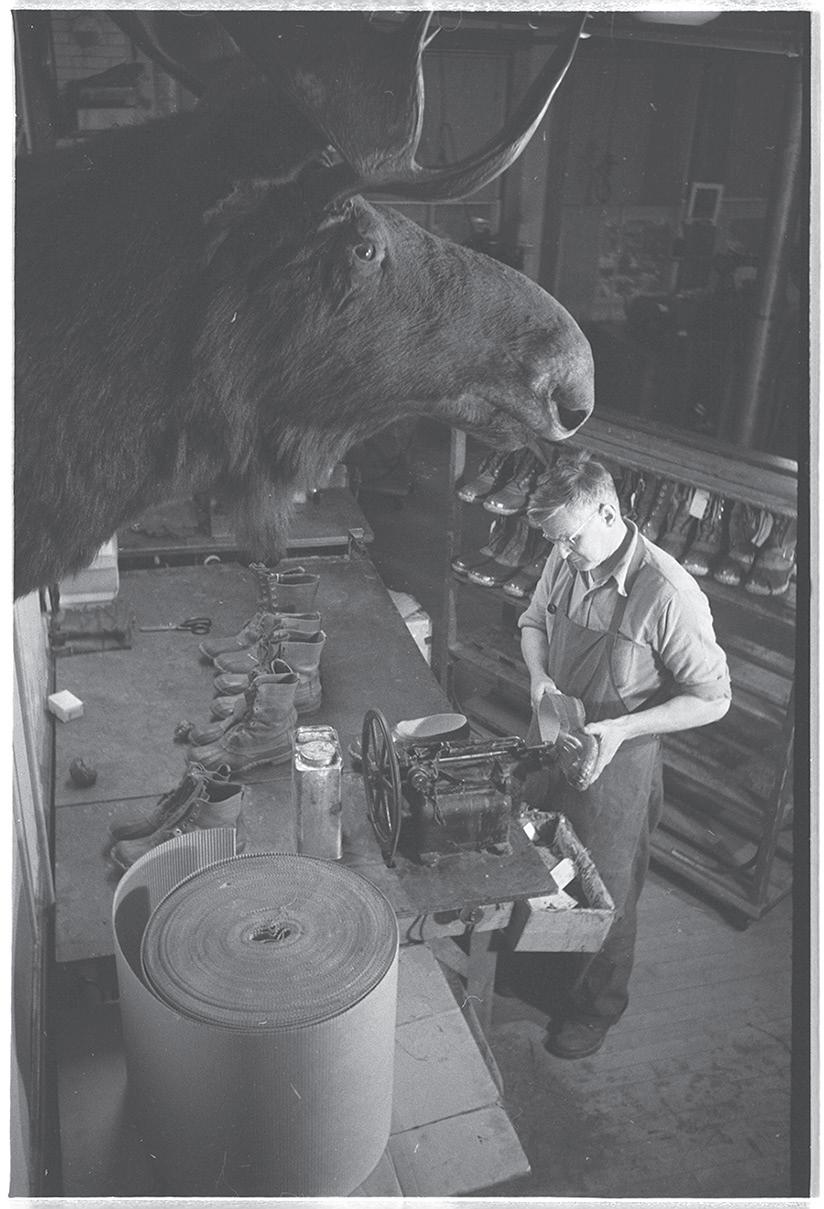
It’s time to get back to work and reconnect.
Though his professional work spanned just over two decades, he documented a critical time in American culture by photographing around the World War II years. During his career, his photos found their way into some of the era’s more visible publications, notably Life, Look, and National Geographic.
Our annual town meeting takes place on the second Saturday in March. For selectmen and town employees, winter has been anything but a vaca tion. They have been working steadily, gathering information to write the warrant for town meeting. It’s the time of year we come together as a town to decide on projects and spending and how much money is to be raised by property taxes.
The affinity he felt with people and places shows in his photographs, and it helped him capture the varied folk ways of an America that was changing rapidly, particularly the fading world of rural old New England.
Discussion of the school budget alone can take well over an hour. The islands take turns hosting the meet ing and the luncheon. This year, town
As
With a focus on his Maine-based photographic assignments, Kosti Ruohomaa: The Maine Assignments explores the ways that Mainers lived, celebrated, made their livings, recre ated, and communicated.
winter winds down, islanders mix prep work and gatherings
meeting will take place on Islesford. What’s for lunch? Homemade pizzas, salads, and desserts. Life gets busier as we volunteer to help prepare the first community meal of the season.
While many of Ruohomaa’s most iconic images stand on their own, he approached his assignments with a photo essay in mind—telling the story through a series of photographs. This exhibit embraces that approach and presents his assign ments through the eye of a magazine editor. It allows a deeper look at Ruohomaa’s work and technique and helps viewers gain more insight into the man and his photographs.
bright red with a black stripe) and, like every other lobster fisherman in Maine this winter, he read about, talked about, and experimented with purple paint.
Town meeting is a great opportu nity to hear about winter from friends and neighbors. “How was your trip to ...?” “Who knew grand-parenting was so exhausting or that there were so many cold germs involved?” “You did all that painting?” These same ques tions could be asked in September at a school board meeting in a large sub urb. (Preferably not during the meet ing while someone else has the floor!)
In January and February, Bruce and I got to spend a lot of time with our grandchildren in Southern Maine. Visiting them was the main goal of most of our winter travel. We consid ered trying to paint our kitchen, but we kept catching odd coughing virus es and experienced more down time than we wanted, so we never got to it. Maybe I’ll paint it in May, when I can have the windows open.
Kosti Ruohomaa: The Maine Assignments has been funded in part by generous support from lead sponsor L.L Bean and by Camden National Wealth Management and Allen Insurance and Financial.
Penobscot Marine Museum brings Maine’s maritime history to life on a campus of beautiful historic buildings in the charming seacoast village of Searsport, Maine. Exhibits throughout the campus tell unique stories of ship

Bruce saw more than enough paint, anyway, this winter. During his “time off” he painted 600 buoys (white and
The latest whale regulations require all Maine lobster fishermen to use new markings on the ropes they attach to lobster traps. Depending on how close to shore they fish, they will have to add 2-4 purple marks on each buoy line. On warps that are 100-feet or less there must be one 12-inch purple mark with in a few fathoms of the trap and a 36inch purple mark within 2 fathoms of the buoy. If the warp is longer that 100 feet, the requirement is for a 12-inch purple mark near the trap, a second 12inch purple mark halfway to the buoy, and a 36-inch mark near the buoy.
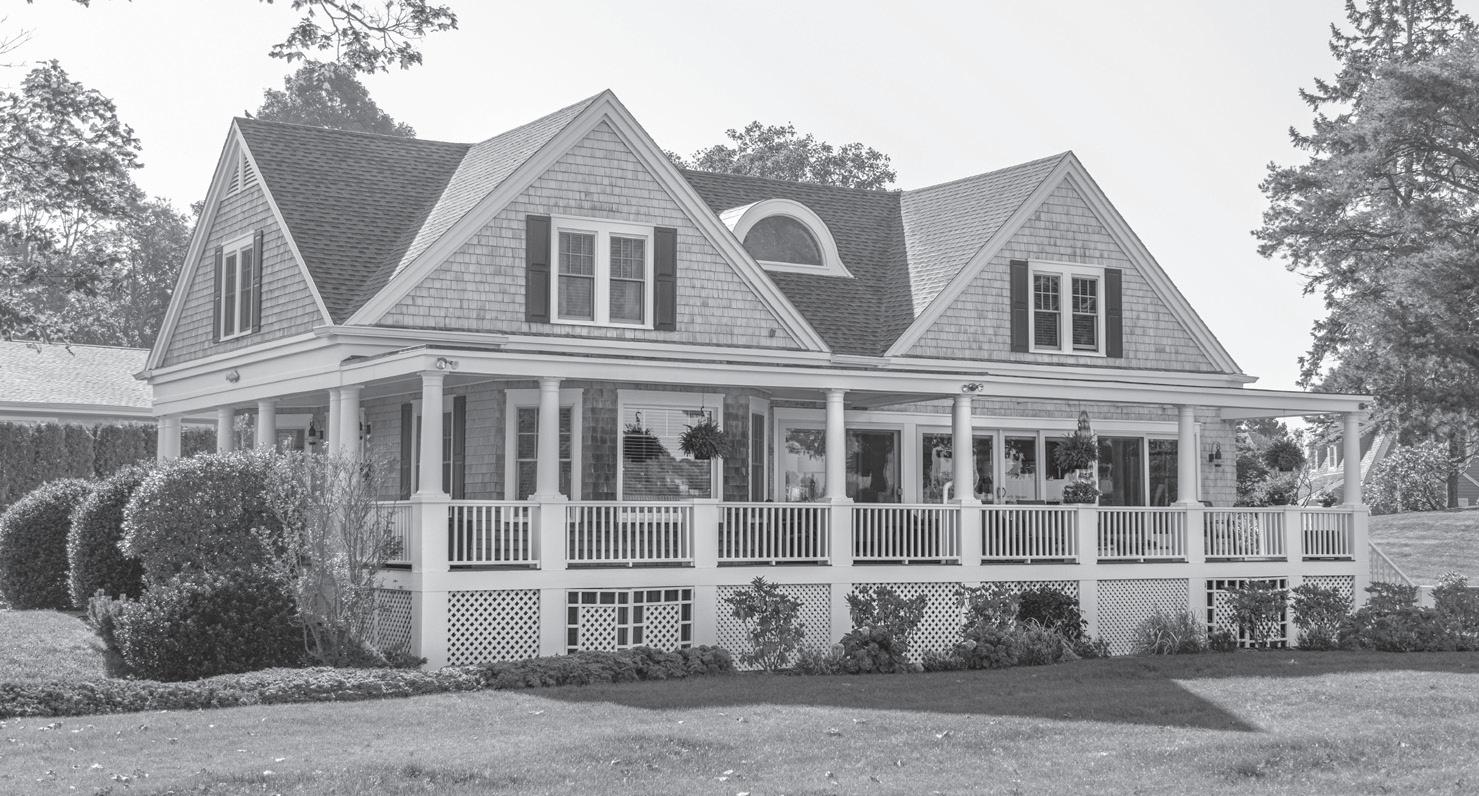
Houses come in many shapes and sizes—and so does homeowners insurance. With homebuilding costs on the rise, it is vital for you to make sure that your house has replacement cost coverage so that you can rebuild as it was before it was destroyed or purchase brand new items if your old ones are damaged or stolen.
Contact us for a free review of your home insurance.
captains and their families, the indus tries of Penobscot Bay, global maritime trade, and today’s fisheries.
In addition to exhibits, Penobscot Marine Museum has over 300,000
Bruce figures he will be putting 1,500 to 1,800 markings on his rope in all; two to three weeks of extra work if he does it without hiring help. A number of fish ermen are applying paint to their ropes by resting them in 3-foot long gutters made from lengthwise-halved PVC pipe. Bruce’s first attempt was with spray paint but he soon moved on to the more effi cient brush and latex paint.
Some fishermen will add a 3-foot
throwing rocks at the beach—if that isn’t a mirror image of many child hood summers on Islesford, I don’t know what is. q
historic photographs, an extensive collection of maritime artifacts and archives, and a maritime history research library. Visit penobscot marinemuseum.org to learn more.
While many of Ruohomaa’s most iconic images stand on their own, he approached his assignments with a photo essay in mind
olumn
How to shrink your seafood footprint
Good news, if consumers make right choices
By Paul GreenbergOVER THE COURSE of the last few years I’ve been writing a lot about climate and carbon footprints. But long before I dipped my toe into greenhouse gas emissions, fish and shellfish were my bread and butter.
Over the course of a trilogy of books, I’ve tracked issues of overfishing, aqua culture, and health up and down the marine food chain.
So it’s no surprise when I set out to write my latest book, The Climate Diet, I ended up looking at the carbon footprint of seafood.
There are many reasons to be careful with our seafood consumption.
Since World War II, humans have quadrupled the amount of wildlife they remove from the sea annually, to the point where we now extract about 85 million tons on a yearly basis—the equivalent of the human weight of China. The damage all of this causes is getting more and more attention.
Overfishing, sea slavery, the destruc tion of the marine environment, and many of the other problems that plague the seafood industry were explosively catalogued in this year’s controversial Netflix documentary, Seaspiracy.
But curiously, when we look at the carbon footprint of seafood—i.e. the amount of greenhouse gases emitted per meal—we actually find some reasons to choose fish for our plates. In general, wild fish are significantly more carbon efficient than our most efficient terrestrial animal protein—chicken.
An average of all American wildcaught finfish comes in at 1.6 kilo grams of emissions per kilogram of edible fish flesh, this compared with around 6 kilos of emissions per kilo of chicken or a whopping 27 kilos of emissions per kilo of beef. The reason for the protein’s relatively light finprint is that wild fish don’t require feed or husbandry to reach harvestable size. Nature takes care of that.
The primary emissions cost of wild fish is the burden of catching them and transporting them to market. All this said, not all fish are good emis sions bargains.
The word “seafood” itself encom passes thousands of species caught and grown in dozens of different ways.
Fishing methods that entail long jour neys into distant waters with repeated stops to haul gear burn a lot of diesel.

So, for instance, longline-caught tuna and swordfish sit near the top of the fisheries’ emissions list. Dragging heavy gear over the seafloor is also carbon-expensive, making flounder, cod, and other bottom-trawled fish emissions-costly meals.
Farmed seafood presents other dilemmas. It’s diffi cult to assess the carbon footprints of the dozens of different species because there are so many vari ables. What’s more, feeding farmed seafood requires the extraction of a good deal of wild fish from the ocean; then, the processing of that feed contributes to an overall emissions per kilo rate that is some where between chicken and pork.
Shrimp is by far the most consumed seafood in the United States. Out of the 15 pounds of fish and shellfish Americans eat each year, more than 4 pounds are shrimp. But shrimp, particularly farmed shrimp, is notably terrible from an emissions point of view—by some estimates at the level of beef. That’s in part because over the last few decades, shrimp farming has destroyed millions of acres of one of the world’s most powerful carbon-sequestering ecosystems: mangrove forests.
Mangroves, on average, store more than twice the carbon dioxide per acre as tropical rainfor ests, but are often cleared to make way for coastal shrimp ponds. All this makes a shrimp cocktail an extremely carbonintensive appetizer.
So, what should we eat from the sea if we want to have the lowest carbon finprint?

Good carbon bargains tend to be seafood caught in midwater trawls and purse seines— nets that don’t touch the bottom of the ocean. Alaska pollock (the fish most commonly found in your Filet-O-Fish) and small pelagic fish like mackerel,
sardines, herring, squid, and anchovies all fall into this carbon-light category. Wild salmon is also a winner, as long as you buy it frozen; air-freighted fresh fish of any kind is a carbon disaster because of the extremely high carbon cost of flying.
And how about that carbon-costly shrimp cocktail appetizer? Probably the single best swap you can make is to change your appetizer from shrimp to oysters. Farmed oysters, along with their cousins the clam and the mussel, are extremely carbon-light. They require no feed, subsisting on a diet of wild algae, and filter and clean the water as they grow fat. All this puts some bivalves in the same carbon cost range as many vegetables.
Mussels, the grand emissions champions of the animal kingdom (and also one of the most affordable seafoods out there), can cost just .6 kilograms of carbon and other greenhouse gasses per kilo gram of mussel meat.
And the great thing is that mussels adapt well to a whole range of
culinary traditions. Do them simply, Mediterranean style with white wine and garlic. Fire them up in a Thaiinspired spicy curry or make them sing in the tune of masala.
And because mussels are so inexpen sive, you can be expansive with them. I personally like to lightly steam them and then deep fry them as a substitute for oysters in my po boys. Whichever way you make them, you can take the added pleasure that you’re doing your best to cook mindfully from the sea.
Paul Greenberg is the New York Times bestselling author of Four Fish and six other books including, most recently, The Climate Diet. An earlier version of this story first appeared on the site Food52.com

Farmed oysters, along with their cousins the clam and the mussel, are extremely carbon-light.
In general, wild fish are significantly more carbon efficient than our most efficient terrestrial animal protein…
saltwate R C u R e
What keeps this teacher on the job Island school offers personal student impact
By Courtney NaliboffTHE NUMBER 18 has a certain significance in Jewish numerology. The letters used in writing the Hebrew word chai—life—are assigned the numbers ten and eight. Monetary donations and gifts are often given in multiples of 18, and 18 is associated with life and luck.
This is the 18th year we’ve lived on North Haven, and my 18th year as a teacher at North Haven Community School. I have one colleague left from my first year as a teacher and have seen more colleagues come and go than I can count.
We were asked recently to consider what factors lead to teacher retention and longevity, and while I don’t have any universal answers, I know what has worked for me.
For better or worse, living in the (very small) community in which you teach forces your coworkers, students, and the community at large to get to know you as a person as well as a teacher. That could sometimes feel scary and
invasive, but when I was given oppor tunities to teach content that directly connected to my experiences—a rock band class, or an English class focused on memoir—it made me feel as though I specifically had something to offer to the job, rather than any ol’ music teacher. Those opportunities have come up pretty consistently, and help the work feel fresh.
Opportunities to do something authentic, rather than just engage with content theoreti cally, have also helped me stay in this job for as long as I have.
September 2005, the start of my teaching career, was also the time when Hurricane Katrina and its aftermath devastated New Orleans. With the administration’s permission, I launched an all-jazz curriculum for my first six weeks as a teacher and shared the students’ work (along with Maine
jazz greats Brad Terry and Cassidy Holden) at a benefit concert for Habitat for Humanity.
Filmmaking, whale-building, service projects, a weekly video news program, and performing at professional base ball and hockey games have kept the work I do with my students meaningful.
As challenging as teaching K-12 can be, and as much as I may sometimes wish I were a member of a depart ment, working with students from their first day of school until they graduate is an incredible privilege. Some of them love music from day one and some of them never find their groove, but when it clicks, I get to be there and help foster their engagement, whether it’s band, chorus, acoustic guitar, or punk rock. I even had the recent pleasure of a former student who rolled his eyes
Jou R nal of an island k itC hen
Why hide the heart of the home?
By Sandy OliverSPOTTED RECENTLY in a mainstream national newspaper: the phenomenon of the “back kitchen.” Apparently increasingly common in million-plus dollar homes, the back kitchen accommodates all the messy business of actually preparing food and cleaning up after it, while the other kitchen stays neat and tidy for social events like children’s birthday parties and casual adult drinks and appetizer events.
Why? As one back-kitchen owner said, otherwise all the photos and videos of the event showed all the mess of throwing a party. I mean, you wouldn’t want dirty dishes to besmirch your record of an event. Made me wonder if they also wiped the icing off little kid noses before snapping a picture.
The sheer exhausting pretension of this sent me into paroxysms of selfrighteous contempt. Oh, get over yourselves, I thought. This smacks, I thought, of the separation of kitchen from home wherever servants or slaves labored—kitchens in castles, chateaus, palaces, stately homes, mansions— kitchens buried in basements or exten sions, or even another building, to keep food mess and laborers far from the ones who dined. Ugh.
Some people would be grateful to have one merely good working kitchen, with functional plumbing, refrigeration, an operational stove, and washable surfaces, never mind a kitchen with an actual soul.
We moderns push our luck with galley kitchens which often occupy part of a larger family space where kids can sprawl with homework or video games, non-cooks can read the paper, or converse with the cook or pals, where sociability occurs in ear shot or sight of the one peeling potatoes, mixing cakes, and washing up.
More desirable, I believe, is a kitchen commodious enough to accommodate a helper or companiable friend lending a helping hand, or a youthful, aspira tional cook pleading, “Let me help, I can do it.”
Some cooks, of course, prefer solitary splendor where they can concentrate uninterrupted on the task at hand, so for them a little isolation benefits.
An absolutely perfect kitchen would be the one I remember at my grandma’s house when I was very young. A black and chrome cookstove, burning kero sene, heated the space and warmed the maternal backside. I don’t recall Gram leaning against the stove, but Mom took ribbing about singed apron strings. I lean against my stove, too, and perfectly understand the attraction.
In the center of Gram’s kitchen sat a green painted table, used for a work surface and for socializing and eating. Grandmother-made flour-sack table cloths covered it at mealtime and the treadle-operated sewing machine she used to make them sat against the wall under the staircase.
Grampa occupied a Morris chair in one corner, next to the Hoosier cabinet. A kitchen sink with a window next to it filled another corner. Cat dishes occu pied a spot on the floor by the stove.
Gram and Grampa had another room for state occasions, half-living room, half dining-room. I recall Thanksgiving in there but remember many more times in the kitchen, the center of their sometimes difficult domestic life, as they struggled their way out of the Great Depression, huddled the night of the ’38 hurricane, sat out World War II counting ration points, and stormed about Grandpa’s alcoholism.
Quite probably, I’m projecting personal kitchen preferences here. I love my kitchen which occupies a space in the ell separated in the late 1880s from the main house by Capt. Bunker so that he and Adriana could swank it up a bit with a dedicated living room, dining room, and parlor. The house has a front door, though a large assertive doorbell on the kitchen door signals that here was the main entry.
every time I told him how well he could sing in middle school chorus performing a set with his exquisitely talented partner at Turner Farm.
Teaching is one of those professions that necessitates a certain amount of passion to offset the challenges of sometimes onerous requirements, high turnover rates, middling salary, and difficult interactions with parents and community members. I’m not sure I can promise another 18 years, but sitting down and reminding myself of some of the unique joys of Maine’s smallest K-12 public school will keep me going for a while longer.
Courtney Naliboff teaches music, drama, and writing at North Haven Community School. She may be reached at Courtney. Naliboff@gmail.com.

Despite, or perhaps because of the patina of a century or so since the last spate of improvement, people (who have grandchildren of their own) walk into this kitchen and exclaim “This reminds me of my grandmother’s kitchen.” One neighbor says, “I love what you haven’t done to your kitchen.”
It’s clearly the heart of my home. The wood-burning cookstove, while gener ating considerable mess of ash and chips of fire wood, warms the space in winter. Vegetables in baskets waiting for processing line a section of wall.
After snow, we dry and warm boots behind the stove. A cat dish occupies a spot on the floor by the stove. The kitchen’s spacious enough that pals sit nearby and chat while I peel, chop, simmer. Close friends snug up for a cozy supper around the kitchen table even with dirty dishes piled up in the sink and strewn along the counter.
Real friends don’t care and nobody’s taking pictures.
Sandy Oliver is a food historian who gardens, cooks, and writes on Islesboro. She may be reached at SandyOliver47@ gmail.com.
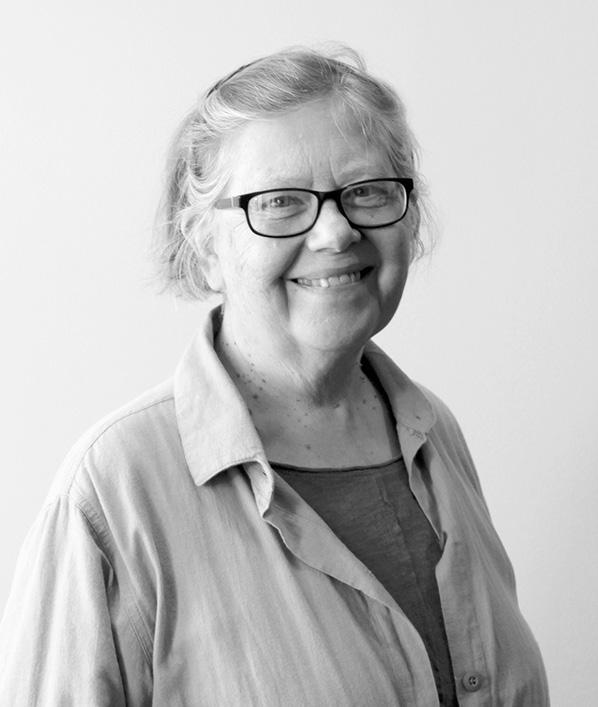
Kitchens shouldn’t be show places
Working with students from their first day of school until they graduate is an incredible privilege.
an
Logistical challenges of shipping off-island
Moving a pellet stove was a family affair
By Barbara FernaldI RELISH the November energy of the island “getting ready” for winter. On the dock and on the roads visitors from tour boats have been replaced with trucks and trailers loaded with traps as fishermen start to bring in their lobster gear. Caretakers have closed most of the summer houses and are racing against the upcoming season to finish their outdoor projects. The floats from the town dock are out of the water and we will use the stairs for the next five months as we come and go.
At home, Bruce has stacked wood and I’ve picked all my carrots and planted garlic. For the first time in years I’ve planted a significant amount of tulip and daffodil bulbs inside my fence. The thought of those green shoots racing each other next spring followed by the early colorful blossoms will keep me smiling all winter.
This is the time of year when I am most apt to clean out closets and drawers. I weed out books, sweaters, and shirts along with toys and toddler
seats outgrown by the grandchildren. I fill a long large bag and a big card board box. Bonanza! I’m getting rid of so much stuff!
Once I get these items over to Northeast Harbor on the ferry, I leave them on the dock while I walk up to the lot to get my car. We all do this when we have too much to carry in one trip. I admit I’ve gone as far as the turn off to Seal Harbor before realizing I forgot to retrieve the rest of my things at the dock.
For as much as visitors ask about how things come out to the island, they rarely ask about how we get rid of things. When our son Cameron was considering buying a pellet stove this year, our friends Dan and Cynthia said he could have theirs for free. All he had to do was to move the 420 pound stove from their Islesford house to his house in Harrison.
Bruce and our son Robin were up for the logistical challenge. With the help of Paul, Richard, and Jeremy, Bruce got the stove on a dolly and out to the bed of his pickup truck. Using the elec tric winch on the town dock he was able to lower the stove onto his lobster boat to take to Northeast Harbor.
Robin and his family were coming from the opposite direction for a weekend visit. They picked up a trailer in Ellsworth and backed it down to the elec tric winch on the dock in Northeast. Robin unloaded the stove from his dad’s boat and lowered it into the trailer. There was even room to park car and trailer in the Joy Road lot on a busy October weekend.
On Sunday, Robin and family made a visit to his brother in Harrison when they dropped off the stove on
lette R s to the editoR
‘Lawyer’s
To the editor
lunch’
Your article on innovation (November issue, Rock Bound, “Will innovation save lobstering?”) brings to mind one I read recently in The Spectator, wherein the history of the barcode was discussed. It required investment and understanding.
The lobster industry as a whole, not just in Maine, has been beset by changes in rules and regulations. In business, it seems something—some body—tries to interfere with the flow of it. (Certainly I’ve seen it, running my business for 54 years.)
Once all the efforts have failed to undercut the logic and reason for the change, there is little choice but to figure out how to get an early edge on accommodating that change.
Let’s look back at the rule to put escape hatches in lobster traps.
At first it was fiercely resisted. “Too expensive.” “Won’t work.” Yet it has been a game changer, helping lobster popula tion growth, and reducing the number of shorts brought to the surface.
Innovation, rather than resistance, might be the better path in the right whale debate, now that all the arguments are exhausted and the lawyers are eating our valued lobster industry’s lunch.
Davies Allan Westport IslandHistory reminders
To the editor: I very much enjoy The Working Waterfront. This morning, I wandered through it and came to the article about the Liberty ships in South Portland. We live in Ferry Village and Bug Light Park is less than a half hour walk from home. I don’t think most of the neighbors understand what this area was like during the early 1940s when 30,000 workers were building the ships. Many of the houses in the village were expanded to accommodate workers. And, I can imagine how many people crowded into homes because of the war effort.
On top of the massive population at the shipyards was the movement of people and materials on a 24 hour, 7 days a week basis. The remnants of rail lines still can be seen in the ruts on Broadway and the greenbelt trail, and abandoned tracks are near some of the oil tanks. Whether or not they know the massive size of the ocean and Liberty ship effort, it is common knowledge. What I have not seen in casual reading, though, is the role Casco Bay and other Maine ports played in the convoys of ships traveling to Europe during the war. Also, the extent of the role played by Maine ports in the invasion of Africa in November 1942.
As I understand it, ships on the East Coast would travel up to Maine to
assemble for the journey. Some might continue to Canada’s Maritime prov inces to shorten the transatlantic trip. I think it’s time for a trip to the Maine Maritime Museum to learn more. Keep up the great work with your publication.
Brian Nickerson South Portland‘Unacceptable’
To the editor:
As a member of and contributor to the Island Institute, I read The Working Waterfront with regularity. While catching up on back issues, I came across Phil Crossman’s “Observer” column in the February/March issue in which he recounted his experiences in Florida.
He referred to his skin as “a complexion that would have made the Aryan Nation proud.” The disturbing attempt at humor evokes white nationalists and Nazis, both of whom aspire to that which Crossman makes cheerful reference.
Such hate groups seek elimina tion of people of color, Jews, Native Americans, and those in the LGBTQ community. They are racists as well as anti-Semitic.
In citing these groups, Mr. Crossman belies a lack of understanding of the horror that emanates from them, currently and in the not-so-distant past.
their way home. It sure helps having family and friends when you’re moving big things off the island, but sometimes you need a barge, as well.
Last week, David Rackliff brought his truck and trailer out to Islesford to deliver trap wire, runners, and a wood chipper. Rather than go home empty on the barge he took back two dead golf carts, an old back hoe, a cast iron kitchen cook stove, and an ice machine. How’s that for planning? He talked to a few different people and then drove right to their house and picked stuff up. That’s a rare service on an island. I hope you feel some of this positive late autumn energy as we enter the season of gratitude. May your de-cluttering go smoothly, if that is your chore, and may we all have peaceful holidays.
Barbara Fernald lives on Islesford (Little Cranberry Island). She may be reached at Fernald244@gmail.com.
That The Working Waterfront allowed this reference to be published is not only disturbing, it is unacceptable.
Kathie Florsheim Providence, R.I.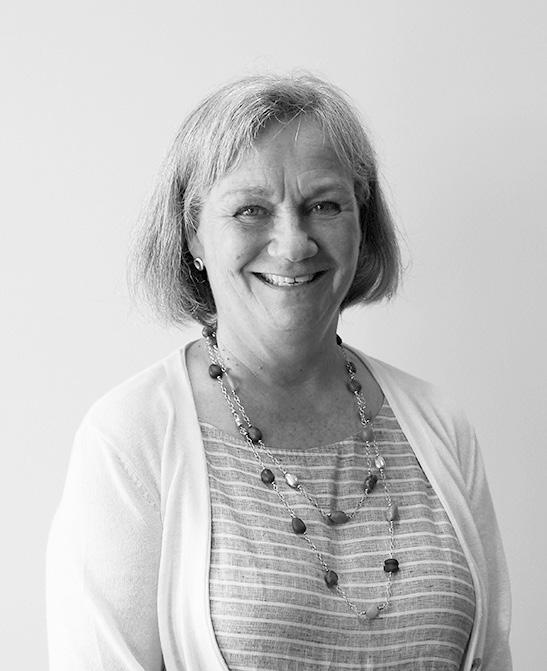
See you in January!
This, the Dec/Jan issue, is the last for 2022 for The Working Waterfront. Our next issue prints in mid-January.
We extend our thanks to you, our readers and supporters, our advertisers, our long-time island columnists, and to our dedicated contributing writers and photogra phers. It’s been another challenging year for the Maine coast and islands, and many of the concerns dominating the news—whale rules, workforce shortages, affordable housing challenges—will remain in our headlines in 2023.
But at this time of thanksgiving, we do well to remember how blessed we are to live in such a place.
See you in January!
The Working Waterfront welcomes letters to the editor. Please send them to editor Tom Groening at tgroening@ islandinstitute.org with LTE in the subject line. Letters should be about 300 words and address issues that the newspaper covers. We also print longer opinion pieces, but please clear them first with the editor.
For as much as visitors ask about how things come out to the island, they rarely ask about how we get rid of things
field notes
Climate symposium centered on conversation Participants engaged with presenters in lively format
By Lisa Millette and Abby RocheWHAT IF a conference for climate practitioners and problem solvers was based on conversation? We answered this question in September with around 140 gathered in Portland to hear—and discuss—climate-related presentations from a wide variety of those working on such issues.
And we learned that it works.
Equal time and focus were given to comments—and sometimes hard questions—prompted by those presentations. The cumulative effort of the Island Institute’s 2022 Climate Symposium was to collaboratively envision a climate-forward Maine.
Two themes: community resilience planning and working waterfront solu tions, permeated the conversations.
Island Fellow Paige Atkinson’s clear voice could be heard talking to a small group about Eastport’s microgrid and its community process. Her voice mixed with Hank Berg’s, who is general manager of Casco Bay Lines which is working to electrify the ferry fleet just blocks from where we gathered.
The urge to connect in one-on-one conversations made for a lively lunch
break with participants and presenters alike launching into shared insights, knowledge, and contact information. So engrossed in conversation were partici pants that it was a challenge getting them back up the stairs for the second session.
That session included presentations on community planning efforts, such as a talk by Allen Kratz and Randy Curtis, facilitators of Peninsula Tomorrow, an inter-local climate resilience group working to support communities in identifying and securing funding for climate mitigation and adaptation.
In a similar vein, Ruth Indrick from Kennebec Estuary Land Trust discussed how a marsh restoration and road protection project in Georgetown has federal, state, and town governments and a regional land trust collaborating.
A screening of the Island Institute’s new Climate of Change film, “Clean Energy Solutions for the Working Waterfront,” was followed by a panel discussion with representatives of three Maine-based businesses: Luke’s Lobster, Community Shellfish, and Maine Electric Boat.
The panelists shared their motiva tions for taking action to reduce their business’s reliance on and use of fossil fuels and asserted that clean energy not
fathominG
only can help create a better future but be a solid business decision.
Wrapping up the day, the Island Institute’s Dr. Susie Arnold facilitated a conversation with Dr. Ayana Johnson. Susie and Ayana, both marine scien tists, talked about changes in fisheries globally, how we must think longterm, and that tradeoffs are necessary to realize a vibrant future.
In a realistic but humor-filled way, they made it clear to the audience that our only choice moving forward is often not the easy or economical choice if we want to realize a more livable and equitable planet.
Two years ago, the Maine Climate Council’s 2020 Maine Won’t Wait publi cation made clear that climate action requires the support and engagement of Maine people. Though delayed by the pandemic, we finally helped move toward that goal by convening 17 presenters to share 14 inven tive coastal climate solutions, with attendees ranging from coastal and island community members to state and regional climate professionals.
It was our hope that by bringing folks together to converse about solutions being tried, and work underway, that
they would leave more empowered and emboldened to act, engage, and lead. And to have hope.
If we did this for 20 people, ten people, or even just one person, the symposium was a success. And we think we did and for more than one person.
As one participant remarked, “The tone of the day was very positive—an approach to climate challenges with creativity and opportunity at the grass roots level.”
As climate practitioners, the sympo sium was an important reminder that conversations are the catalyst for our state’s coastal and island communities’ ability to remain vibrant and sustainable.
Lisa Millette and Abby Roche are community development officers with the Island Institute, publisher of The Working Waterfront. Millette works on business resilience, clean energy, and sea level rise issues. Roche works on sea level rise and community leadership. They may be reached at lmillette@islandinstitute.org and aroche@islandinstitute.org.
Speeding the flow in the workforce pipeline Proactive measures are training new workers
By Kate TagaiVISITORS TO Maine this summer were greeted with signs in storefront windows saying, “Now Hiring,” “Limited Hours due to Staffing Shortages,” or simply “Closed.”
From the County to the coast, anyone who has been living in, working in, or visiting Maine could see the acute lack of workforce. A one-size-fits-all model will not solve the workforce issues, but with local, innovative solutions, we can create a resilient workforce across the state.
The shortage of trained workers is not new, but is at a critical stage in some sectors. Healthcare, early childhood education, hospitality, renewable energy systems and the trades, even municipal offices are feeling a pinch. The reasons are numerous and complex.
We need to be wary of overly simpli fied narratives that direct our thinking toward unhelpful solution such as, “Young people are leaving Maine for better paying jobs.” While Maine is an aging state, from 2016-2019 there was a net increase of 6,613 new Mainers.
The pandemic also played a role in workforce shifts that we are only just now understanding. According to the Maine Center for Economic Policy’s “State of Working Maine 2022” report,
“The
This led to workers shifting careers, asking for benefits, and prioritizing work-life balance to find better value for their work.
Some of these challenges need policy solutions and systems changes with an eye toward equity. But some can be addressed at the local level with creativity and innovation.
ReVision Energy struggled to fill electrician positions to keep up with increasing demand for solar instal lation. So it created an electrical apprenticeship program. The company accepts candidates with just a high school diploma and no prior electrical experience necessary. With four years of on-the-job experience and paid training, candidates can sit for the state journeyman’s exam for licensure.
This is building the workforce it needs. Can other companies create training programs to attract the work force they need?
Similarly, the Mid-Coast School of Technology and the Island Institute along with several other partners are teaming up to create a course to explore the future of electric boats. This tech nology is starting to take off along the coast with incentives for early adopters.
These boats will need to be serviced creating a need for a skilled work force to build, support, and maintain these boats. The school already has a marine technology program and a pipeline of possible students. The Maine Community College System is providing a digital badge for course completion to verify the skills students gain. Other tech centers are finding ways to work with industry profes sionals to create targeted training for the workforce we will need.
There has also been a proliferation of programs that connect willing and able workers with community-based proj ects that need help moving forward. The Institute’s Island Fellows program has a 35-year history of working along the coast. And the program works— 75% of Island Fellows stay in Maine for at least five years after their initial service is finished.
With the growth of similar programs serving different geographies or specific sectors, there are more oppor tunities than ever for small non-profits and municipalities to get some extra help and for people to build profes sional networks and gain experience working in Maine.
Jake Hurner, Maine Service Fellows program coordinator says: “As
communities seek to address a need, it expands opportunities, both volun teer and professional. We are bringing capable people into the Maine workforce, especially sectors in need, training them, and giving them credentials, and lastly incentivizing them to stay after service.”
How do we incorporate new training programs and tap into the wealth of knowledge in the retired workforce to find the workforce we need? By over coming the bias of our stories—that people are too young or too old, that it’s too hard to train people, or they don’t want to work.
If we can foster these and develop other ideas so local organizations have an easier time finding the work force they need in a few years, we’ll no longer see “Closed Due to Workforce Shortage” signs in windows.
Kate Tagai is a senior community development officer with the Island Institute, publisher of The Working Waterfront, focusing on workforce and Island Fellows programs. She can be reached at ktagai@islandinstitute.org.

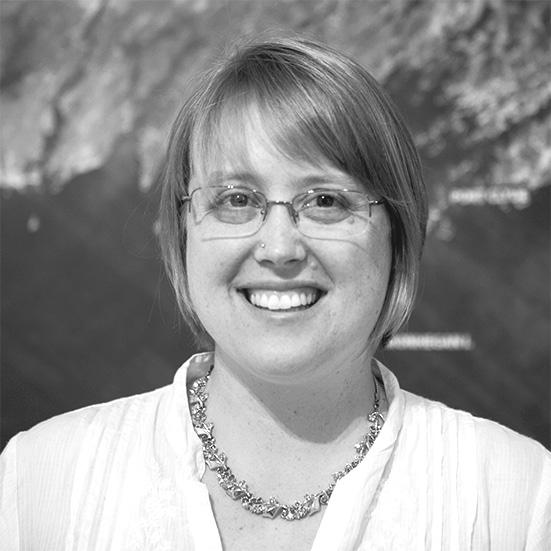

pandemic underscored the general undervaluing of workers.”
siGht
A traditional winter fishery in decline
Smelting shacks disappearing with warming climate
By Kelly PageHISTORICALLY, ice-fishing for smelt has been particularly popular on the frozen tidal rivers and tributaries of Midcoast Maine. A shack could be set up as early as late December among neighbors and friends in a shanty village on the ice.
In variety of materials, these struc tures are known to exhibit the utilitarian ingenuity for which Mainers are so well known. With some minor comforts— a woodstove, some lighting, seating, and perhaps some libations—anglers steadily bait and re-bait several hooks to catch smelt through a hole in the ice as the tide rises and the fish enter the brackish waters that are the gateway to their spawning grounds upstream. Rainbow smelt are an anadromous species, meaning they mature in the ocean and return to freshwater to spawn. They are small and slender and the larger ones are about eight inches in length.
Compared to other species, they are a unique fishery to manage in Maine. They are harvested in three distinct fisheries, have ecological impor tance as a significant food source for both ocean and freshwater fishes, and abundance is subject to extreme
fluctuations caused by factors that are not entirely understood.
While most harvesting is done recre ationally, there is also a commercial opportunity. Either way, the catch is popular as both a food fish and a bait fish. Methods for harvesting depend on the season: during spawning season in the spring fishermen utilize handheld dip nets and, in the fall, it is a hook and line fishery. And then there is the winter ice-fishery.
The image shown here documents the ice fishing activities of Bernard Henderson in January of 1962 and are part of larger collection of color slides, taken by his son Jack, that document his annual wintry pastime throughout the ‘60s.
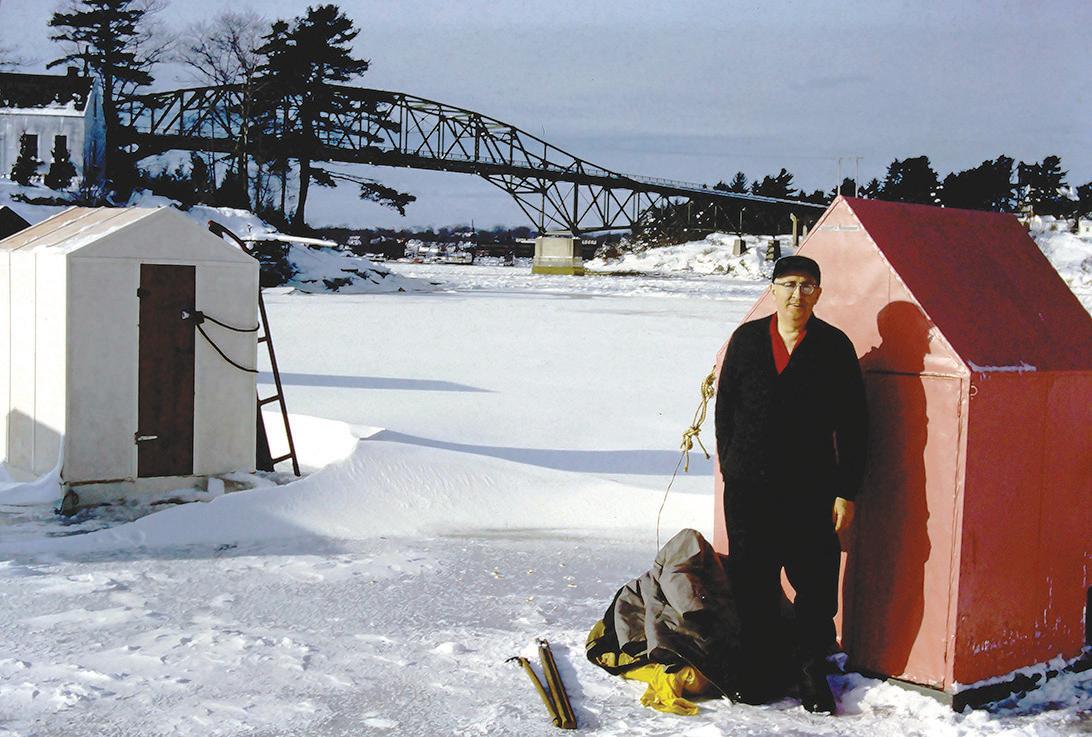
A resident of Phippsburg, he set up his shack on the Sasanoa River between the towns of Woolwich and Arrowsic, a fact solidified by the presence of the Arrowsic Bridge. Much older images in Maine Maritime Museum’s collec tion show dozens of similar shacks on the Medomak River and Back River. None of those images, including Henderson’s, could be replicated today. Due to milder winters and warming water, most traditional smelting spots no longer reliably freeze and those that do are now frozen for shorter periods.
With limited access to solid ice, the renting of smelt camps is the primary way that people continue the tradi tion of ice-fishing for smelt. Five are currently located on the Kennebec and its tributaries in Bowdoinham, Dresden, Pittston, and Randolph.
Although the fish are delicious, such an experience isn’t just about the catch. Personally, a wintertime activity that is technically outdoors, warm, and
involves food is very appealing. The tail-gate like atmosphere and unplug ging with friends isn’t so bad either.
Kelly Page is Collections & Library Services Manager at Maine Maritime Museum. Upcoming exhibits include Women Behind the Lens and SeaChange: Darkness and Light in the Gulf of Maine. Plan your visit at www.mainemaritimemuseum.org
oB se Rve R
The school bus driver is king
Quest for license offered teaching moment
By Phil CrossmanIT’S A WONDER I have a school bus driver’s license at all. On the appointed day, my permit in hand, accompanied by Tiny, a fully licensed driver, I drove the bus to a public works depot for my driving test.
The man in charge there couldn’t have been a greater disappointment. The fact that he was employed at all spoke to orga nized labor run amok. Clearly tenured in some way, his world, where he was in charge, was this DOT lot, circumscribed by a cyclone fence that contained his similarly forbidding attitude. This and his disregard for those hapless individ uals who came to him seeking approval was breathtakingly offensive.
He wore a uniform of sorts, a DOT hat, and assumed a wildly excessive owner ship of his position. The contempt he had for me and for my prospects as a bus driver was undisguised.
Because Tiny was a licensed bus driver, an equal, this fellow assumed a sort of kinship with him, as if they’d seen combat together. He began talking immediately, speaking not to me but only about me, directing his comments to Tiny.
He spoke disparagingly of me, of my intentions that day, of my dimin ished capabilities, of my probable character and of my likely failure. He used only the crudest language all the while making truly awful comparisons between the bus and a woman and between various of the bus’s compo nents and controls and body parts.
As he talked, I drifted, as I’m inclined to do when nothing of interest is holding my attention, and began to imagine what life must be like for whomever it was who shared his life, for I noticed a wedding ring.
By now, I was resigned to this sad encounter ending in failure and my resolve to make the best of it had waned. Thus it was that when he told me to get in the bus and behind the wheel, pretend he was a student, drive down Route 17, take a right on Lakeview, discharge him at a desig nated stop, proceed on to a turnaround, pick him up on the return leg and
deliver him to the point of beginning, I found myself in a less than compliant frame of mind.
Tiny came along. When I reached the designated stop I engaged my flashers, did all the other things correctly and let my make-believe student off. Waiting till he had safely removed himself to the shoulder behind the bus and resisting the urge then to back over him, I drove off, turned around up the road apiece and drove back.
There he was, hands on hips, disapproving, a mighty disappointing imitation of a kid waiting to get on the bus. His eyes met mine, from a hundred feet away, and I watched his face as it became apparent to him I was not going to stop. Keeping an eye on the road with my peripheral vision I maintained eye contact till abreast of him, long enough to memorialize his expression.
Tiny was chuckling but did so with less enthusiasm as we got farther from the instructor. When we got back to the
ought to retrieve him, he could drive. The instructor was walking, clearly not something he did often. Tiny let him on board. He was fuming, sat down behind me and said nothing as we drove back to the lot. There he got out and stood just outside the door at the foot of the steps.
After a few moments he turned and looked up at me and asked with unexpected poignancy, “Why’d you do that for?”
“Because you were behaving like an asshole and I didn’t want you on my bus,” I replied.
He looked as though he might cry. He turned and walked away so sadly that my anger melted away as did my satisfaction in having humiliated him.
A week later I was mailed my license.
Phil Crossman lives on Vinalhaven where he owns the Tidewater Motel. He may be reached at PhilCrossman. VH@gmail.com.
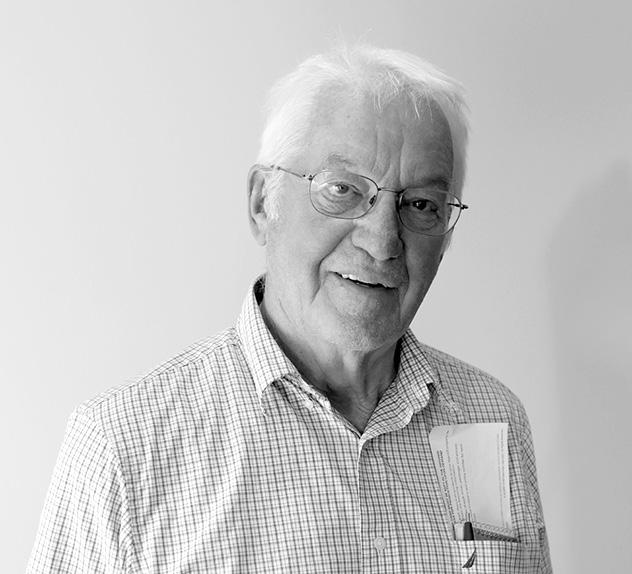
Because Tiny was a licensed bus driver, this fellow assumed a sort of kinship with him, as if they’d seen combat together.

BATH IRON WORKS began building ships in the 1880s; one of its earliest vessels was an iron gunboat, the Machias, built for the U.S. Navy. Now owned by General Dynamics, the shipyard on the Kennebec River routinely receives accolades for its ship-building prowess while drawing the wrath of peace advocates who consider it a part of the country’s war machine.
Over its nearly 130-year existence, Bath Iron Works has also attracted artists. Carroll Thayer Berry (18861978) depicted the shipyard in full war-time mode in the early 1940s (some of his BIW canvases and prints can be found at the Farnsworth and Penobscot Marine museums). More recently, James Stilphin (1945-2006) made numerous drawings, paintings, and technical illustrations of the complex, many of them in the Maine Maritime Museum collection.
Joel Babb first painted BIW in 1977. He had begun drawing outdoors in pen and ink and watercolor, then returning to his studio to paint.
The Iron Works, based on sketches made from the shipyard’s perimeter, presents the construction site under ominous skies, only a few figures visible here and there beneath towering cranes. With a stage set feel, the painting brings to mind views of Roman ruins by Piranesi.
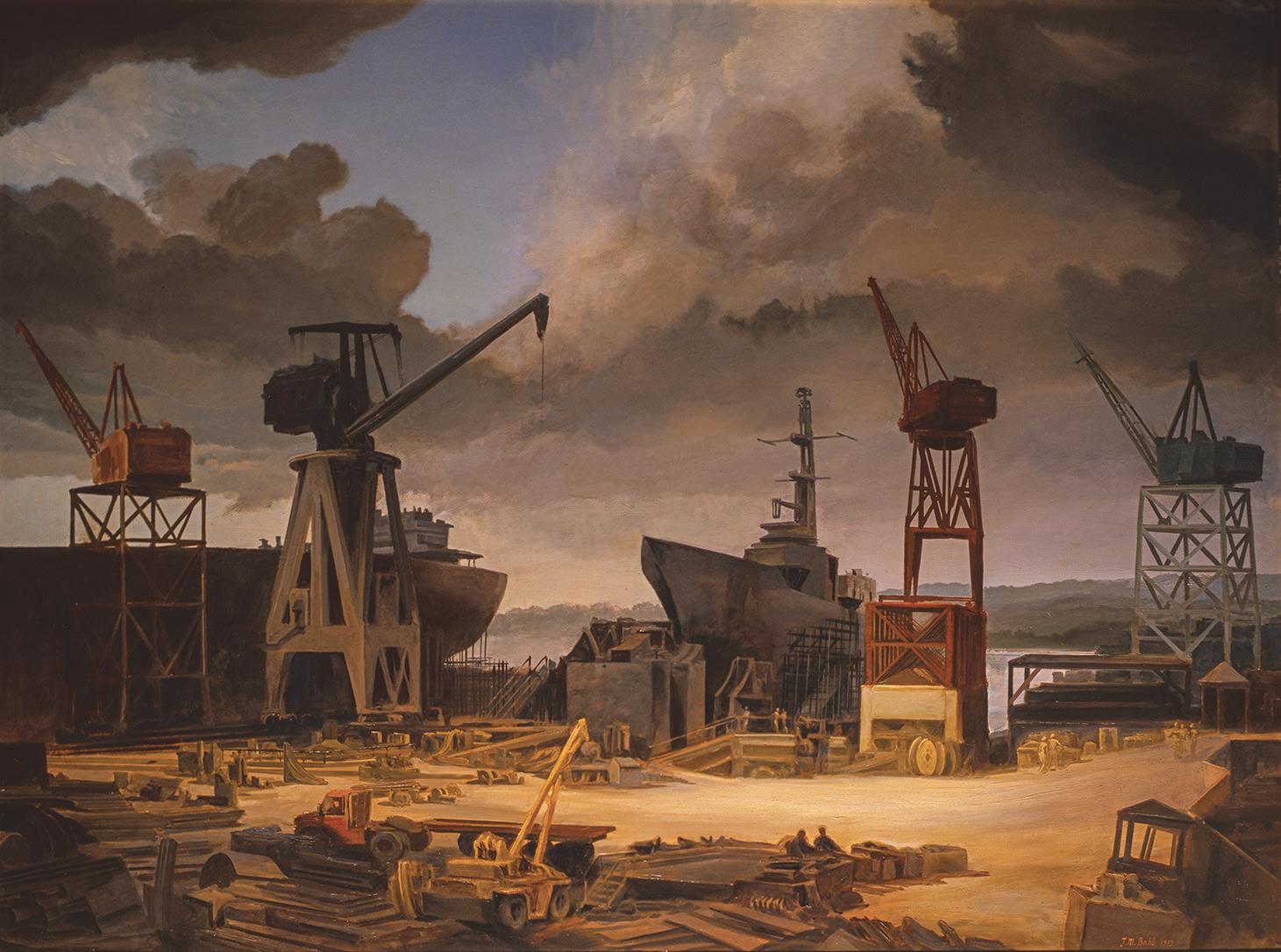
In the early 1990s, Babb returned to the shipyard with a letter of introduction, as it were, from John Ames, owner of Gallery 68 in Belfast, to Duane

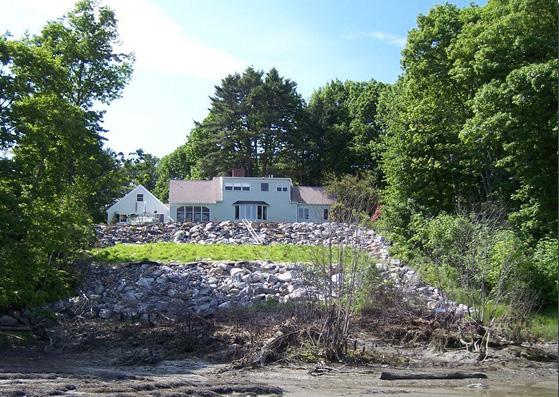
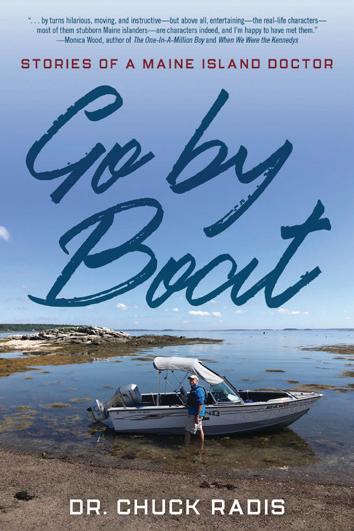
Doc Martin meets All Creatures Great and Small sets the tone for Dr. Chuck Radis’s unique medical practice on the Casco Bay Islands. “With his truelife stories, (Radis) joins the ranks of writing physicians such as Abraham Verghese and the late Richard Selzer.”
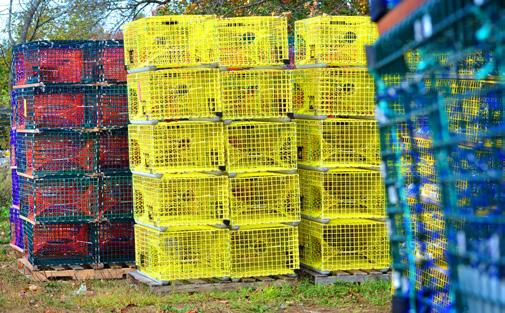

Lloyd Sachs, book critic, Chicago Tribune and Kirkus Reviews
•
•
•
•
eye to famed shipyard
“Buzz” Fitzgerald, BIW’s CEO. Fitzgerald (1939-2002) arranged for the painter to take photos in the yard.
“It was fascinating to learn about the logistics of fabri cation in sections,” Babb recalls, “and… the amazing capacities of the ships to perform when finished.”
Babb ended up painting two canvases from photo graphs taken with a 4-by-5 camera. One of them, the wide-angle Water’s Edge, features an assortment of pieces of steel, “rusted to every possible shade of red orange,” the artist notes. The piles of abstract forms provoked an “industrial fascination.”
The second painting, Leviathans—The Bath Iron Works, is more dramatic, showing the mighty USS Paul Hamilton, an Arleigh Burke-class destroyer, tied to the dock. The view from under the foreshort ened bow of the ship, writes Babb, “suggests the speed and power of the vessel.”
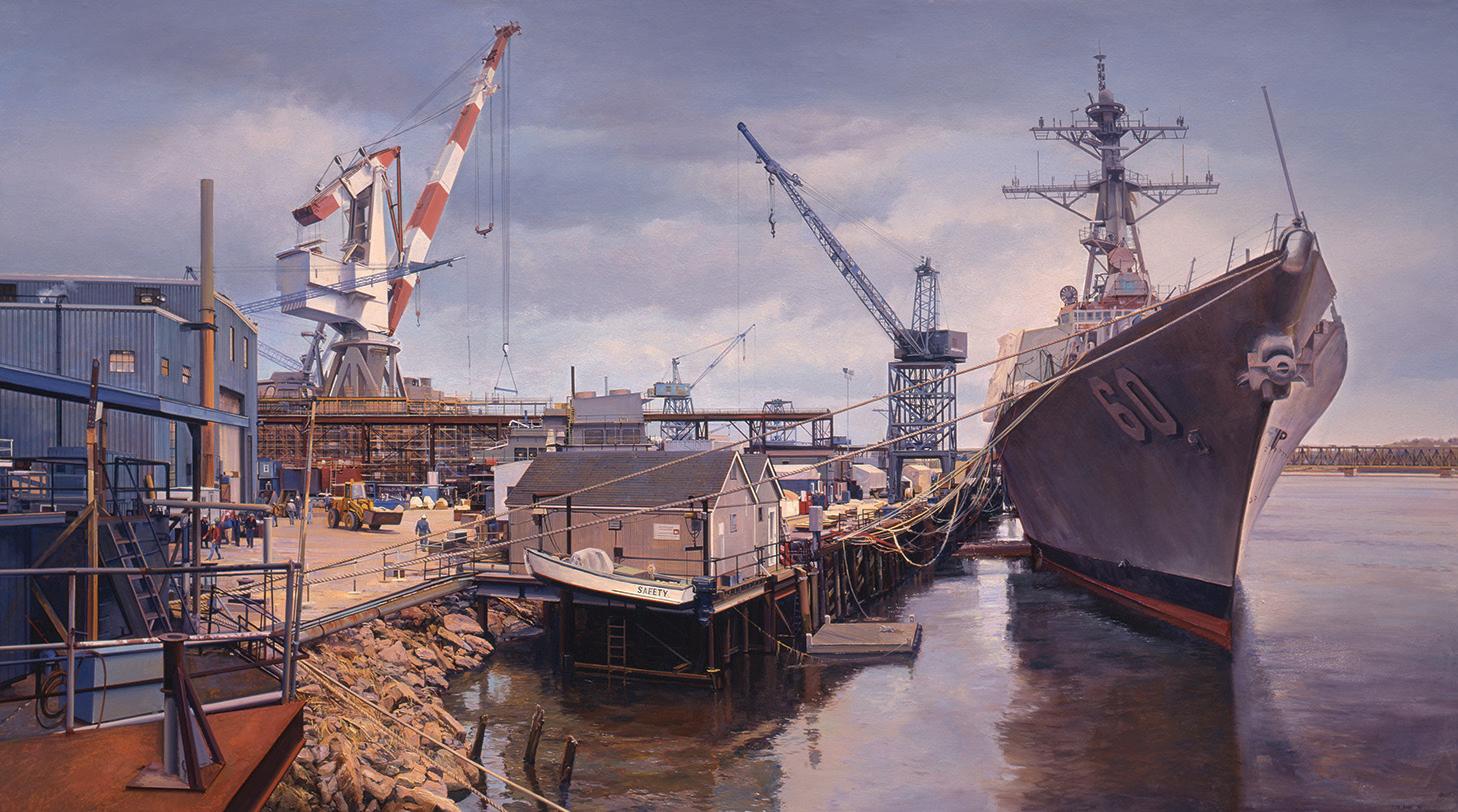
As in his acclaimed Boston cityscapes, Babb is meticulous in rendering the scene. Scanning the canvas, one takes in a multitude of details: the great gray hull, a small suspended “safety” boat, a yellow front-end loader, and all sorts of equipment, scaf folding and buildings. With its distinct orange and white pattern, the giant crane that is visible from Bath might be the squared twin of West Quoddy Head Light.
Today, Leviathans hangs in the Bath Iron Works Center for Advanced Technology at Maine Maritime Academy, a gift of Maine philanthropist Elizabeth Noyce (1930-1996). In her lifetime Noyce created a remarkable collection of Maine art, much of which she bequeathed to Maine museums and other institutions.

Babb would love to return to Bath Iron Works one day and do more paintings: “It’s a fabulous, inspiring subject,” he says. Until then we can admire his iconic image of one of Maine’s most renowned working waterfronts in its full ship-building glory.
Carl Little is the author of Nature & Culture: The Art of Joel Babb (University of New England Press).
